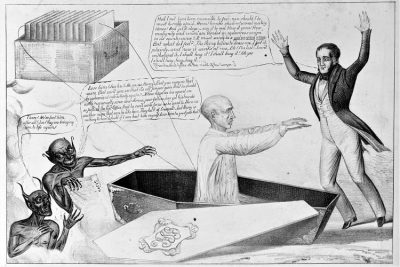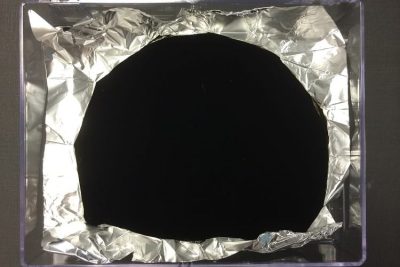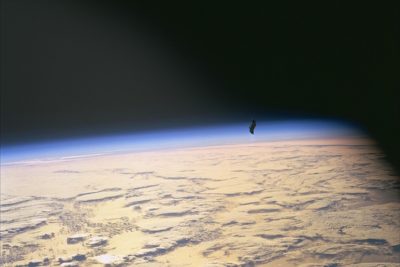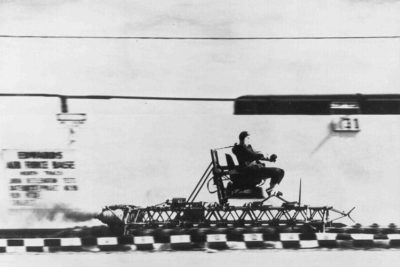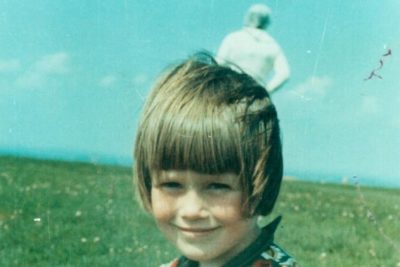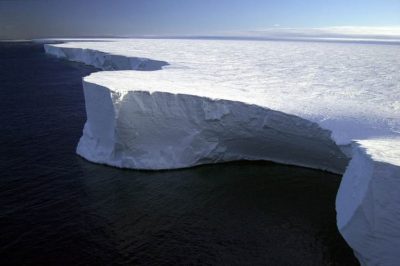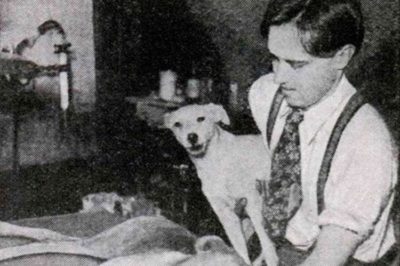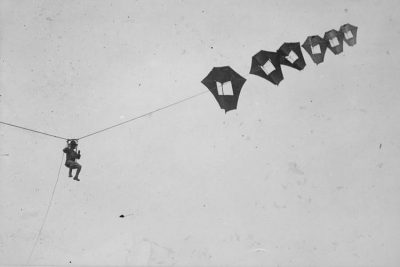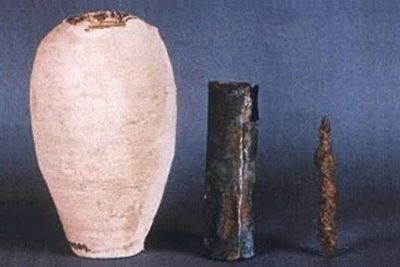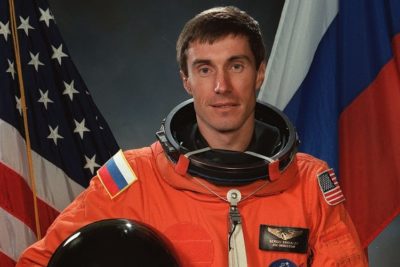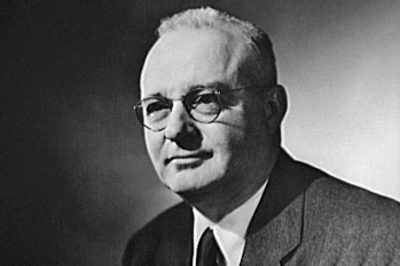The post Harlow’s Experiment on Rhesus Monkeys for Maternal Love and Cognitive Development appeared first on .
]]>
Harlow’s Experiment: Rhesus macaques’ Typical response to cloth mother surrogate in fear test. (Harry Harlow)
Psychologists have always pondered over the subject of love. Love may be categorized and characterized in many ways, one of which is maternal love. Harry Harlow was one of the first psychologists to understand the depth of the behavioural characteristics, in this context, exhibited by young rhesus monkeys. The characteristics studied included ‘isolation’, ‘maternal deprivation’, and then the introduction of a maternal figure which directly made way for a study of ‘dependency’.
The research conducted by Harry Harlow and a few other social psychologists proved fruitful and they could make a leap forward in terms of cognitive analysis under emotional duress. The primary objectives of Harlow’s experiment targeted two hypotheses. The first of these involved the replacement of a biological mother with a surrogate, and the second involved the study of the physiological bond between the ‘mother’ and child.
Psychology of attachment
Attachment is an emotional understanding or a bond created in search of a safe place. There are various reactions to attachment exhibited in the different stages of life, and some forms of attachment need not be reciprocated.
Harry Harlow got curious about the mechanism of attachment that a newborn rhesus monkey exhibited towards its mother. The mothers were undoubtedly responsible for most of the care given to a baby monkey, yet there were some questions raised about the severity of the bond between the mother and child.
After Harlow finished conducting his experiments, it suggested quite the opposite of what psychologists had assumed about the infallible bond between mother and child. Newborn monkeys, although dependent on mothers for nutrition, preferred the comfort given by “touch”. Although separation may have had an adverse effect on the monkeys and made them behave differently, the results displayed were similar to human psychology.
Separation from the mother
To initiate the first stage of his experiment, Harlow found it necessary to separate the newborn rhesus monkeys from their mothers and render them isolated. The time for which these monkeys were isolated varied and this provided different results when they were reintroduced to other monkeys.
Since these monkeys had experienced no attachment since birth, they found it difficult to communicate and establish any form of contact. Instead, the isolation proved to have severe and diverse effects on the monkeys that made them aggressive towards other monkeys. Not only that, but it also resulted in stress-induced behaviour and anxiety, which made them rock back and forth while clutching themselves. One of the most severe effects included self-mutilation, i.e. biting themselves, scratching, and tearing off the hair on their body, thus self-harming themselves repeatedly.
The length of isolation was directly proportional to the severity of damage they inflicted on themselves, including the stress and anxiety. Those in isolation for brief periods of time showed signs of recovery and stable mental conditions, while those who were in isolation longer showed no signs of recovery or mental health restoration.
Concept of surrogacy

Wire and cloth mother surrogates for Rhesus monkey. (Harry Harlow)
While some monkeys were completely separated from their mothers, some were placed in certain spaces where they were deceived to think certain inanimate objects adorned with clothing were the maternal figures. Two inanimate objects were placed in the enclosure, one of them was constructed with a heavy wire mesh and the other was constructed out of wood. The heavy wire mesh object had no clothing or any soft texture covering it, while the wood figure had a covering of terry cloth which provided a soft and warm texture.
There were two instances of this experiment. In the first, they marked both the inanimate figures with food supply (that is, they could dispense milk) that left the newborn rhesus monkeys to rationalize and decide which maternal figure they would opt for. In the second, only the metal figure could dispense milk.
Results from the surrogacy experiment
After extensive research on the behaviour of the monkeys, Harlow observed monkeys resorted to being with the object that had a soft texture. The monkeys felt the need for soft touch and warmth so much that even when the cloth-clad wooden figure had no nutrition to offer as the wire mesh figure did; they opted to spend time with the wooden object. It happened so, that as soon as they were done feeding from the surrogate made of mesh, they would retreat to the cloth surrogate and stay with it for the rest of the day until they required to feed again.
Harlow also conducted an experiment where he introduced new and foreign objects into the enclosure. Since they had never interacted with any other object, the baby monkeys resorted to going into the arms of the cloth ‘mother’ and cuddle for security. In the cloth-clad wooden figure’s presence, the baby monkeys were ready to explore and showed signs of development in mental health. This concluded that while nutrition is important, infants focus more on the emotional bond of attachment in the form of touch.
Criticism on Harlow’s study
The sheer separation that Harlow subjected the monkeys to was considered inhumane and cruel. Not only did he deprive the subjects of their mothers, but he also subjected them to conditions of fear and a constant state of depression. These research studies had very limited value since they were conducted to understand the similarities in the working of a human brain.
Most of the monkeys subjected to these experiments not only displayed aggression towards other monkeys but towards their children too. Neurotic behaviour led them to a point where they inflicted damage to their children and continued doing so in a pattern. The research has proved somewhat fruitful in certain areas related to the cognitive abilities of human infants, but it is debatable whether the benefits reaped out of experimentation justifies the treatment the animals underwent.
For more unusual stories & intriguing news follow STSTW Media on Instagram and Facebook. Also, join our live chat discussion on Twitter.
Do you have a story/photo for us?
We welcome your contribution at [email protected]. Please include your name, city, state, and country.
Fact Analysis:
STSTW Media strives to deliver accurate information through careful research. However, things can go wrong. If you find the above article inaccurate or biased, please let us know at [email protected].
RELATED
The post Harlow’s Experiment on Rhesus Monkeys for Maternal Love and Cognitive Development appeared first on .
]]>The post Green Flash: An Incredible Meteorological Phenomenon That Occurs at Sunset and Sunrise appeared first on .
]]>
The stages of green flash. (Brocken Inaglory/Wikimedia Commons)
“It’s said that once you’ve seen a green flash, you’ll never go wrong in matters of the heart.”
Ever since Jules Verne included the green flash phenomenon in his popular science-fiction novels, myths about it have taken off into the wind. Although, it’s a rarity to witness this phenomenon. If you are lucky or quick, you may be able to see a green flash when the sun is setting. Sometimes, it also occurs when the sun is rising or under specific atmospheric conditions when the sun is high in the sky.
The green flash phenomenon
Pilots, when flying westward, have reported seeing the green flash phenomenon at the time of sunset. This phenomenon usually lasts for one to two seconds, however, Polar explorer Adm. Richard Byrd and his crew while on an expedition to Antarctica in 1929 claimed to have seen it for 35 minutes. These sights are easy to see from a mountaintop and when along the seaside due to an unobstructed vision of the horizon.

The sequence of M-Mir green flash phenomenon. (Ityllux/Wikimedia Commons)
Types of green flashes
According to the American Association for the Advancement of Science, green flashes fall in four categories:
Inferior mirage or I-Mir: It occurs when the water surface is warmer than the air right above it. The inferior mirage flash that you see then is oval and flat and lasts around one to two seconds.
Mock mirage or M-Mir: Mock mirage flashes appear higher up in the sky and when the water or earth surface is colder than the air above it. One will see these green flashes as thin strips coming off the sun. They, like Inferior Images, only last for about one to two seconds.
Subduct flash: Subduct flashes are quite rare and occur due to the atmospheric inversion phenomenon during which the sun appears to take on an hourglass shape. It happens when cold air and moisture get trapped near the ground level by a warm air layer. The green subduct flash then appears at the sun’s top region. It lasts for about 15 seconds.
Green ray: A green ray is a comparatively rarer phenomenon. It usually occurs for a second, right after the sun has set, with a green ray emanating up a few degrees from the green flash up. It only occurs if the inferior mirage, mock mirage, and subduct flash are brighter than normal, and the atmospheric conditions are hazy.
Why the green flash phenomenon occurs?
When the light from the sun reaches the earth, its atmosphere acts as a prism and separates the light into different component colours. The colours with shorter wavelengths, such as blue, green, and violet, have stronger refraction than those with longer wavelengths like orange, red, and yellow.

Green flash above the solar disc. (ESO/G. Lombardi)
As the sun dips below the horizon, the atmosphere absorbs the orange, red, and yellow colours and scatters the blue and violet light colours. That leaves the green light colour, and that is why it is visible when the sun is setting or rising. And due to the layering of the atmosphere caused by temperature differences, the green flashes appear as ripples from high elevation points like mountaintops.
Photographs of the green flash phenomenon
The first colour photograph of the green flash phenomenon is from 1960, and a photographer named D.K.J. O’ Connell took it. At the time, he was at the Vatican Observatory to observe the sunset. Since then, various people have managed to photograph or video this phenomenon.
Green & red rims of the sun
Green rims about the sun are more common than green flashes. They are prominent at the time of sunset and sometimes transform into a green flash and back, but are difficult to see with the naked eye. Using a binocular or telescope for viewing is not advisable as they are harmful to eyes. One may see it safely, though, if projected as a magnified image on paper. The green rim grows fainter and is overpowered by the red rim as the sun touches the horizon.

Green & red rim of the setting sun. (Brocken Inaglory/Wikimedia Commons)
The green flash phenomenon in popular culture
As you might expect with one of the many amazing natural occurrences that have intrigued people over the centuries, the green flash phenomenon has figured prominently in popular culture. The famous science-fiction writer, Jules Verne, mentioned the phenomenon in his 1882 novel, The Green Ray, as well as in his 1905 book, The Lighthouse at the End of the World. Other novels that mention it include Victoria Holt’s Pride of the Peacock from 1976, William S. Burroughs’ Cities of the Red Night from 1981, Carl Hiaasen’s Flush from 2005, and Elizabeth Wein’s Code Name Verity from 2012.
Many musicians have also found the green flash to be inspirational. In 1916, Mario Castelnuovo-Tedesco composed II Raggio Verde, op. 9, a piano solo that expounded upon the emotions arising from seeing the phenomenon. Much later, in 1991, Gavin Bryars debuted his orchestral composition, The Green Ray.
The films that feature the green flash phenomenon or use it as a plot device include Pirates of the Caribbean: At World’s End from 2007 and Blue Lagoon: The Awakening from 2012. It also appears in episode 982 of the Pokémon Sun & Moon anime.
So, if you plan on seeing the green flash. Wait for a clear, cloudless, and haze-free day, and keep your eye on the distant horizon. Even if it doesn’t make you an expert in sentimental matters, you will be in the lead when it comes to the meteorological ones.
Caution: Since looking at it with the naked eye is likely to harm the eyesight, one should be precautious and see it through a regular camera or a video camera lens.
For more unusual stories & intriguing news follow STSTW Media on Instagram and Facebook. Also, join our live chat discussion on Twitter.
Do you have a story/photo for us?
We welcome your contribution at [email protected]. Please include your name, city, state, and country.
Fact Analysis:
STSTW Media strives to deliver accurate information through careful research. However, things can go wrong. If you find the above article inaccurate or biased, please let us know at [email protected].
RELATED
The post Green Flash: An Incredible Meteorological Phenomenon That Occurs at Sunset and Sunrise appeared first on .
]]>The post A Doctor’s Glorious Attempt to Weight Human Soul appeared first on .
]]>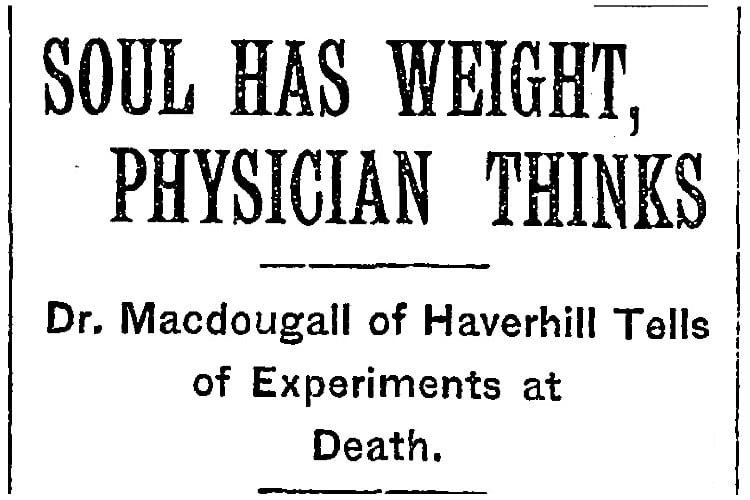
21 Grams Experiment: The New York Times article about the experiment from March 11, 1907. (The New York Times)
IT WAS ON the 10th of April 1901 in Dorchester, Massachusetts when Dr Duncan MacDougall and his team of four other doctors selected six dying patients for an experiment to determine the weight of human soul which leaves the physical body when a man dies. So, logically, a difference of body weight before and after death must be the weight of the soul that departs. Of the six patients picked up by them, five were men and one woman.
The 21 Grams Experiment
The just-about-to-die patient was placed in a specially made Fairbanks weight scales. As the first patient died, the needle of the weighing machine flickered and rested on a lower scale. The loss in weight was estimated to be three-fourths of an ounce or 21 grams.

Dr Duncan MacDougall. (Boston Sunday Post)
A repetition of the experiment with the second patient gave a similar result. Doctors monitoring the experiment made independent observations. Loss of weight in patients was a consistent finding, though the extent of loss varied from one patient to another. The third patient didn’t show any weight loss immediately on demise but showed a minute later. Dr MacDougall blamed the dying man’s phlegmatic temperament for the delayed exit of the soul from the body. The patient, he said, was ‘slow of thought and action’. So, the soul seemingly hung on to him for a minute even after death.
The experiment could only be carried out in four patients. One patient died before being put on weighing scale and in yet another case, the equipment failed. Doctors did their best to ensure that the experiment was conducted fairly and impartially. The weight of air in the lungs, body fluids, water evaporating from the skin; all were taken into account. The weight loss which still remained unaccounted was obviously the weight/mass of the departing soul. Doctors concluded that the average weight loss of each patient was ¾ of an ounce, implying that the human soul weighed 21 grams.
However, no change in weight was observed when Dr MacDougall repeated the experiment on 15 dogs. A physics teacher at Los Angeles, H. Lav. Twing tried the same on mice in 1917. He too didn’t find any change in body weight after their death.
Scepticism and criticism
The scientific world expressed serious doubt on the relevance and authenticity of these experiments. Fellow Massachusetts doctor Augustus P. Clarke said that there is a sudden rise of temperature when death strikes because lungs stop working and their cooling effect on bloodstream goes off. This rise in temperature, he said, caused sweating and loss of moisture by evaporation through the skin surface. Loss of weight upon death, he argued, was because of such sweating and evaporation, and not because of the soul leaving the dead. According to him, the experiment failed with dogs because dogs cool their body by panting and not by sweating. Dr MacDougall countered by saying that death stops blood circulation in the body, so the question of blood rushing to the skin and raising body temperature simply doesn’t arise.
The debate on the subject continued unabated with many questioning the intent, ethics and veracity of such morbid experiments. ‘Which family would offer their dying member as a Guinea pig for scientific study?’ posed sceptics. Experiments failing with animal species implied that animals don’t have a soul. This inference too was questioned.
Though Dr MacDougall announced that he would try to photograph the soul in subsequent experiments, his stand on nature of soul remained ambiguous. He conceded that his experiments were not conclusive and that more such experiments must be conducted to know the truth. That apart, an assumption based on only 4 out of chosen 6 patients couldn’t be rated as a significant finding. The exact time of the patient’s death too couldn’t have been precise and accurate.
MacDouglass passed away in 1920 without any further breakthrough in weighing the human soul leaving a maxim that the human soul weighs 21 grams.
Enjoyed this article? Also, check out “The Rise and Fall of the Victorian Era Creepy Therapeutic Treatment Called Electric Bath“.
Do you have a story for us?
We welcome your contribution at [email protected]. Please include your name, city, state, and country.
Fact Analysis:
STSTW Media strives to deliver accurate information through careful research. However, things can go wrong. If you find the above article inaccurate or biased, please let us know at [email protected].
RELATED
The post A Doctor’s Glorious Attempt to Weight Human Soul appeared first on .
]]>The post Sergei Krikalev: The Time Travelling Cosmonaut appeared first on .
]]>
Sergei Krikalev. (NASA)
We have all read or watched movies about time-travellers; people who travel back in time or into the future by some unexplainable medium or device. For example, various types of ‘Time Machines’ as famous, generic mechanisms which are present in many of these stories. These are either fiction or conspiracy theories of course, but there is another type of time travelling which is very much real. Although it happens in a very much shorter space of time.

A famous time travelling conspiracy photo from the 1940’s (Note the man on the right with futuristic sunglasses, camera and attire.) (www.virtualmuseum.ca)
Time dilation
The factual type of time travel is through the concept of time dilation – a difference of elapsed time between two events. It is an extremely hard thing for us mortals to get our head around – that is, people who are not well versed in the fields of physics and astronomy for instance. This is because Einstein’s theory of relativity plays a part.
In short, when astronauts orbit Earth they are noticeably further from the planet than those who reside on the surface. This means their gravitational time dilation is less because gravity is less and that everything they do is faster (even the clocks run slower on space stations). When they return to Earth they are literally travelling back in time. It is by no means a large number because the time dilation is caused by gravity which is a weak force. (As forces of attraction in the Universe goes). It has been calculated that Russian astronaut Sergei Konstantinovich Krikalev has time travelled the most. Here is a brief summary of how he did so.
Early life of Sergei Krikalev
Sergei Konstantinovich Krikalev was born in Leningrad (what is now St. Petersburg) during the USSR in 1958. He graduated with a mechanical engineering degree and gained employment for a company called NPO Energia who organized manned space flights. Part of his primary work was testing equipment and developing operations. This included a rescue operation when the Salyut 7 Space station had problems in 1985. He would later achieve his dream of becoming a cosmonaut in 1985 and joined the Buran program however it was later cancelled. It would not be long until he would take part in a successful mission.
Missions
In 1988 he was selected for a long-duration flight to join the Mir space station. Soyuz TM-7 launched on November 26 with Krikalev as flight engineer. The team carried out maintenance and also added new equipment to Mir in what is known as an EVA (Extravehicular activity) – moving outside a spacecraft. They also played a Pink Floyd cassette they brought along which is said to be the first music played in space. Soyuz successfully returned to Earth 27, 1989. This would be Krikalev’s first successful mission. In 1991 he returned to Mir and then again in 1992.
His defining mission would come in April 1993 when he was named a Prime Mission Specialist for the STS-60 Discovery. It would be the first joint US/Russian mission and he would partake in many more after this, travelling regularly to the Johnson Space Center in Houston, Texas.
To keep himself amused on his missions Sergei spoke to many amateur radio broadcasters (AKA Ham Radios) as he was something of an enthusiast himself. One such relationship was with Margaret Iaquinto who was a graduate of Boston University in Russian Language. Later in life she moved to Australia becoming a teacher and operated a Ham Radio from her back garden. At one stage they communicated with each other every day for one year, Iaquinto let her children and students speak to Krikalev and other astronauts on board. From Australia they would see the light in the sky from the MIR Space Station. They would later meet in Houston in 1994 at the bequest of Sergei.
She kept him abreast of the situation during the collapse of the Soviet Union as he was in space during the dissolution in 1991. For that reason, he is known by many Russians as the last citizen of the Soviet Union.
Another famous mission was the STS-88 Endeavour launched in 1998. It would be the maiden mission to the ISS (International Space Station) where Krikalev would later live as part of Expedition-1 Crew. They were the first crew to occupy the ISS station.
Record-breaking
2005 would be a record breaking year. Aboard a Soyuz rocket, Krikalev would overtake the record for the total time spent in space. It was formerly held by fellow Russian Sergei Avdeyev with 747.5 days but Krikalev made it to over 803. This is why Sergei Krikalev also holds the record for time-travelling.
“If you add up the accumulated speed cosmonaut Sergei Krikalev has traveled in space – the most of any human with a total time spent in orbit of 803 days 9 hours and 39 minutes – he has actually time-traveled into his own future by 0.02 seconds.”
He would return to Earth with many accolades including: Hero of the Soviet Union, the Order of Lenin, L’Officier de la Legion d’Honneur, Hero of Russia and Space Flight Medals. Moreover, he has an Asteroid 7469 Krikalev named after him.
Although having the record for time dilation, the Russian is third in the list of most time travelled in space behind Gennady Padalka and Yuri Malenchenko. (At STSTW Media we are still researching why their time dilation is not higher but we believe it is to do with speed travelled. If you know please leave a comment or send us an e-mail.)
Life after space
After he retired from space missions Sergei Krikalev decided to pass on his wisdom to younger astronauts becoming the administrator of the Yuri Gagarin Cosmonauts Training Center at RSC Energia, a spacecraft manufacturer. He was made an honourary citizen of Saint Petersburg to add to his many accolades and was selected to be one of the Russian flag carriers at the 2014 Sochi Winter Olympics. He looks back on his career and life with fondness as well as togetherness for the human race as a whole.
“The further you travel, the more you feel part of a big group of people. Travelling outside of Earth, I get this feeling of being part of mankind. So we do not represent only our countries in space; it’s an international adventure. It’s similar to what sailors feel when they are out at sea – if they meet another ship, they probably feel some kind of brotherhood; it doesn’t matter what flag if on the ship. The sea is a hostile environment, so people help each other to fight with nature.”
The future of time travel
While 0.02 seems inconsequential, remember that we are at the very beginning of space travel. In the future this effect will surely enlarge as technology increases and spacecraft can travel faster. This has been proven on space stations and satellites.
“…after 6 months on the ISS, an astronaut has aged less than those on Earth, but only by about 0.007 seconds“. The effects would be greater if we could get the ISS to orbit Earth at near the speed of light (approximately 300,000 km/s), instead of the actual speed of about 7.7 km/s.
There is still much to be achieved in this field and cosmonauts like Sergei Krikalev are pioneers, paving the way for future developments. Dr. J. Richard Gott, a Princeton astrophysicist makes an excellent comparison by stating that,“The astronauts are the Lindberghs of time travel”.
Enjoyed this article? You would also love “The Philadelphia Experiment: When an American Navy ship Supposedly Teleported“.
Fact Analysis:
STSTW Media strives to deliver accurate information through careful research. However, things can go wrong. If you find the above article inaccurate or biased, please let us know at [email protected].
RELATED
The post Sergei Krikalev: The Time Travelling Cosmonaut appeared first on .
]]>The post After the Discovery of X-Rays Came N-Rays – But Do They Actually Exist? appeared first on .
]]>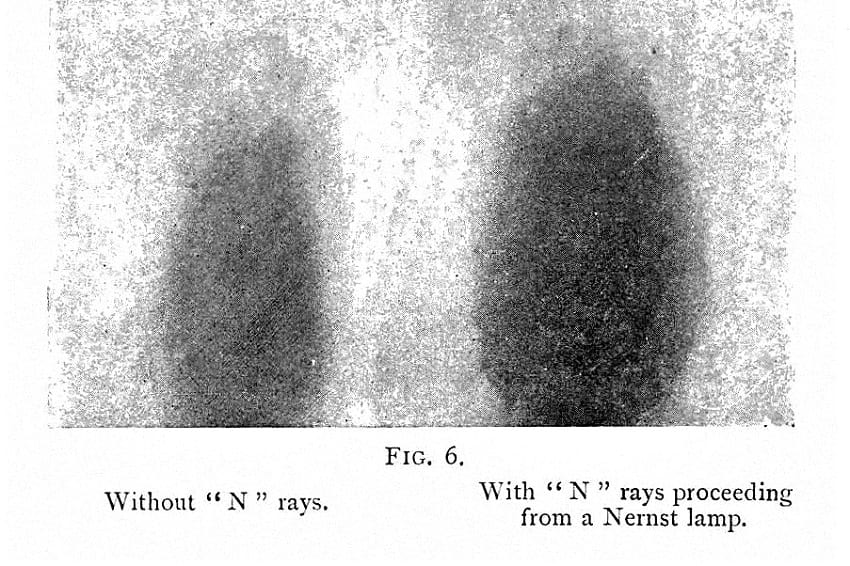 N-Ray or No Rays
N-Ray or No Rays
The Parrot and the Carrot we may easily confound,
They’re very much alike in looks and similar in sound.
We recognize the Parrot by his clear articulation,
For Carrots are unable to engage in conversation
–Robert W. Wood
This rhyme was written by a very talented American scientist called Robert W. Wood– a pioneer or optics, infrared and ultraviolet photography. In 1904 he travelled to Nancy, France, after hearing reports relating to the discovery of a new form of electromagnetic radiation – similar to the X-Ray – call the N-Ray. He wanted to see the new rays for himself as he could not create them in his own laboratory.

Prosper-René Blondlot, circa 1910. (Wikimedia Commons)
Intro
In 1895, X-Rays were a momentous discovery in the field of medical science. Their aptitude in radiation therapy, security, as well as the discovery of broken bones and other anomalies created many breakthroughs. Their ability to pass through soft elements to characterise more solid forms was something extremely useful especially in the modern world. Wilhelm Conrad Rontgen was the German who discovered the X-Ray and many scientists tried to replicate his success by studying their conditions and uses. A neighboring Frenchman Prosper-Rene Blondlot believed that he had found a similar type of radiation in 1903 with the self-named N-Ray after his birthplace of Nancy in France.
Biography
Blondlot worked at the University of Nancy in north-east France his whole life. After being inducted into the French Academy of Sciences, his piece de resistance would during the unearthing of X-Rays in which he attempted to polarise – meaning he looked to change or focus the direction of their energy beams. Instead he came across what he thought was a new type of radiation.
Many more types of radiation were being discovered at the beginning of the 20th century such as Alpha, Beta and Gamma rays so another was not disputed especially from a respected scientist. Other students of science were trying to find more properties for the X-Rays themselves but Blondlot went one further by supposedly finding the new ray. Because of his previous accomplishments the scientific community was quick to believe him. The university was a hierarchal system which worked on good relations meaning younger students were quick to agree with their lecturer and mentor.
Discovery of N-Rays and dispute
Blondlot realised that when the N-Rays shone through a prism – a transparent optical element with flat sides refracting lights – they cut out visible light. In this case, he used an aluminium prism. Morever, electrical sparks would grow brighter when exposed to the radition and heat increased the volume of the rays. The Frenchman published his work in Nature – one of the world’s most respected scientific journals. He also reported his findings to the French Academy of Sciences. Hundreds of scientists purported to see the rays also, but the strange thing was that hundreds claimed they could not. The scientific world was in a schism. Blondlot’s response to this was that their eyes were simply not sensitive enough to pick up the mysterious rays.
Blondlot used various techniques to pick out the rays of light. These included variations within electrical sparks and phosphorescent screens. They were reported to go through most substances but not water. Saltwater would naturally emit them however, so the lengths and breadths of the oceans could transmit N-Rays according to Blondlot. He deemed that they could be emitted by elements like fire and the sun. A colleague of his at the University of Nancy, Augustin Charpentier, added to the importance and potential of the rays stating that they could be emitted by animals such as humans, from our nerves and muscles.

Robert Williams Wood. (Wikimedia Commons)
Investigation
It was the afore-mentioned publication Nature who sent the afore-mentioned scientist – Robert W. Wood – to investigate the discovery. Wood was a respected physicist but also an eccentric character. It was said he would go to his local park and confuse strangers by spitting into ponds with a sodium solution meaning the water would burst into yellow flames. But he was one such person who could not detect said N-Rays nor even a whiff of them in private studies. He worked and taught in Baltimore, Maryland in the US yet he flew to France as soon as possible to examine the rays first hand.
Wood and Blondlot met and although being fluent in French as well as German (German being the global language of physics) Wood did not admit he spoke French. This was so he could eavesdrop on the conversations between Blondlot and his assistants. The Frenchman’s main method of observing the N-Ray spectrum was through an aluminum prism. Wood could not see any deviations so when the room went dark for a test the American removed the prism. Blondlot’s readings were exactly the same– as if revised – and so he was caught to be lying.
Public Response
Wood immediately sent a letter to Nature mentioning that the N-Rays were all in the imagination of Blondlot – perhaps being generous as to not call him a fraud straight away. Soon, the scientific community went against Blondlot and his scientific career never recovered. He continued to believe in and promote the existence of N-Rays but allowed no more tests from outsiders. His excuse was that Wood’s imperfect German meant that there were several issues with understanding. It was said he continued to lecture at the University of Nancy and study the N-Rays until his death. Others say he went mad.
Wood did not mention Blondlot’s name in the article but it was clear to those familiar with science who the article was about.
“After spending three hours or more in witnessing various experiments, I am not only unable to report a single observation which appeared to indicate the existence of the rays, but left with a very firm conviction that the few experimenters who have obtained positive results have been in some way deluded,”
No-one will know whether Blondlot was mad, a fraud, or simply mistaken with his findings. Here is a case however which shows the immense strength in having a scientific community who can detect real science or counterfeits. N-Rays were a myth that was put to bed very quickly as opposed to the past, when several fake sciences could be believed for centuries before being debunked. We live in more enlightened times now, thankfully.
Enjoyed this article? Also, check out “Thomas Midgley Jr. – The Scientist Who Almost Destroyed the Planet without Knowing“.
Fact Analysis:
STSTW Media strives to deliver accurate information through careful research. However, things can go wrong. If you find the above article inaccurate or biased, please let us know at [email protected].
RELATED
The post After the Discovery of X-Rays Came N-Rays – But Do They Actually Exist? appeared first on .
]]>The post Can a Spider Spin Webs on Acid and Other Drugs? appeared first on .
]]>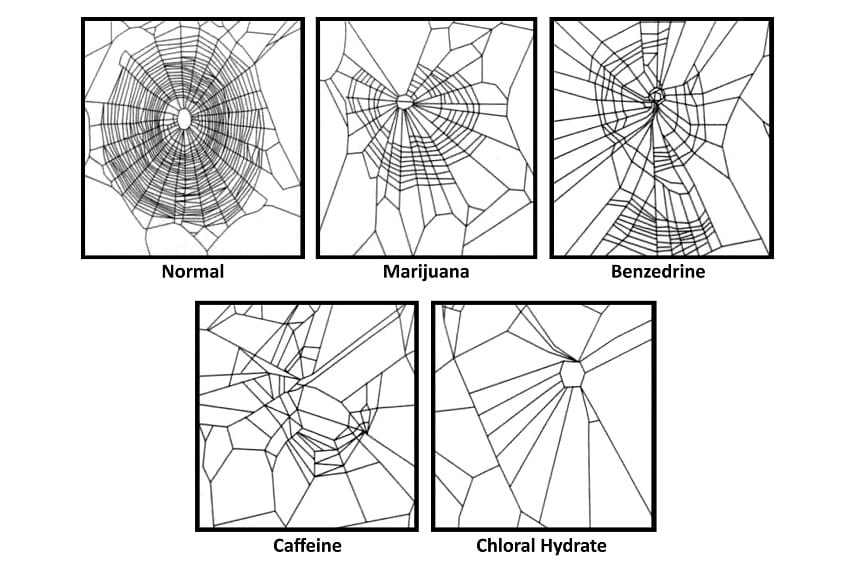
Spider on drugs: A spiders ability to build web under the influence of various substances. (NASA)
Spiders are the largest group in the arachnid class. All spiders have eight legs, six to eight eyes, spin silk and can be found in six of the seven continents. It is only Antarctica where they are not native but you can guarantee that some scientist has one in a terrarium either for experimentation, or to cover all seven continents. Or both. These organisms have successfully adapted to a wide range of habitats. Those who study them have been trying to gain a deeper understanding and their newly mapped genomes may be the key to unlocking many of the spider’s secrets. A major reason why animals are studied is to find out what would happen if humans were exposed to the same circumstances. Spiders and insects are becoming a gateway for this as testing on larger animals such as mice is being prohibited more and more due to law restrictions based on cruelty.
Webbing information
In order to see how the creatures would react to the narcotics, the spiders were covered in the chemicals to see how their behavior would change and their webs would form. Spider silk is an incredible material made of super-strong protein chains. Millions of years of fierce evolution has unearthed a ruthless animal let alone killing-machine since their genetic emergence from crabs. Their silk is stronger than steel and incredibly tensile beginning internally as a soluble liquid-like form before leaving the spider as a hardened fiber. Scientists are continually trying to source the material in the hope of replicating it. The spun material from the spidery spinnerets would be an extreme money-spinner for companies also.
Spider on drugs: The experiment and results
Hans Peters – A Germany scientist – created a system to record Spiders spinning webs on various substances via their sugar water, most of which illicit. It was more to see how the spiders would react as to any scientific predisposition. These photos became famous none-the-less which gained the attention of some in the scientific sphere. However, it was Peter’s pharmacologist Peter Witt who did most of the practical elements as Peters himself, could ill afford to stay up late and perhaps lost hope in the investigation. Witt hoped the drugs would make the spiders lose track of time anyway as they normally only build webs at night. Hans Peters grew disillusioned with the experiment but Witt was fascinated, making it his primary work.
Science has come on leaps and bounds since this experiment in 1948. Back then they gave spiders samples of urine from people suffering from schizophrenia thinking it would have an effect, which it ultimately did not. In terms of the drugs sprayed, the results are not as obvious as they look as scientific knowledge now denotes that what chemicals do to an arachnid’s brain is likely not the same as humans. LSD, marijuana, benzedrine, sleeping pills and caffeine were tested, and while the webs show that caffeine is the most dangerous of the drugs tested, it may not be the same for humans. It is possibly just an alteration to a spider’s muscle memory as opposed to changes in the brain. Although it is now widely accepted, the dangers of over-caffeinating.
“For instance, naturally occurring amounts of caffeine can kill animals that need a hormone called Octopamine—a category that includes spiders, but not humans. That might help explain why caffeine devastates spider web production.”
One thing the findings definitely show is that for all animals, and for all chemicals, moderation is key.
Enjoyed this article? Also, check out “Luigi Galvani: The Man Who Fuelled the Idea of Re-Animating Human Corpses“.
Fact Analysis:
STSTW Media strives to deliver accurate information through careful research. However, things can go wrong. If you find the above article inaccurate or biased, please let us know at [email protected].
RELATED
The post Can a Spider Spin Webs on Acid and Other Drugs? appeared first on .
]]>The post With Alternative Systems in the Pipeline, Global Positioning System, GPS is Here to Stay appeared first on .
]]>
A driver using a global positioning system through his phone. (THE COLLAB. / Pexels)
The day: September 1, 1983. A Korean Air Lines Flight 007, taking off from New York City to Seoul, drifts 200 miles away from the flightpath, towards a sensitive Soviet military installation in the Kamchatka Peninsula. Soviet Pilots detect these intrusions and jump into action. KAL 007, the passenger plane, is mistaken for the spy plane and shot down. If only the KAL 007 had the Global Positioning System (GPS), then used exclusively by the U.S. Military, it would have noted the drift and mended direction. And, the tragedy could have been averted. Lest such navigational lapses repeat, America – the owner of GPS, then opened this facility for civil use all over the world.
Backed by solar power and batteries
GPS was conceived as stealth technology for the reconnaissance and surveillance work of the U.S. Defense Forces. Its formation began with the launching of the first GPS satellite into earth’s orbit in 1978. By the year 1994, it became a group of 24 satellites. Presently there are 32 satellites. Each weighs about 2000 pounds and carries a 17 feet expanse of solar panels. Functional life of a satellite is about 10 years and the duds are replaced with new functional units. Powered by solar energy, and on-board back-up batteries, each satellite is able to transmit 50 Watts or less of electromagnetic power. This generates 2 low-power radio signals which travel by the line-of-sight. That means, barring high-density solids like concrete buildings and mountains, the signals pass through all other mediums (plastic, glass, clouds etc.).
Satellite information is decoded by GPS devices
The signal given out by the Satellites is loaded with 3 types of information:
1. Pseudorandom code: It is an identification of the particular satellite which is sending the information. The satellite page on the GPS device being used on earth gives a clear indication of the sender satellite.
2. Ephemeris data: This shows update on functional status and the orbital-position of the satellite.
3. Almanac data: It has orbital and state (health) information of every satellite in the constellation. The GPS almanac also includes necessary data to correct for distortion caused by the ionosphere.
Geographical positioning is determined by trilateration
Each satellite, circumnavigating 12,500 miles (20,117 kilometers) away in space, makes 2 rotations of the earth in a day. The satellite demarcates a circular zone on the GPS device as the area of the user’s probable location. Circular zones, as indicated by a 2nd and 3rd satellites would naturally intersect, and the point of intersection reveals the geographical position in a narrowed down range. Even a 4th satellite may chip in with yet another intersection. More the number of intersections, more pinpoint and accurate the location of the GPS user. If still more number of satellites come in the loop, even 3-D position (longitude, altitude and latitude) can be assessed. This methodology of zeroing on to the exact geographical position is called trilateration.
Notably, GPS device, like smartphones, can only collect data transmitted by the satellites. It can’t send data back to the Satellite, except when it syncs with cell phone towers and internet for better output. The device can, as an exception, send such synced information to the satellite systems.
Capable of doing lot more than just positioning
GPS device doesn’t just stop at finding the subject location. It also reveals the distance to a projected destination, how long it may take to reach there, the speed of the subject, topography of the area being travelled, time of sunrise and sunset, and much more. Thanks to technological up-gradation, more and more sensitive receivers are now available. These have enhanced GPS reception in a big way. Some adjutant systems too, like WAAS (Wide Area Augmentation system) and DGPS (differential GPS), have ensured better results. WAAS accounts for atmospheric variations and the geographical position is homed in by more than 3 meters. The correction ensured by DGPS, (used by the U.S. Coast Guard), is in the range of 1-3 meters. With further research and development, tracking of 20 or more satellites could be a possibility. More the number of satellites engaged, better theresults. However, starting from 2018 the U.S. Coast Guard has slowly started to discontinue the use of DGPS due to the increase in the accuracy of GPS technology.
Can the reading on GPS device go wrong?
Yes. Satellites, apart from expiring in 10-year time, can also be obstructed temporarily. Like, conditions in troposphere (the atmosphere 6-20 KM above the sea level), and ionosphere (1000 KM above the sea level) may cause signals to move slowly. Signals may also bump off some high-density solid on earth and lead to error in positioning.
What if America asserts its ownership of GPS?
By and large, GPS is a freebie from America. That, ironically, is its plus as well as minus. Plus, because it is being used extensively and intensively all over the world. Minus, because nothing really comes for free. On all good things, there is a price tag, overt or covert. Of the two levels of GPS services available, Standard Positioning Service (SPS) is free for use worldwide. The other level, Precise Positioning Service (PPS), is not for all. Its use is limited to American Armed forces, federal agencies and some selected nations. What if America decides to restrict worldwide use of GPS? It would indeed rattle the world, overly dependent on GPS in many ways. Is the world ready to face this eventuality?
World moving in the direction of alternatives
Yes, the world seems to be geared up for GPS road-block. Russia has built its own satellite cluster in space, called GLONASS (Global Navigation Satellite System). Galileo is another system, owned by the European Space Agency. China is busy expanding BeiDou to increase its global coverage. Most gadgets are receptive to GLONASS and GPS, and to some extent to BeiDou. The Indian counterpart is IRNSS (Indian Regional Navigation Satellite System), also called NAVIC. Nevertheless, GPS remains the most widely used system as of now.
In spite of competition, GPS holds ground
Blaine Curcio, founder of Orbital Gateway Consulting, a satellite market research firm opines that the satellite navigation services of the future will divide the world into two camps. One: pro-China. Two: pro-US. The pro-China lobby would include nations sceptical of the service provided by the U.S. and the European Union.
Is there a pressing need for alternative navigation systems?
No, feels Curcio. Rightly so, for more reasons than one. According to Brian Weeden, director of the Secure World Foundation states that- the biggest merit of GPS is its consistency and reliability. Further, he says, establishing a global satellite navigation system and making it trust worthy, like GPS, is a hard job. Add to this the fact that BeiDou would be a two-way transmission. Satellite to device on earth, and from device to the satellite. This 2-way track would need more of spectrum bandwidth and the accuracy of positioning could be compromised.
What has ostensibly annoyed the Western countries is the probable role of BeiDou in China’s plan for a smaller & smarter military. It could be used for precision-guided missiles, reconnaissance, and short messages (the facility lacking with GPS). Doubtless, it would add to the military might of China significantly. Not surprising, considering GPS too was developed for the U.S. Military, and used for the first time in the Gulf War.
Keen contest among the nations of the world would indeed change the present day scenario of the global positioning systems. But it won’t come a day too soon. And GPS is likely to hold ground for pretty long.
Enjoyed this article? Also, check out “Yellow Concrete Arrows Are the Last Reminders of Transcontinental Airway System“.
Fact Analysis:
STSTW Media strives to deliver accurate information through careful research. However, things can go wrong. If you find the above article inaccurate or biased, please let us know at [email protected].
RELATED
The post With Alternative Systems in the Pipeline, Global Positioning System, GPS is Here to Stay appeared first on .
]]>The post Understanding Day Length Fluctuations – What They Are and What Causes Them appeared first on .
]]>
A graph showing deviation of day length. (Ⅱ Ⅶ Ⅻ / Wikimedia Commons)
Most of us have learned in science class that a day consists of 24 hours. The time taken for Earth to turn once its axis is 23 hours and 56 minutes and 4.0916 seconds, and this can fluctuate too according to how the Earth’s atmospheric and oceanic processes affect its rotation.
Understanding day length fluctuations
The Earth takes to complete one rotation around its axis, but the length of time for this rotation can vary. So, while we think of a day as having 24 hours, this isn’t strictly the case. Some 300 million ago, the spin of the Earth was faster than it is now. If you took a time machine back, you would encounter days that were 21 hours long.
The Earth’s rotation has been gradually slowing over the millennia, and, consequently, the length of day has increased. However, there are other factors like climate, winds, oceanic processes, and atmospheric pressure systems that also affect the rotation of Earth on its axis. According to researchers, winds blowing against mountain ranges can be so strong that they affect the Earth’s rotation and cause day length fluctuations over a period of one year. These fluctuations may increase or decrease the length of the day by a millisecond.
If a day is 23 hours, 56 minutes and 4 seconds long, then how do we correct time?
We don’t. There are two different types of days: a sidereal day and a solar day.
A sidereal day is less than 24 hours, and that is the amount of time that the Earth takes to rotate 360 degrees on its axis. However, that is not the day we measure.
What we measure is the solar day, which is almost 24 hours long. It is the amount of time that the sun takes to move through the sky and end up roughly in the same spot in the sky. Why is the solar day length different than the length of the sidereal day? Well, because the sidereal day only considers the Earth moving around its axis, while the solar day also takes into account the Earth’s rotation around the sun.
Day length research by the University of Liverpool
Researchers from the University of Liverpool, led by Professor Richard Holme from the School of Environmental Sciences, studied fluctuations in day length from 1962 and 2012. Their research covered the fluctuations over one year and fluctuations over 10 years. Along with discovering that the variations in the length of the day were caused by processes in the Earth’s core, they were able to produce a model of the variations in the length of the day. For this model, they took into account the effects of atmospheric and oceanic processes on the Earth’s rotation to come up with time scales longer than a year.
Prior to Professor Holme’s study, which, incidentally, was conducted together with the Universite Paris Diderot, the general explanation about the fluctuations in length of the day was far from satisfactory. Thanks to the study, we now know that there are two key signals generated by the Earth’s core that characterise the variations. First, there is a steady 5.9-year oscillation, and, secondly, there are episodic jumps that occur simultaneously with abrupt changes in the Earth’s magnetic field. The study was published by Nature.
Day length research by NASA
The Atmospheric and Environmental Research Inc.’s scientist David A. Salstein studied wind and satellite data to collate information about day length fluctuations. He discovered that the Earth’s rotation signal is affected by strong changes in the Earth’s atmosphere. These include changes in the atmospheric pressure around the world and the motions of the winds that may be caused by climate cycles such as El Niño that affect global weather patterns.
The winds and air pressure patterns change from year to year, and these annual changes mean that the Earth is subjected to different forces. Now, El Niño can occur every two to seven years, and during the years it does, we experience stronger winds. The Earth slows its rotation around its axis in this period due to these strong winds. Of course, it is a very slight slowing that increases the length of a day by a thousandth of a second.
Newton’s laws of motion and the concept of angular momentum
We can use Newton’s Laws of Motion to understand day length fluctuations. Let’s paraphrase these laws: The first law states that if an object is in constant motion, it will remain in motion like that unless an outside force applies to it. The second explains that force is created from mass and acceleration. The third proclaims that for every action there will be an equal and opposite reaction.
The law of conservation of momentum resulted from the third law. According to this law, when two or more bodies act on each other in a separate system, their total momentum will remain constant. That is, unless an outside force acts on them.
Now, when the Earth spins around its axis, its overall mass and its rotation confer a certain amount of angular momentum on it. An additional force known as torque arises away from the Earth’s rotational axis as a result of surface wind changes and distribution changes in high and low-pressure patterns. The torque affects and changes the Earth’s rotational rate and also the direction of the Earth’s rotational axis.
Since the law of conservation of momentum states that the total momentum remains constant unless an external torque acts on them, the changes in the Earth’s rotation and the atmosphere’s rotation remain linked and the sum of the angular momentum or push of the Earth remains constant.
However, if the atmosphere speeds up due to strong westerly winds, then the Earth’s rotation has to slow down and the length of day will increase. Also, if more atmosphere moves to a lower latitude further from the Earth’s axis of rotation, and the atmospheric pressure increases, it also gains angular momentum and the Earth will slow down as well.
If the total angular momentum is to remain constant, there has to be a balance between the changes in the angular momentum in different regions. Let’s say there is a large atmospheric mass in one hemisphere and a comparatively smaller atmospheric mass in the other hemisphere, then there will be wobble. As per the law of conservation of momentum, the poles will then shift.
Exchange of angular momentum
Regular evaporation and precipitation occurs between the atmosphere and the non-gaseous parts of the Earth and leads to an exchange in angular momentum. A mass of water vapour arises into the atmosphere from the oceans and, in doing so, slows down the Earth’s speed of rotation. When the water vapour returns to the oceans in the form of rain, there is an increase in the Earth’s rotational speed. These changes in rotational speed cause corresponding day length fluctuations.
Fact Analysis:
STSTW Media strives to deliver accurate information through careful research. However, things can go wrong. If you find the above article inaccurate or biased, please let us know at [email protected].
RELATED
The post Understanding Day Length Fluctuations – What They Are and What Causes Them appeared first on .
]]>The post John Stapp: The Air Force Pilot who Survived the Fastest Rocket Powered Sled appeared first on .
]]>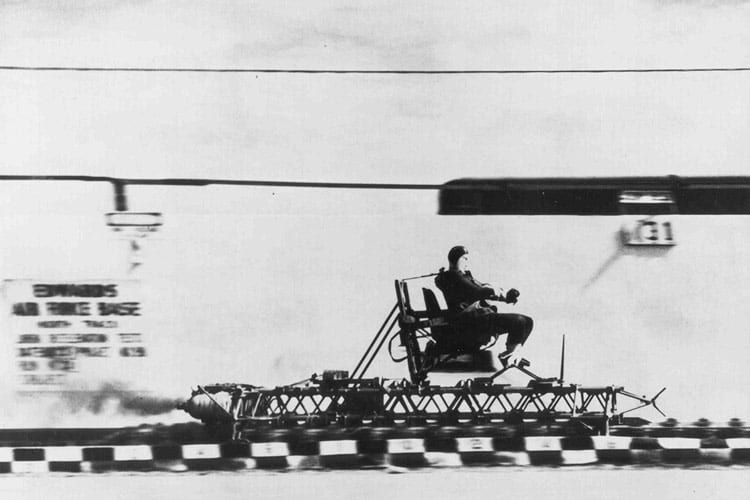
John Stapp being propelled in a rocket-powered sled at Edwards Air Force Base. (USFG / Wikimedia Commons)
Aviation technology had leapt massively in the years succeeding World War II. Thanks to the new streamlined fuselages and more powerful engines, planes had become faster and were capable of flying at much higher altitudes than previously thought. That said, scientists had little knowledge on how these advancements would affect the standard pilot. Faster and higher altitudes meant that pilots, on average, would have to bear significantly higher G-force on ejection, or on crashing. However, while others were worried about the effects, one man – John Paul Stapp – was absolutely fascinated by them.
John Stapp’s curiosity
John Stapp was born in 1910 to Reverend and Mrs. Charles F. Stapp, both of whom were American missionaries that were then stationed in Bahia, Brazil. Soon after, the family moved to Texas. This is where Stapp’s illustrious academic career began. By the age of 34, he had received his bachelor’s degree from the Baylor University, a Ph.D. from the University of Texas in Biophysics and an MD from the University of Minnesota, Twin Cities.
While interning at the Saint Mary’s hospital in Duluth, Minnesota, he decided that he wanted to join the military. On October 5, 1944, Stapp enlisted in the Army Air Corps as a doctor. By 1946, he had been allocated to the Aero Medical Laboratory at the training facility of Wright Field. This is where his curiosity for testing human tolerance really exploded.
In this respect, John Stapp was completely riveted by the ejection seat tests that were being conducted at Wright Field at the time. At the time, many renowned scientists were of the opinion that the body can only withstand a maximum of 18 Gs. However, Stapp did not concur. Testing the limits of human tolerance was to soon become the subject of one of Stapp’s immediate research projects.
Early experiments
Stapp’s first tests began in early April 1947, at a 2,000-foot long course at the Muroc (later renamed Edwards) Air Force Base. To prepare for the experiment, he had powerful rockets added to a sled, codenamed, Gee Whiz. Additionally, at the end of the course, Northrop engineers built in 45-foot long hydraulic brakes. While the rockets would help propel the sled to near crash speeds, the brakes would help create the required G-force.
Essentially, the faster the sled went, the more G-force could be produced. After experimenting with a test dummy dubbed Oscar Eightball, the team was ready to begin human tests. By June 1951, Stapp managed to conduct close to 74 runs at the track. Apart from seven other volunteers, he, himself, was one of the most frequent riders. However, Stapp was not satisfied with the results at Muroc, as it had its limitations.

File photo of John Stapp (Left). An unknown subject being prepared by Stapp and Captain Eli Beeding for a rocket test (Right). (USAF / Wikimedia Commons)
Eventually, he got the opportunity to push things further when he was transferred out of Muroc to the Holloman Air Base in New Mexico. While here, along with Northrop engineers, he built an even more powerful rocket sled. This time, the sled, codenamed Sonic Wind No. 1, was capable of producing speeds of up to 421 miles an hour, with about 27,000 pounds of thrust.
In all, when it stopped, the test subject would be exposed to close to 22 Gs – the highest ever recorded at the time. While the tests went on routinely, with every trial, Stapp tried to up the ante.

Rocket sled built by John Stapp which was code-named Sonic Wind No. 1 in the 1950s. Located at the New Mexico Museum of Space History. (Allens / Wikimedia Commons)
John Stapp becomes the fastest man on earth
On December 10, 1954, John Stapp would record his final run. This time, three additional rockets were added to the propulsion system in order to gain a massive 40,000 pounds of thrust. To minimise the risk of injury, Stapp’s arms and legs were strapped into the sled to ensure little to no movement. Additionally, he was asked to wear a helmet and hold a bite block in his mouth to protect his teeth. In a matter of a few seconds, the nine powerful rockets behind Stapp sprung into action. In about five seconds, the sled had reached a speed of about 630 miles per hour (1013.89 km/hr), or Mach 0.9. And just soon after, the brakes kicked in, and the sled was brought to a complete halt. The rapid deceleration translated to an unfathomable 40 plus Gs! Essentially, this meant that Stapp’s body weighed close to 6,800 pounds as it slammed forward when the sled stopped.
The damage to Stapp’s body was immense. All the blood vessels in his eyes had burst, rendering him momentarily blind. There were fears that he would never regain his eyesight. Additionally, he managed to crack a number of his ribs, while breaking both his wrists. The deceleration had also taken a massive toll on his respiratory and circulatory systems. But despite all that, he was in good spirits at the success of the test. Following the experiment, Time Magazine dubbed him, the “Fastest Man on Earth.”
All in all, John Stapp’s experiments were a huge success. They went on to prove that a pilot ejecting at high speeds and at an altitude of about 35,000 feet, could easily survive, withstanding about 45 G’s of force.
Footage of John Stapp experimenting on the effects of rapid acceleration and deceleration. (Youtube: PublicDomainFootage)
Enjoyed this article? Also, check out “Sergei Krikalev: The Time Travelling Cosmonaut“.
Recommended Read:
Sonic Wind: The Story of John Paul Stapp and How a Renegade Doctor Became the Fastest Man on Earth | By Craig Ryan
Recommended Watch:
Space Men – American Experience | PBS
Recommended Visit:
New Mexico Museum of Space History
Fact Analysis:
STSTW Media strives to deliver accurate information through careful research. However, things can go wrong. If you find the above article inaccurate or biased, please let us know at [email protected].
RELATED
The post John Stapp: The Air Force Pilot who Survived the Fastest Rocket Powered Sled appeared first on .
]]>The post Demon Core: The Deadly Plutonium Core That Killed Two Physicists at Los Alamos National Laboratory appeared first on .
]]>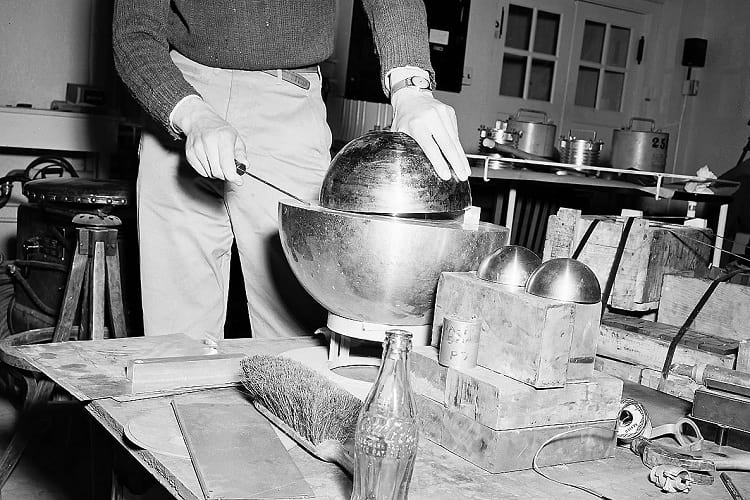
Photos of demon core from a re-creation of the experiment. (United States Department of Energy)
On 6th and 9th August 1945, the United States dropped two atomic bombs, Little Boy and Fat Man, on Hiroshima and Nagasaki, respectively. These bombs had plutonium cores, but it is less known that there was also a third plutonium core meant for a third atomic bomb. The Americans would have dropped it over a third Japanese city if Japan hadn’t surrendered on August 15, 1945. This was the core that came to be known as the Demon Core.
The demon core
The first two plutonium cores caused the deaths of over 200,000 people in Japan and the deaths of many more over the years from the resulting radiation. Strangely enough, though, these cores received no pejorative nicknames. On the other hand, the deaths of two Los Alamos scientists, Harry Daghlian and Louis Slotin, caused the third core to be labelled as the Demon Core; it had originally been known as Rufus. These scientists were part of the Manhattan Project and were involved in the building of the atomic bombs. Their deaths were due to their carelessness and disregard of safety protocols.
There was nothing actually demonic about the Demon Core, except in its intended use in nuclear weapons.
It was merely a 6.2 kilogram, spherical plutonium core that was used in the criticality experiments that the scientists conducted in the Los Alamos laboratory.
The plutonium core
The type of plutonium used to make the core was Pu-239. It is a naturally radioactive substance. That means, its atoms continuously emit neutrons and other particles from their nuclei. The large-sized neutrons collide against other atoms and cause them to split and emit more neutrons. These neutrons then go on to cause more collisions and split more atoms. Usually, however, many of the neutrons fly away without colliding into other Pu-239 atoms. The nuclear chain reaction, therefore, occurs at a very slow rate.
When Pu-239 is used to make nuclear weapons, the weapon-makers try to contain the neutrons within the Pu-239. That causes a continuous and fast nuclear chain reaction that involves splitting trillions upon trillions of atoms. The whole thing soon gets out of control and releases an overwhelming amount of nuclear energy and causes the bomb explosion.
The criticality experiment – tickling the dragon’s tail
After the Japanese surrender in 1945, the plutonium core that was meant for use in a third atomic bomb was turned over to the scientists to use for research purposes. They used it in the criticality experiments, or, what the physicist Richard Feynman called ‘tickling the dragon’s tail’.
These experiments involved monitoring the nuclear chain reaction and measuring the point at which the plutonium would turn supercritical enough to trigger off a dangerous radiation blast. These were very risky experiments that could go wrong at any moment, and the physicists were well-aware of that. Hence the term ‘tickling the dragon’s tail’.
By carrying out the criticality experiments, the physicists wanted to find out how far they could go without triggering a deadly nuclear reaction. It would help them to figure out the critical mass point to successfully detonate an atom bomb. The knowledge would also prevent accidents when assembling bombs or while the plutonium was in storage.
Harry K. Daghlian’s criticality experiment

Harry K, Daghlian Jr. (Wikimedia Commons)
Harry K, Daghlian Jr. was a 24-year-old physicist working at the Los Alamos laboratory. A brilliant young man from Purdue University in Indiana, he had joined the Manhattan Project in 1943 to work on building the atomic bombs.
A week after Japan surrendered, on 21 August 1945, he returned to the lab after dinner at 9:30 p.m. to continue working on a criticality experiment. According to the lab protocols, he was not supposed to work there after hours, and he was not supposed to carry out the experiments without another scientist present. However, on this day, he ignored these rules and the security guard who was present— 29-year-old Private Robert J. Hemmerly—raised no objections.
Daghlian was building a neutron reflector around the plutonium core, using tungsten carbide bricks. Being a very dense metal, tungsten carbide prevents neutrons from flying off. Instead, they are reflected to the plutonium and cause more atoms to split and release yet more neutrons. The rate of atom-splitting will increase if the plutonium core is surrounded by more tungsten carbide and, as a result, the core could go supercritical or out of control. Daghlian wanted a controlled chain reaction that remained below the critical point. There was a Geiger counter to indicate how well the experiment was proceeding.
The experiment involved placing tungsten carbide bricks around the plutonium core. After placing each brick, Daghlian checked the Geiger counter to make sure the resulting nuclear chain reaction wasn’t heading towards supercriticality.
When Daghlian had raised the bricks to around 10 inches about the core base and was about to place yet another brick on the stack, the Geiger counter began ticking faster. The core was heading towards supercriticality. The physicist jerked back the brick he was holding, but, in his haste, it slipped and fell right on top of the plutonium core. Now surrounded by tungsten carbide, the plutonium core went supercritical in an instant. A blue light flashed in the room, and there was a wave of heat. The Geiger counter went wild.

Reflective blocks being placed around a sphere of plutonium. (© Los Alamos National Laboratory)
Panicking, Daghlian grabbed at the fallen brick and dropped it yet again. He then tried to overturn the heavy table and, failing in that, began to hurriedly dissemble the tungsten carbide brick stack. He then removed the fallen brick, experiencing a tingling sensation in his hand as he did so. The nuclear chain reaction stopped, and the Geiger counter fell silent.
The entire incident took place in one minute. In that time, however, he was exposed to neutron and gamma radiation. He also suffered beta burns on his hands. Within hours, he began to show the symptoms of radiation sickness. He was hospitalized at once. In following days, his hands blistered from the radiation burns, and his entire body began to swell up like a balloon. He died 25 days later.

Harry K, Daghlian’s hand after the ill-fated experiment. (U.S.A. – Manhattan Project)
The security guard received a milder radiation dose. He died 33 years later of leukaemia and other complications resulting from the radiation.
Louis Slotin’s criticality experiment
Despite a review of safety procedures after Daghlian’s death, there was a similar accident the following year.
On 21 May 1946, around 3:20 p.m., Louis Slotin, Alvin Graves, and six other scientists were busy conducting a criticality experiment involving the plutonium core and two bowl-like beryllium sections. Like tungsten carbide, beryllium reflects neutrons. Slotin placed one section in a wooden frame on a table and put the plutonium core inside it. He then placed the other beryllium section over the core, making sure it didn’t cover it entirely.
If the neutron-reflecting beryllium hemispheres surrounded the core, it would reach supercriticality. To avoid this scenario, Slotin inserted a flathead screwdriver between them to keep them apart. According to lab protocol, he should have been using shunts to keep the hemispheres apart. Slotin, however, often disregarded the rules. Sometime earlier, the physicist Enrico Fermi had warned him that he would end up killing himself if he wasn’t more careful.
Slotin, however, ignored the advice, and on this day, things went wrong. As Alvin Graves watched the experiment from behind him, the screwdriver slipped from Slotin’s hand. The beryllium hemispheres closed and the Geiger counter went wild as the nuclear chain reaction went supercritical. There was a flash of blue light and a wave of heat.

Slotin accident mock-up. (Los Alamos National Laboratory)
Having seen what had happened to his colleague a year earlier, Louis Slotin knew he was now doomed. He died nine days after his exposure to radiation. Like Daghlian, he allowed the doctors to document his rapid health deterioration.
Safety measures adapted for criticality experiments
After the deaths of the two physicists, the administration at Los Alamos halted further criticality experiments. They also issued a memo to outline safety measures for the future. The memo advised that all further criticality experiments be carried out by remote controls and in separate buildings to reduce the risk of radiation exposure.
End of the demon core
Before Slotin’s accident, the Los Alamos administration intended to include the plutonium core in Operation Crossroads. They would then have detonated it in the series of nuclear tests that the United States carried out at Bikini Atoll in the Marshall Islands. After the accident, however, it was first necessary to let the core to cool down and become less radioactive before anyone could transport it. Then, the United States government cancelled the third nuclear test and no longer required the core.
While the physicists at Los Alamos could have continued using it for their research experiments, nobody was now willing to work with the Demon Core. Therefore, in 1946, the authorities ordered it to be melted and recast. That was duly done, and it was the end of the Demon Core.
Enjoyed this article? Also, check out “The Manhattan Project: The Making of the First Atomic Bomb“.
Fact Analysis:
STSTW Media strives to deliver accurate information through careful research. However, things can go wrong. If you find the above article inaccurate or biased, please let us know at [email protected].
RELATED
The post Demon Core: The Deadly Plutonium Core That Killed Two Physicists at Los Alamos National Laboratory appeared first on .
]]>The post Everything You Need to Know About Spontaneous Human Combustion appeared first on .
]]>
Victim (Helen Conway) of Spontaneous Human Combustion. (Folsomnatural / Flickr)
The phenomenon of Spontaneous Human Combustion (SHC) has been reported as early as 1470 when an Italian knight burst into flames after enjoying some wine. It was completely unexplained then and it seems that over 500 years later we are no more enlightened on the subject. It is so strange in nature that it has never been scientifically proven or unproven but many theories exist.
A victim to SHC is usually found turned to ashes with only limbs such as their feet left behind. Generally, a human body requires a temperature of 1600 Celsius to disintegrate bone – for example during cremation – but the improbable aspect of these cases is that furniture in close proximity to them is usually unaffected, and in some instances, the victim’s clothes. SHC, in essence, is where a person bursts into flames without an external source.
Notable Spontaneous Human Combustion cases
Here are some famous cases within the peculiar history of SHC. The earliest accounts are from a Danish Anatomy expert Thomas Bartholin in his work Historiarum Anatomicarum Rariorum (1641). However, if all fire needs is a human body then its origins can surely trace back to prehistoric times. The works of Bartholin looks into strange occurrences unexplained by medicine which human combustion certainly falls into.
A tale comes from 1470 when he describes an Italian Knight named Polonius Vorstius who was drinking wine with his family. Witnesses saw him burping and then fatally exploding into flames. The author, Bartholin was told of the account from a descendant of Vorstius.
Another comes from the works of a French writer Jonas Dupont – De Incendiis Corporis Humani Spontaneis (1763). He wrote that a resident of Paris – an innkeeper called Nicole Millet – turned to ashes during her sleep. Her husband was actually accused of the murder. Such is the unfathomable scene left when a person combusts. What made the anatomist Dupont conclude that it was neither murder nor accident was the straw mattress – It remained completely unaffected. The Surgeon thought on the same lines of Dupont and stated that it did not have the look of manslaughter. A guest at the public-house also helped with this alibi, luckily for the husband.
Accounts which have followed generally have the same characteristics. Furniture will remain intact as well as the hands and feet of many cadavers. In others, strange remains will be left such as organs, pieces of bone or shrunken skulls. This may well be down to the torso containing the most heat and in many cases, the deceased has been left in a sedentary position. Not every victim will be killed however and some people have survived. Many of these will not have been engulfed in flames but rather have received internal burns. Their internal organs are usually not damaged.
More modern examples include one as recent as 2010 in Galway, Ireland, where only the cinders were found of Michael Flaherty, a 76-year-old man. His entire living room was untouched apart from the ceiling and floor below him which had a sticky, sooty residue. The coroner did not blame his locality to the fireplace but rather to the first official case of SHC. If this has been considered in such a modern, secular society as Ireland it certainly gives more credence to the unexplained phenomenon.
Again in the 1960’s, the death of Dr. John Irving Bentley – a renowned retired physician – drew attention from the media. He was discovered in his Pennsylvania bathroom with only his left leg and foot at the scene next to a pile of ash and his walking cane. Mary Reeser is another famous example. In 1951 the only parts of her found was a foot, a liver attached to a piece of vertebrae and a skull the size of a teacup.
Not all will occur solely in the homestead and some are reported with eye-witnesses who actually saw the incident. Those of which are very scarce in detail, however. All of which do coincide to mention people giving off flames – often blue – from their stomachs and mouths. Many of these have been sensationally fabricated or added to along the lines of Chinese Whispers.
Take the story of Maybelle Andrews which with a simple internet search will describe her turning into flames at a Soho nightclub in front of dozens of party-goers. This seems to have now been debunked. It is from an earlier newspaper article where a lady named Phyllis Newcombe had her arm burned after a fire in an English club. Septicemia later killed her and the myth grew into Maybelle Andrews.
A very recent account with more information comes from Flensburg, Germany in 2015 where a woman burst into flames within a local park. An eyewitness put out the flames with his jacket to save her life. Authorities were quick to point the blame in the direction of two men who were seen to quickly exit the park. Otherwise, to a suicide attempt. With no clear answers however the non-explanation of SHC again rears its mysterious head.
What causes Spontaneous Human Combustion?
It was once thought that human bodies had no flammable substances so only a mass amount of a combustible substance such as ethanol i.e in alcohol could make a person ignite. But scientists have begun to unearth other theories. One of which involves a gas present in all of us known as methane. Once enough of it builds up it can be ignited by certain proteins also present called enzymes.
Another theory goes the way of a static electricity build-up – there are plenty of items after all which can catch fire without any help. If inside a bucket, oily fabrics can capture oxygen which will raise the temperature. Also, bales of hay where bacteria can build up to cause a chemical reaction.
A more popular hypothesis is labelled the “Wick Effect”. As many of the deceased are alcoholics – and many alcoholics are smokers (in past times more so) – if a lit cigarette strikes the skin it can ignite the whole body using fat as a flammable substance but keeping clothing protected. Many of whom also have debilitating diseases or are elderly which makes it harder to move or find help. This also makes the bones burn quicker in terms of diseases such as Osteoporosis. Others who are less believing of spirituality will point to cover-ups due to criminal activities for the main reason behind SHC.
We are still in the dark in terms of Spontaneous Human Combustion (SHC). As even scientists and coroners cannot give definitive answers for any of the deceased. All that can be said is that the human body is an incredible thing with an insurmountable amount of reactions happening every nanosecond. For this reason, it is not beyond the realms of possibility that an internal reaction could cause some widespread damage.
Hopefully, with more research, we can find out more about this peculiar act and save people from future disintegration.
Enjoyed this article? Also, check out “Luigi Galvani: The Man Who Fuelled The Idea Of Re-Animating Human Corpses“.
Recommended Read:
Faith, Madness, and Spontaneous Human Combustion: What Immunology Can Teach Us About Self-Perception | by Gerald N. Callahan
Fact Analysis:
STSTW Media strives to deliver accurate information through careful research. However, things can go wrong. If you find the above article inaccurate or biased, please let us know at [email protected].
RELATED
The post Everything You Need to Know About Spontaneous Human Combustion appeared first on .
]]>The post Eigengrau is the Dark Gray Colour That Most People See in the Absence of Light appeared first on .
]]>
Eigengrau vs. the black colour. (Private Detective / Wikimedia Commons)
Scientists believe that Eigengrau is the dark grey colour that human eyes see in perfect darkness and this is said to be the result of visual signals from optic nerves.

Gustav Theodor Fechner. (Wikimedia Commons)
German philosopher and physicist Gustav Theodor Fechner is believed to have investigated and popularized the term Eigengrau. He is also known for his key role in the genesis of the measurement of human perception. Being an early pioneer in experimental psychology, he founded psychophysics and is believed to have inspired most of the 20th-century philosophers and scientists.
What is the darkest colour a human has ever seen? For most people, the obvious answer would be black. More specifically, the blackness of total darkness. After all, black by definition is the absence of light. But total darkness isn’t as far as humans can think.
Paradoxically humans need light to see darkness
Let’s try to understand as to how humans perceive darkness with a little experiment. Pick a black object in front of you and stare at it for about a second. Now close your eyes for a few seconds and allow them to adjust.
You may need to cover your eyes if you are in a bright room or outside. Now open them quickly and look at that black object. Now it may take you a few tries to fully see it, but you’ll soon notice that the black object appears darker than the black of total darkness.
When our eyes are open, the light-sensitive layers of cells at the back of our eyeballs called the retina are bombarded by packets of light energy called photons.
The photons are a kind of elementary particle. Or, perhaps they are the quantum of the electromagnetic field that includes electromagnetic radiation like the light. They are also the force carrier for the electromagnetic force. The photons have zero rest mass. They always move at the speed of light within a vacuum condition.
The photons represent visuals like a trigger nerve impulses on the retina that pass through the optic nerve to the brain and a visual image is formed on the retina.
When we close our eyes or enter total darkness most people see vague grey field usually composed of changing regions of tiny black and white dots.
This colour is called the Eigengrau, a German word that means intrinsic grey. What we are seeing is visual noise and it is the static of our retina.
Photo interceptors in the human retina
The photo interceptors in the human retina come in two types, rods and cones. As per science, rods are said to be responsible for vision at low light levels. This is called scotopic vision. They lack spatial acuity or they build immediate colour and they exist primarily at the outer edges of the retina forming a large part of our peripheral vision.
When photons hit rod cells, a photo-receptive pigment within the cell called Rhodopsin changes its shape. This initiates the process of triggering a nerve impulse. Rhodopsin can also change its shape spontaneously from ambient heat. This triggers a false nerve impulse.
The rate of these false impulses is temperature-dependent, though in humans it averages about once every 100 seconds.
120 million rod cells in the human eye
With over a hundred and twenty million rod cells in the human eye, the cumulative effect of these false triggers follows the visual noise that we see in total darkness.
Because of this intrinsic noise, most of us have experienced true darkness.
The same amount of visual noise is present whether our eyes are or open or closed. But, we don’t see it when we look at the world.
Contrast is more important than absolute brightness
So how can we see an object that is darker than the visual noise if we can’t see the visual noise itself? When our brains process visual information, contrast is more important than absolute brightness. Darkness as we see it is relative to the brightest thing that we are looking at.
The term Eigengrau or Eigenlicht (German and Dutch: own light, brain gray or dark light) dates back to the 19th century. However, it has hardly ever been mentioned in any recent scientific publications.
Eigengrau is professed to be lighter than a black object
Eigengrau is professed to be lighter than a black object when normal lighting conditions exist. That is because; the contrast in light is more significant to the visual system than complete brightness.
Continuous experiments on rod cells of cane toads, scientifically known as Bufo marinus, highlight that the frequency of these impulsive events is temperature-dependent and that means that they are caused by the thermal isomerization of rhodopsin. Scientists believe that Eigengrau can be looked at as both a biological and a psychological phenomenon. Scientists have also determined that different people perceive Eigengrau differently and there are possibly several variations of the ‘Opaque Gray’. Therefore, every individual will have his own appreciation of Eigengrau.
Enjoyed this article? Also, check out “Vantablack: A Manmade Substance that is Blacker than the Blackest of Black“.
Fact Analysis:
STSTW Media strives to deliver accurate information through careful research. However, things can go wrong. If you find the above article inaccurate or biased, please let us know at [email protected].
RELATED
The post Eigengrau is the Dark Gray Colour That Most People See in the Absence of Light appeared first on .
]]>The post McMurdo Station: The Largest Research Centre in the Antarctic appeared first on .
]]>
McMurdo Station in Antarctica. (Eli Duke / Flickr)
While extensive swathes of Antarctica remain unpopulated, there are several international research stations on the continent that maintain personnel there throughout the year. The United States operates three research facilities under the National Science Foundation’s U.S. Antarctic Program, the largest of which is known as McMurdo Station.
McMurdo Station
This coastal station is located on the southern tip of Ross Island on the bare volcanic rock shore of the McMurdo Sound. It is about 1360 kilometres from the South Pole and about 3864 kilometres to the south of Christchurch, New Zealand. As the largest station in Antarctica, it serves as a starting base for research expeditions headed further inland and provides supplies to the research camps.
The station gets its name from the McMurdo Sound, which, in turn, is named after Archibald McMurdo. He was a lieutenant on the HMS Terror with the ship commander, James Clark Ross, when they first surveyed the area in 1841. Incidentally, Ross Island, which is a part of the New Zealand-claimed Ross Dependency, gets its name from James Clark Ross.
In 1902, Robert Falcon Scott, the famous British explorer, set up the first base camp near the current location of McMurdo Station. The wooden hut that he built—which is named Discovery Hut—still stands along the shore at Hut Point.
When the United States decided to build McMurdo Station in Antarctica, it was meant to be a Naval Air Facility. The U.S. Navy Seabees carried out the construction work from 1955 to 1956, and the station officially opened on 16 February 1956. Later, the United States decided to transform the station into a research centre, and it has operated as such ever since.

Radar and air traffic control equipment near the station. (Jose Lopez / U.S Defence)
Research carried out at the McMurdo Station
The research carried out at McMurdo Station covers multiple scientific disciplines such as geology, geophysics, glacial geology, glaciology, aeronomy, astrophysics, biology, and ecosystems. If you would like more information about the field projects that the McMurdo Station supports in the Antarctic region, please visit the USAP Science Planning Summaries Archives on the Science Support Page.
Additionally, the McMurdo Station also hosts writers and artists as part of the Antarctic Artists and Writers Program.
Life at McMurdo Station
Surrounded by icescapes, with the volcanic Mt Erebus looming in the background, McMurdo Station resembles a frontier town you might encounter in a science-fiction novel.
Helicopters come and go with regularity, and there are over 100 structures ranging from shacks to three-storey buildings across a 4 square kilometre area. These structures include administrative buildings, dormitories, the Albert P. Crary Science and Engineering Centre, repair facilities, a water distillation plant, a power plant, a fuel tank farm, a fire department, a post office, stores, warehouses, clubs, a church, an ice pier, three airfields, and a diving recompression chamber. The power and telephone lines for these buildings are all above the ground, as are the water and sewer connections.

Crary Science and Engineering Center. (Nathan Hoople / National Science Foundation)

U.S. Secretary of State John Kerry with a scientist inside Crary Labs at McMurdo Station on November 12, 2016. (U.S. Department of State / Flickr)
Given the icy landscape of Antarctica, it is necessary to take special care when it comes to waste disposal in order to avoid adversely impacting the environment. McMurdo gets its electricity from three wind turbines, and, to heat the buildings, it reuses the waste heat generated from the desalination plant.
The sewage plant carries out wastewater treatment on the sewage and compresses the resulting solids. They are then dispatched for incineration to the US mainland. Before the sewage plant was built at the McMurdo Station in 2003, the sewage was diluted and drained into the sea.

The wastewater plant. (Eli Duke / Flickr)
When the McMurdo Station opened in 1956, it had a total population of 93, and this was considered a lot back then. At present, the population hovers in the neighbourhood of 1200. That makes it the largest populated station in Antarctica. However, in the winter months—when the temperatures are known to drop to minus 50 degrees Centigrade and the snow can pile up to 1.5 meters—the population dwindles down to around 250 people. They are mainly research scientists and workers that have to remain at the station to look after the regular operations and maintenance of the place.

Food and other necessities being delivered by cargo vessel MV Green Wave to McMurdo Station. (U.S. Navy)

Frozen food warehouse at McMurdo Station. (Eli Duke / Flickr)
So, winter months are quiet, but things can get livelier in the summer. Along with being more populated, the station is largely without snow, and the temperature can rise to plus 8 degrees Centigrade. When the residents are not busy with their research work, they keep themselves entertained by participating in various sports and recreational activities.

Indoor soccer. (Eli Duke / Flickr)
To get around McMurdo Station and its surrounding environs, people generally use snowmobiles and other vehicles. You must drive slowly—on the righthand side of the road—not just on account of the snow, but because the speed limit at the McMurdo Station is 30 kilometres per hour.
Nuclear Station at McMurdo
The US government set up a 1.8-megawatt nuclear power plant on Observation Hill in December 1961. It turned out to be a costly mistake. It encountered several operational problems and required extensive repairs. Ultimately, the US government decided to shut it down in 1972. By then, however, the nuclear reactor – that everyone at the station called Nukey Poo – had contaminated the surrounding soil and turned it radioactive. Several tons of it had to be removed. Now a plaque commemorates the existence of the nuclear plant, and the site is a Historic Site or Monument.
Another, less toxic commemorative memorial on the McMurdo Station is the Richard E. Byrd Historic Site or Monument. The United States designated it as such at the Antarctic Treaty Consultative Meeting. The bronze bust of Richard E. Byrd sits on a black marble base, and the whole thing is kept on a wooden platform. It was unveiled in 1965. The accompanying inscription gives visitors an overview of Byrd’s polar expeditions. Except for pioneers like him, we probably wouldn’t have advanced research centres like the McMurdo Station in the Antarctic region.
Enjoyed this article? Also, check out “Halley Research Station: The First Floating, Relocatable Research Facility in the World“.
Fact Analysis:
STSTW Media strives to deliver accurate information through careful research. However, things can go wrong. If you find the above article inaccurate or biased, please let us know at [email protected].
RELATED
The post McMurdo Station: The Largest Research Centre in the Antarctic appeared first on .
]]>The post Submarine Communications Cables: All That It Takes to Keep the Internet Up and Running appeared first on .
]]>
Map showing how submarine communications cables are connected across the globe. (networkatlas)
Today, “cloud” is synonymous to everything online in common parlance. However, unbeknownst to us, most of the data we are accessing is shuttling across the world through an intricate network of cables under the ocean. This massive system of Submarine Communications Cable connects every continent, except Antarctica, and carries everything from emails and videos to the most encrypted documents.
Submarine communications cable: what are they?
Submarine Communications Cables are primarily made of strands of glass as thin as a hair, known as fibre optics. Data is transmitted via these cables at the speed of light, through wavelengths, across huge distances without obstruction. Each strand is capable of carrying an enormous amount of information, with over sixty 400 GB per second channels across a single strand of fibre-optic cable. To put it into perspective, each strand is capable of conducting 375 million telephone conversations at the same time.
The number of fibre optic strands within each cable is variable, depending on the distance it needs to cover. A trans-Atlantic cable can have around 4 to 8 strands, whereas a cable spanning the entire continent of Europe would require as much as 200.

Layers of protection for optical fibers that will be submerged in the ocean. (Oona Räisänen / Wikimedia Commons)
Submarine communications cables are very thin, measuring to a maximum diameter of 60mm. They are composed of a copper core that transmits power to signal boosting equipment and a variety of combination steel armour wires. Polyethene insulation waterproofs the cables. According to TeleGeography, there are approximately 420 cables running across the world today, the entire network spanning more than 700,000 miles. These cables might be running across the ocean, or along the coast of a continental shelf. Some cables are lying as deep as the height of Mt. Everest above the ground.
Procedure for installing cables under the sea
The submarine communications cables are generally buried under the sea floor. This is especially true on the shallow region around continental shelves where they might be damaged during fishing, or by ship anchors.
There are multiple methods for installing the cables in this manner, but the most popular one is using a cable plough. Towed by a cable ship, the plough lifts up a section of the seabed, allowing the cable to slide in. The chunk of the seabed is then placed on top of the cable, effectively burying it. The depth at which a cable is buried depends on a lot of conditions, including the texture of the seabed.

Installation of internet cables in progress. (Nc tech3 / Wikimedia Commons)
On a very hard and rocky floor, it is impossible to plough a cable through. In such circumstances, the cable is padded with additional protective layers. Increased armour when constructing the cable, covering it with graded coatings, and polyurethane or concrete casings, etc. is usually the way out. If the cable is laid on the sea floor extremely deep into the ocean, excess padding around the cables is usually not necessary.
Evolution of the submarine communications cable
The modern submarine communications cable network can find its origin in the telegraph system. The first such cable was a trans-Atlantic one between Ireland and Newfoundland that had taken four years to build and was completed in 1858. The first non-test message was a 509-letter message to President James Buchanan from Queen Victoria that took over 17 hours to transmit. It might seem like an eternity compared to today’s emails, but it was much faster than the contemporary alternative- ships. This cable, however, lasted barely a month.
After six years, another line was finally set up across the Atlantic to transmit telegraph messages. Since then, an extensive network of submarine cables has been established across the oceans of the world. These telegraph cables were later linked to telephone cables, and eventually, the fibre optic cables that the Internet depends on were developed.

Submarine cable being installed from Bondi, Sydney to Auckland, New Zealand. (Australian National Maritime Museum on The Commons / Flickr)
Submarine communications cables were originally point-to-point connections. However, the evolution of SBUs, or Submarine Branching Units, allowed a single cable system to serve multiple destinations. Today’s fibre optic cable networks have the fibres arranged in self-healing rings and are sectioned to follow different routes under the ocean. Another kind of network developed is the ‘Mesh Network’ which employs fast switching equipment to transfer services across paths. This is useful as even if a specific path is rendered inoperable, there is a negligible effect on the higher-level protocols. The Mesh System allows for a multitude of available paths between two points, making it unlikely for the entire network to crash at once.
Shark bites to espionage – the various threats to undersea cables
One of the biggest threats to the submarine communications cables is presented by sharks and certain fish. Barracuda, sharks and similar fishes have had a long history of biting these undersea cables, as can be seen from teeth embedded in cable sheaths. This has often led to the cables being seriously damaged, exposing the power conductor within the ripped insulation to the seawater. Communication cables are being modified to overcome this. Google, for instance, has been helping build a kevlar-like protective layer to drive back aquatic creatures. Undersea avalanches have also been known to damage cables. The Newfoundland earthquake in 1929 had triggered a massive undersea avalanche that had destroyed multiple trans-Atlantic cables. The Hengchun earthquake in 2006 had similarly wrecked the cables around Taiwan.
Another major factor that causes cables to malfunction is human error. Ship anchors and fishing trawlers have often damaged submarine communication cables, especially along the continental shelves. This can be devastating for developing nations with few links to the global Internet. Such shipping related disturbances had caused two instances in a single month back in 2012. The damaged cables connecting East Africa to the UAE and Europe affected at least nine countries. Regardless, damages to communication cables have reduced in recent times, since cables are now usually buried under the sea-bed.
During wartime, cables were often intentionally cut off by enemy forces to isolate the region. In fact, fibre-optic cables have always been a vulnerable target for espionage and surveillance efforts. During the Cold War, the NSA-run operation ‘Ivy Bells’ used these cables to tap into Soviet naval bases. Edward Snowden, the infamous NSA whistleblower, had revealed that the NSA still used the fibre-optic cables for global surveillance.
How are these cables repaired?
Submarine communication cables are fixed by bringing the damaged segment to the surface with the help of a grapple. A new segment is fitted in its place. Repaired cables are generally longer and are laid in a U-shape on the ocean-bed. If the cables are close to the surface, they are generally repaired on a submersible. Ports near cable routes often have specialized ships for cable repair on stand-by.

A submarine cable being repaired by a private marine engineering company. (The Castle Group / Wikimedia Commons)
Environmental impact of submarine communications cables
Since the fibre-optic cables used today are extremely small in diameter, they hardly cause any disturbance to the aquatic ecosystem or the sea-bed itself. The only exception is during installation and repairs. Then too, a very small perimeter is affected. Its negligible impact on the environment is recognised by the Joint Nature Conservation Committee (JNCC) and Natural England, the conservation advisors of the UK Government. They have thus allowed cables to be laid even within Marine Conservation Zones.
Global Internet connectivity, that forms the bedrock of progress in the modern world, has submarine communications cables as its veins and arteries. The intricate infrastructure of global communications that countries and economies thrive on, depends entirely on these tiny cables crisscrossing the globe underwater. Eco-friendly, and ever-developing, the submarine communications cables are indispensable in Man’s quest to create a sustainable and progressive future in a busy world.
Enjoyed this article? Also, check out “Optical Telegraph: Communication Before the Internet“.
Recommended Website:
Interactive map of the submarine cable
Fact Analysis:
STSTW Media strives to deliver accurate information through careful research. However, things can go wrong. If you find the above article inaccurate or biased, please let us know at [email protected].
RELATED
The post Submarine Communications Cables: All That It Takes to Keep the Internet Up and Running appeared first on .
]]>The post Animal Suicide: Do Animals, Like Humans Resort to Ending their Own Lives? appeared first on .
]]>
Animal Suicide: Kathy, one of the five bottlenose dolphins that were part of a famous television show called Flipper. The dolphin reportedly committed suicide after being depressed for a long time. (1950sUnlimited / Flickr)
Humans commit suicide, is a given. Do nonhuman animals commit suicide? Well, that’s not a given. Generally speaking, it’s a moot point. A human contemplates on past, present and future. He may seek closure in self-inflicted death. Animals, ostensibly, live in present with limited hindsight and foresight. So, why would they want to die? But, the ground realities reveal that suicide could be a way with non-humans as well.
Animal Suicide: Dogs and horses have done it
Man’s best friend, a dog, was in news in 1845, for committing suicide. The Illustrated London News reported that a dog of Newfoundland breed lay low for a couple of days, and then, threw itself in water, attempting to drown. It was rescued. But it rushed once again to deep waters and was rescued yet again. This exercise continued for long. In the long last, dog succeeded in drowning to death, something that he was dead bent to accomplish. Another case of a chain of canine suicides was highlighted by this portal under the head, ‘Overtoun Bridge from where dogs leap to their deaths’. Despite tangible holes in suicide theory, it is hard to ignore that animals too may choose to die, out of their own free will.
Consider man’s second-best friend, horse. Aristotle (384-322 BC), described one which jumped into a gorge and killed self. The horse had unwittingly mated with its biological mother. A case like Oedipus, the mythical king who unwittingly married his biological mother. When the couple realized the truth of their relationship, both were full of remorse. The lady killed self, and Oedipus renounced the world.
Grief/monotonous existence/choice of a less painful death, have triggered animal suicides
The list of suicide-prone animals is long and mindboggling. Dogs prostrating at the graves of their dead masters and dying. A cat, unable to bear the grief of her dead kittens, chooses to die. A herd of cattle, as recently as 2009, jumps off a cliff in Swiss Alps over a period of 3 days. A deer jumps to death over a slope, preferring to die by a bone-crushing fall rather than fall to hunting dogs.
The suicide of a dolphin, star of the 1960 television show, Flipper, made waves. It is believed that the dolphin grew tired of monotonous life and decided to die. Dolphins are an intelligent creature. They have the ability to observe their thought processes and choose one that suits them best at a particular point in time. They are also unique in being voluntary breathers, unlike humans and other animals who are involuntary breathers. Dolphins breath consciously whereas for other life forms breathing is automatic, uncontrolled, reflex action. That means the dolphin may decide not to breathe till it dies from lack of oxygen. Since such observations can’t be reproduced in experimental conditions, it remains a tentative finding. Nevertheless, this self-induced death of a dolphin is a strong argument in favour of animal suicides.
Suicide bombers do exist in the animal kingdom
Further, there are some life forms which act as suicide bombers. The objective though, is not self-centred, as in suicide, but is self-denial for a larger good. For example, the exploding ants of Malaysia. These ants blow their head or abdomen (autothysis) in the face of a threat. The blow scatters a paste which traps and kills the threat. Thus, a suicide/self-sacrifice saves fellow ants from an enemy. A similar defence is characteristic of a termite (Globitermes sulphurous). It catches hold of the intruder/enemy and pumps its (termite’s) abdomen to release glue which spills over both the lives pitted against each other. The glue hardens upon coming in contact with air, killing them both. Likewise, pea aphid blows up its body to scare, even kill a predator, to save its commune. In what’s closest to committing suicide, it may surrender to a natural parasite, the wasp, to lay eggs on its body. Young wasps feed on aphid body, killing it in the process of growing up. A volunteer aphid thus barters its life to buy protection for the rest of the aphid group from wasp attack. Much like the grandma story of a village and a demon. To contain demon to lesser harm, one villager would volunteer to walk to the demon’s cave every day, and offer himself as food to the demon. That would keep the demon in good humour and save the rest of the village from demon’s wrath.
Self-sacrifice could be suicide by default
Consider self-sacrificing crab spider. It feeds her young ones with her unfertilized eggs. The taste of eggs hooks young ones to the taste of their mother’s body. And the mother is devoured, bit by bit, till it goes lifeless. Matriphagy, the act of feeding on mother’s body, is also observed in some species of scorpions, insects and amphibians. This may be a case of maternal care gone awry but does prove that there is a thin line that separates life and death. If self-preservation was a baseline of animal behaviour, as generally believed, such cases of self-denial wouldn’t be seen among animals. Can these instances, be construed to mean suicides?
Man, unlike animals, may philosophise to choose death
Is suicide a consequence of physical factors? If yes, there are parallels between humans and non-humans. Like, the monotony of existence, perceived pain and tragedy, a drug or substance-induced fatal attraction, etc. Risk of suicide goes up significantly in a man living on anti-depressant drugs. That’s a physical factor prompting suicide. But it is well known that metaphysical factors are significant drivers of human suicide. An IAS officer Mukesh Pandey makes a detailed video of him explaining why he is about to commit suicide. The officer isn’t bogged down by any pain or tragedy, but feels, vaguely, that life isn’t worth living. Does such a metaphysical angle apply to animals as well? Can animals contemplate that life isn’t worth living? Well, as of now, we have no way of knowing.
The mystery of dog-suicides in Scotland remains unsolved
For dog suicides at Overtoun Bridge in Scotland, one explanation is that dog being colour-blind, can’t separate bridge from surrounding greenery, and trips in the intervening space. Another view is that the smell of rodents living in the downside of the bridge lured the canine for a fatal jump. No cause-effect relationship has been established till date and dogs leaping to death from bridge remain a mystery. In stressful situations, scorpions sting their own selves and die. Sceptics say that a fearful scorpion goes sting-stabbing recklessly, and swirling at the same time. And, in an error of judgement, stings its own body and dies. A case of self-defence gone haywire. Were the dogs jumping off the Overtoun bridge doing so in some kind of self-defence?
Can one life use another for its own survival?
Could there be something that programmed the canines, in the above example, to go for daredevil jumps? Can a parasite programme the host animal to go daredevil? There is one interesting case. The infection of a protozoan, Toxoplasma gondii, in the brain of rat. It programs rat to go daredevil and for a purpose. The protozoan parasite needs the body of a cat to complete its life cycle. Because it can reproduce sexually only in a cat’s biosystem. So, what does it do to reach to a cat which a normal rat will always avoid? The parasite hijacks the rat’s neuro-mechanism which helps it remain away from the cat. The infected rat, so to say, is reprogrammed to be attracted to a cat. That obviously makes it easy prey for its natural predator, and the parasite thus gains access to the cat’s body. Could there be more such cases of one life driving another to the path of self-destruction?
Overall, suicide in animals remains an enigma
What is crystal clear is this that sentience is part of animal psychology, like it is of a human being. Both are aware of life, pain and crisis situations. Both may choose death over life in a particular set of circumstances. But suicide is not the same thing as dying for one’s community or fellow beings. It ought to be a closure for a suffering or an unacceptable status of life. Such closure is clear in human suicides as it is communicated by the subject before dying or inferable from cogent circumstantial evidences. No such so closure can be inferred in animal suicides as animal-human communication is extremely limited. Moreover, the metaphysical side of suicide makes it a subject beyond the reach of scientific investigation. Therefore, it is hard to prove, as well as to disprove, that animals commit suicide. Doubtless, there are radical differences in the thought process of humans and non-humans. Suicide, seemingly, is not one of those differences. Or, maybe, we should wait till a standard definition of suicide is drafted.
Enjoyed this article? Also, check out “Overtoun Bridge: A Mysterious Site from Where Dogs Leap to Their Deaths“.
Fact Analysis:
STSTW Media strives to deliver accurate information through careful research. However, things can go wrong. If you find the above article inaccurate or biased, please let us know at [email protected].
RELATED
The post Animal Suicide: Do Animals, Like Humans Resort to Ending their Own Lives? appeared first on .
]]>The post Radar Technology’s Early Detection System Revolutionised the World and Made it a Better Place to Live in appeared first on .
]]>
VHF Russian mobile air defence radar. (Vitaly V. Kuzmin / Wikimedia Commons)
The concept of sending out pulses of radio waves to detect the presence of an object or measure the distance of the reflected signal is called radar technology. Radar is simply an acronym for Radio Detection And Ranging.
The principle of radar technology is based on an electromagnetic system and it works when energy is radiated into space. It monitors the reflected signal or an echo from an object.
Simply speaking, it works best in the low-frequency range like the microwave, UHF, VHF or HF range. Meaning, it works in frequencies like 1 GHz.
Some of the factors that could affect radar’s performance include maximum power, the sensitivity of the receiver, the pulse width or rate and probably the antenna size.

Sir Robert Alexander Watson-Watt. (UK Gov)
Pioneers in the radar technology
Several engineers and scientists from across the world can be credited for the development of the radar technology system.
One such pioneer in the radar technology was none other than the Scottish scientist Sir Robert Alexander Watson-Watt. The British Royal Air Defense granted him the patent for the radar system in April of 1935.
Sir Watson-Watt became the first person in developing the original and practical radar system, which helped Britain to defend itself during WWII. Sir Watson-Watt’s radar system was able to use radio pulses in detecting planes from as far as 129 km.
Radar network in Britain during WWII
As a result, before WWII even began, the British government established a network of radar stations along the British coast using Sir Watson-Watt’s system. The stations, identified as Chain Home, successfully helped Britain to defend itself against the German planes during WWII.

Chain Home radar, Sussex. (Royal Air Force official photographer)
Sir Watson-Watts’s system depended on long wavelengths, which restricted the ability to accurately pinpoint German aircraft during night attacks. To overcome this anomaly, the British government roped in engineers John Randall and Harry Boot to invent cavity magnetron for developing a shorter wavelength radar system in 1940. Such a radar system happened to be compact and could be installed in planes.
Before that in 1915, Sir Watson-Watt, while working in the Meteorological Office, he developed systems to detect thunderstorms.

Heinrich Rudolf Hertz. (Robert Krewaldt)
Heinrich Hertz
Before that German physicist, Heinrich Hertz was one of the early pioneers in producing and transmitting radio waves in his laboratory. Hertz found that invisible radio waves were one form of electromagnetic radiation. He further detected that while materials just transmit radio waves, while others actually reflect the waves.
The German physicist established this basic principle of the radar system in the late 19th century. Following this discovery, further experiments took place by putting the radio waves to practical use.
Basic radar system

Guglielmo Marconi. (Library of Congress)
For the first time in 1901, Italian physicist Guglielmo Marconi transmitted a wireless radio communication to America. Three years later, German engineer Christian Huelsmeyer developed a basic system that helped trains and boats to use radio waves to prevent collisions during foggy conditions.
In the US and elsewhere, scientific work continued on early radar detection systems for two decades from 1920. However, the technology’s value was felt more in Britain as it effectively used it against the German air attacks.
Since the 1930s, radar technology underwent rapid development to meet both defence and civilian applications. Today, there are nine different types of radar systems in the world today.
Types of radar systems
The types of radar systems include bistatic radar, continuous wave radar, Doppler radar, monopulse radar, passive radar, instrumentation radar, weather radars, mapping radar and navigational radars.
These radars are increasingly being used in applications like air traffic control, remote sensing, weather observation, space surveillance and even planetary observation.
The basic parts of the radar system include a transmitter, an antenna (transducer), duplexer and a receiver.
The transmitter generates a high-power signal, which the antenna radiates into space acting as a transducer. With the help of electromagnetic energy, a duplexer transmits and receives signals from the same antenna.
It is then the receiver amplifies the radar echo. In order to remove the unwanted clutter from the signal, a signal processor separates the signals. Only then can engineers or a computer decide whether a target is present or not.
When the target’s presence is detected, its location can be ascertained and tracked over a period of time.
Radar technology in the digital age
Since the early digital age of 1970s, radar technology made significant advances under the Doppler radar system, which enhanced its ability to spot an aircraft in spite of heavy clutter.
An example of this system is the airborne-warning-and-control-system (AWACS) of the US Air Force. Another example of this principle is its use in spacecraft for the purpose of remote sensing environment.

Boeing E-3 Sentry, an Airborne early warning and control aircraft. (U.S. Air Force photo)
Over the years newer radar methods evolved in the areas of air defence, airborne bomber, and ballistic missile detection.
Some of the key future capabilities of the radar technologies included in the areas of Agile Beam Techniques and faster volume scans.
As the technology evolves, there should be further investigation and analysis of the benefits, risks and costs that can drive the future advanced radar architecture decision.
Enjoyed this article? Also, check out “Lockheed Blackbird SR-71: The Fastest, High-Altitude Reconnaissance Aircraft in the World“.
Fact Analysis:
STSTW Media strives to deliver accurate information through careful research. However, things can go wrong. If you find the above article inaccurate or biased, please let us know at [email protected].
RELATED
The post Radar Technology’s Early Detection System Revolutionised the World and Made it a Better Place to Live in appeared first on .
]]>The post The Wallace Line: The Invisible Line of Bio-Diversity in the Indian Ocean appeared first on .
]]>
Wallace Line. (Altaileopard / Wikimedia Commons)
The Wallace Line is an invisible and imaginary line that stretches across the Indonesian islands to demarcate the evolutionary differences of the fauna in that region. It gives us an interesting insight on the biogeographical history of the area.

Alfred Russel Wallace. (London Stereoscopic & Photographic Company)
Alfred Russel Wallace, a 19th-century British naturalist, travelled throughout the Malay Archipelago from 1854 to 1862 in order to study the natural history of that area. While exploring the Indonesian islands, he discovered that the fauna on some of the islands was different from that found to the east of those islands. In fact, the islands such as Sumatra, Borneo, Java, and Bali had animal life that was similar to other parts of Asia. They had tigers, rhinoceroses, tarsiers, and tapirs. On the other hand, the Lombok, Sulawesi, and Timor islands had marsupials, monotremes, tree kangaroos, and racquet-tailed kingfishers that were similar to the animal life in Australia.
The Wallace Line
In 1859, Wallace drew a hypothetical line to demarcate this difference in the fauna. This line started from the Indian Ocean and passed through the Lombok Strait between the islands of Bali and Lombok. It then turned northwards through the Makassar Strait between the islands of Borneo and Sulawesi, passed to the south of the island of Mindanao, and ended in the Philippine sea.
Later, the English biologist Thomas Henry Huxley named this imaginary line the Wallace Line.
The Indonesian islands to the east of the line are referred to as belonging to the biogeographical realm of Wallacea. They are separated from Australia and New Guinea by another imaginary line called Lydekker’s Line, which was delineated by the naturalist Richard Lydekker in 1885. Between these two lines is another line called the Weber Line along which both Asian and Australian fauna and their hybrid species are equally present.
Explanation – The Wallacea biogeographical realm
Starting in the 19th century, European naturalists developed the field of biogeography which is the study of how fauna came to be distributed around the earth over time. Using the presence of fauna as the main indicator, the naturalists divided the earth’s surface into biogeographical realms. Furthermore, they subdivided these realms into ecoregions containing different biomes and habitats. In each realm, the fauna more or less evolved in isolation, completely separated from the fauna of the other realms by natural barriers that prevented them from migrating. The largest natural barriers are the oceans, followed by deserts and mountain ranges. Islands, being isolated, are an easier and more convenient ecosystem for studying biogeography.
Biogeographers use the continental drift theory to explain the distribution of fauna. Until 140 to 175 million years ago, the continents of Asia and Australia were connected. During this period, the indigenous animals could move all across the huge landmass and reproduce. Then the continents started to drift apart, the ocean levels rose up, and the islands of the Malay Archipelago were formed on the continental shelves between the Asian and Australian continents.
A continental shelf is a part of a continent which has sunk under water.
The Sunda Shelf connects Asia with Borneo, Bali, Java, and Sumatra. Australia and New Guinea are connected by the Sahul Shelf to these islands. So, the ocean separated the land masses and this led to the evolution of different animal species on the two continents and on the islands between them over a period of some 50 million years.
During the last ice age, between 70,000 to 40,000 years ago, the ocean levels fell dramatically and opened up land bridges between Asia and the islands and between some of the islands and Australia. At this time, various fauna crossed these land bridges to the islands and roamed across them. However, the ice age soon ended, and the ocean levels rose up to 25 to 125 meters, effectively closing off the land bridges between the islands and the continents. The fauna were thus isolated on the islands that they happened to be on at that time, and, thereafter, they evolved in unique ways by adapting to the environment on these islands. Eventually, they became distinguishably different. These islands form the Wallacea biogeographical realm, and a very large number of endemic species of fauna now live on them.
Wallace’s great discovery
Over 500 islands lie to the east of Bali across the Lombak Strait and these are known to the Indonesians as Nusa Tengagara. From the northern islands of Lombok, Sumbawa, Flores, and Alor, these islands stretch over 1,300 km to the southern islands of Sumba, Savu, Roti, and Timor.
While studying and collecting birds in the area, Wallace noticed that the birds on some of the islands that were close to each other were very different and that the birds on some of the islands that were far from each other were of the same species. This was particularly noticeable on the island of Bali, which had 50 percent different birds from those on the island of Lombok, despite the fact that they were separated by a distance of just 25 km of water. But 97 percent of birds on Bali were present on Java. Also, 75 percent of the birds on Lombok are Asian species, while 14 percent of the birds on Bali are from Australia. Wallace was perplexed by this discovery. What was it that had made the birds that were capable of migrating to and from the islands remained on their respective islands, and why had they evolved in such distinctly different ways over the centuries?
The explanation for this goes back to the ice age when there was a land bridge between Java and Bali, whereas, in the same period, there was a water channel between Bali and Lombok. Some of the birds, being good flyers, crossed the water channel to Lombok and flew further to settle on the eastern islands. Similarly, birds flew from Sumbawa across the Sape Strait to Komodo and from Alor across the Ombai Strait to Timor.
After the ice age ended, when the water channels between the islands deepened and widened, these isolated birds became distinct from those that had remained on Java.
Of the 564 bird species in Nusa Tenggara, 144 are endemic. On the other hand, the island of Sulawesi’s endemic population includes 62 percent of mammals and reptiles, 27 percent of birds, and 76 percent of amphibians. Possums, and marsupials, which are related to kangaroos, crossed the land bridges from Australia to Sulawesi during the ice age. However, these animals could not cross the Makassar Strait to reach Borneo from Sulawesi.
Although there are differences in flora as well along the Wallace Line, they are not as distinctive as the fauna.
Enjoyed this article? Also, check out “Kármán Line: The Hypothetical Line That Delineates the Earth’s Atmosphere from Outer Space“.
Fact Analysis:
STSTW Media strives to deliver accurate information through careful research. However, things can go wrong. If you find the above article inaccurate or biased, please let us know at [email protected].
RELATED
The post The Wallace Line: The Invisible Line of Bio-Diversity in the Indian Ocean appeared first on .
]]>The post Vantablack: A Manmade Substance that is Blacker than the Blackest of Black appeared first on .
]]>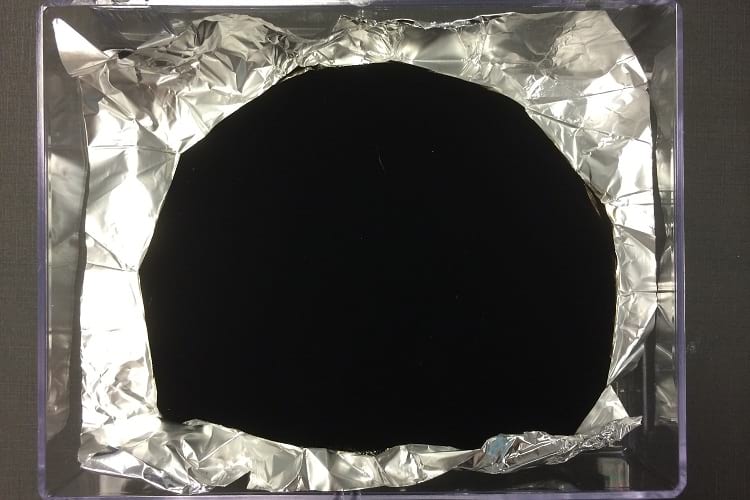
Vantablack on an aluminium foil. (Surrey NanoSystems / Wikimedia Commons)
What is colour, one may ask? To put it in simpler words, colour is what the human eye perceives when a ray of light falls on an object and reflects from it into the surroundings. It is basically a certain wavelength of the ray of light that is absorbed and then emitted from the object that makes up a particular colour, which we see eventually. Black, for instance, is a colour that absorbs most of the light, which when cannot be reflected, makes us see the dark colour. But a few years ago, scientists in the United Kingdom created a substance that was so devoid of colour that it became the blackest material to be ever produced by man. Meet Vantablack, the blackest of the black.
What is Vantablack?
Early in the year 2007, several scientific players were in a bid to outdo each other in creating the blackest material man had ever known; but only Surrey NanoSystems succeeded in getting theirs trademarked first. Initially, the work on creating a super-black material began at the National Physical Laboratory in the UK. Surrey NanoSystems in association with NPL worked on ideas to create the blackest substance which could revolutionize many frontiers. And so from the lab-grown experimental substance, the already existing super-black coating underwent several improvisations and Surrey NanoSystems came up with the name for their new material. An acronym of ‘Vertically Aligned carbon NanoTubes Array’, VANTA was prefixed to the colour ‘black’ to get the name of the darkest material ever – Vantablack.
Vantablack was made under a modified vacuum procedure called chemical vapour deposition process and was artificially grown on a substrate, in this case, on an aluminium foil. Millions and millions of carbon nanotubes vertically aligned close together and arranged in an order on a foil, under very high temperatures gave Vantablack its physical properties. Carbon nanotubes are microscopic, rod-like cylindrical structures that are almost five thousand times thinner than a human hair. When these densely packed minute tubules make up a substance, they help in making any material even stronger. When Vantablack was finally created, scientists found out that the new substance could absorb 99.96 percent of the visible light, which made an object coated with Vantablack almost impossible to discern even against a lighter background. It was so black in the absence of light bouncing back off that it felt like looking into a deep pit of nothingness.
Physical properties of Vantablack
Quite ironic as one may call it, Vantablack, the blackest substance ever synthesized, was created using carbon nanotubes, which were made to withstand a temperature of around 450 degrees Celsius emitted from several lamps. Scientists are of the opinion that its colour is the closest match to a black hole humans can ever see. It has ultra low levels of reflectance, meaning its surface does not give out any incident light that falls on a substance coated with Vantablack. It not just absorbs all the light in the visible human spectrum but also other radiations of all wavelengths that the human eye cannot perceive – right from ultraviolet to infrared radiation. Any form of light that enters a material coated with Vantablack gets almost totally absorbed into it and does not find a way out to escape from the tightly packed forest of carbon nanotubes. This trapped light then dissipates and gets converted into heat.
The colour is also super-hydrophobic, which means it does not allow water to have an impact on it or its physical properties. An aluminium material, for example, when coated with Vantablack would float on the surface of the water rather than sink to the bottom, like it usually would. Vantablack is resistant to high thermal exposures and also highly resistant to extreme shocks and vibrations. Vantablack can absorb such high amounts of light, without reflecting it further, that three dimensional objects, when seen from a certain angle, can appear to be two-dimensional to the human eye. Due to its rare physical properties that not many materials possess, Vantablack has found a wide range of applications.
Uses of Vantablack
The lab-grown, super black material has so many potential benefits that its application can revolutionize avenues such as space exploration, defence technologies, architecture and even art to name a few. Originally designed for use onboard space satellites, Vantablack found many takers eventually. Recently, the colour made its space debut on board Kent Ridge 1, a low earth orbit microsatellite, which is a conjunction between German and Singaporean organizations. Vantablack helped the satellite in improving its star-tracker control system and also helped in reducing the interference of stray light in the imaging systems while on the mission.
Thermal camouflage in defence technologies could also be one of the options that can find Vantablack at the helm of things. Due to its heat dissipating quality, Vantablack can also be used in solar power technology. A lens coated with Vantablack can prevent lens flares in powerful telescopes, thus reducing stray light to enter into it, which will allow space researchers to see some of the faintest and most distant objects in the universe. Due to its low reflectance properties, it can be used in infrared sensors, cameras and other imaging and mapping devices. Also, since its conversion of energy is huge, it can be used to power up electronics and other scientific instruments.
While ocular uses of Vantablack stay on top of the list of its potential applications, artists and architects are making use of this super black material to create designs that provide optical illusions for a viewer. At the recently concluded Winter Olympics in South Korea, a British architect Asif Khan unveiled a building called The Hyundai Pavilion in Pyeongchang, which was designed by coatings of Vantablack, and it came to be termed as the darkest building on Earth. British artist Sir Anish Kapoor, who is the exclusive licensee of the spray paint version of Vantablack called Vantablack S-VIS, dabbles in black colour in his artworks – which are mostly hypnotic and disorienting – and he now plans to use the new non-reflective colour in his select works. As far as military uses of Vantablack go, the super black material could mask off aircraft and hide them in stealth mode and can also be used to block out military equipment during the time of warfare.
This blackest of a black substance, which is touted to be even more expensive than diamonds or gold has so many probable uses in countless fields that working with it, will have endless possibilities. While a lot of agencies dealing in products for all walks of life are trying desperately hard to lay their hands on Vantablack, it is only a matter of time, before we get to know how Vantablack starts bending reality in the days to come.
Enjoyed this article? Also, check out “Eigengrau is the Dark Gray Colour That Most People See in the Absence of Light“.
Fact Analysis:
STSTW Media strives to deliver accurate information through careful research. However, things can go wrong. If you find the above article inaccurate or biased, please let us know at [email protected].
RELATED
The post Vantablack: A Manmade Substance that is Blacker than the Blackest of Black appeared first on .
]]>The post Under the Sea: Do Fishes Dream? appeared first on .
]]>
Oscar (Astronotus ocellatus), in a sleep-like state. (Jón Helgi Jónsson / Wikimedia Commons)
Certainly not one of life’s most pondered questions but never-the-less an important subject is whether fish, sleep or dream. After all, this is an animal who has been surviving since not long (relatively) after the Cambrian Explosion – 510 million years ago – and who with some, we share 70% of genes with (Zebrafish). Ergo, understanding the way in which fish sleep could possibly unlock sleeping disorders in humans.
What is sleep?
In mammals, sleep is defined as electrical activity within the neocortex of the brain as well as the closure of eyelids. This is more difficult to attribute to fish because they have neither. It has always been perceived that because many fishes constantly keep moving (many mainly to keep water passing through their gills for respiratory functions) or that some are blind that they never sleep. It is fair to say that it has never been as much studied as today yet the study into sleep is still in its infancy, and much of it still remains unknown.
The criteria for sleep in fish have understandably been extended,
(1) Prolonged inactivity,
(2) Typical resting posture, often in a typical shelter,
(3) Alternation with activity in a 24-h cycle,
(4) High arousal thresholds. (AKA difficult to wake)
Traditional sleep patterns
Many species, like the before mentioned Zebrafish completes a regular sleep cycle (human-like) in the sense that they are unresponsive when the sun goes down – diurnal. If they are sleep deprived they will react in the same way as humans in the sense that they will not be able to function efficiently and will catch up with sleep in the future.
“When we humans don’t have enough sleep, it starts to impact our ability to function properly, a similar thing has been observed in fish. In a 2007 study, a group of zebrafish were sleep deprived during their normal 6 hour period of rest, the next day the zebrafish were much harder to arouse and their mouth and gill movements were reduced. The study also showed that they have slower breathing cycles in sleep, take naps and are governed by melatonin – very similarly to us as humans.”
Others such as the Brown Bullhead will lie in a seemingly relaxed position, with its fins stretched out and the body at an angle. This will include less respiratory functions and sensitivity. Requiem sharks, for example, can be handled by a human without a response when asleep. There are many reports of fish finding shelters in various conditions, an evolutionary trait in order to not be disturbed.
Less than traditional sleep patterns
Many species, including sharks, show no obvious signs of sleep such as swimming continuously and therefore have been assumed to never sleep. This is suggested to be a wrong assumption now after research showing that some fish have a sleep function which causes the brain to repeat processes from memory. This is common in pelagic fish who swim for days, even months without anything happening in their surroundings. In the kilometers they travel they can essentially shut down most of their sensors, surviving and travelling on memory cells. This is a form of sleep swimming as they do not response to stimuli or predators in cases.
Sleep in fish is extremely different to humans but this does not mean it is not sleeping. At times they are conserving energy which must be linked to a sleep-like activity. Not all sleep like us, and some use extremely dissimilar techniques.
“The Parrot fish has a very interesting sleeping ability. It secretes mucus which surrounds its body providing it with a cocoon-type outer layer. This protects them from predators while they are resting.”
It has been observed that schools of fish will form a testudo in the sense that sleeping fish will travel in the middle while those at the edges will be the eyes and ears of the shoal, so to speak.
Other dozing water-dwellers
Outside of fish, there are other types of animals that have to rest in water. Whale and Dolphins are actually mammals (give birth to live young, produce milk and breath air) so their sleep function differs from the fish we have looked at previously. They will show more traditional (human for the purposes of this article) ways of sleeping such as resting in the water and taking less respiratory breaths. Dolphins will also use the tactics that many species of fish use. This includes the memory function, swimming slowly, usually next to another animal (this is more like napping). Additionally, dolphins will inhibit a method called ‘logging’ in which they sleep by floating on the surface of the water. Yet species such as the bottlenose will remain alert when using these practices. It will only close half of its brain and one eye. It has to, because every few hours a dolphin needs to surface to take a breath of air. They will do vice-versa with the other side once rested. Seals also exhibit this behaviour which many scientists would say is not sleeping in the true sense because parts of the brain are still active.
An amazing method in these two species is called Echelon Swimming where the young will sleep while their mother swims. The young do not need to move themselves because they are deliberately caught in their dependent’s slipstream. Mothers of whales have to continuously swim for the first few weeks of a newborns life, to keep them from sinking as at this stage they do not have enough blubber or fat to float.
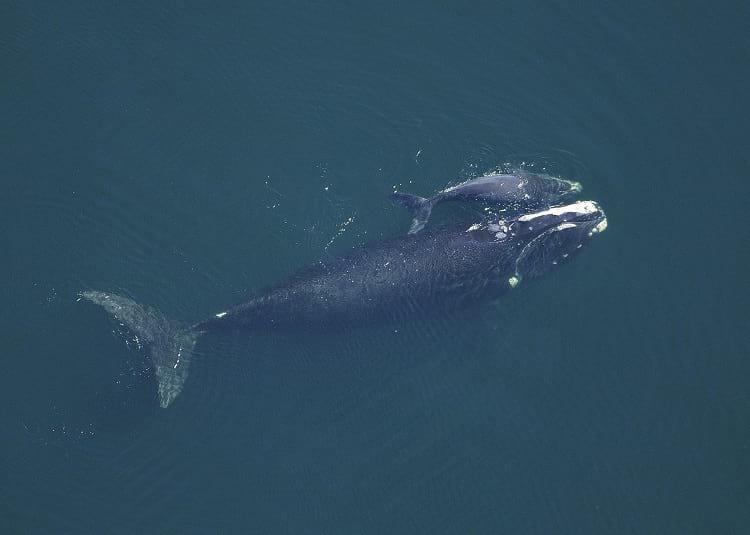
A humpback whale with her calf. (Pxhere)
Dreamers?
While REM (Rapid Eye Movement) – the stage of sleep when dreams are reported in humans and other animals – have not been recorded in dolphins, they have briefly in whales.
“…a pilot whale was noted as having six minutes of REM in a single night.”
It is common knowledge that mammals such as dogs and cats dream, so the idea of a dolphin and whale dreaming is definitely not a far-out concept. It is a surreal thought, thinking of what a dolphin must dream about.
The conclusion
It is unconceivable to many of us that fish sleep because their restless states differ so much from the conventional methods that we humans use, yet it is completely apparent that they do. In fact, out of the predicted eight million species of animals, in the whole of the animal kingdom, it is only the Bullfrog that is thought to never sleep, but even they exhibit signs of resting.
Enjoyed this article? Also, check out “Animal Suicide: Do Animals, Like Humans Resort to Ending their Own Lives?“.
Fact Analysis:
STSTW Media strives to deliver accurate information through careful research. However, things can go wrong. If you find the above article inaccurate or biased, please let us know at [email protected].
RELATED
The post Under the Sea: Do Fishes Dream? appeared first on .
]]>The post Kola Superdeep Borehole: The Deepest Borehole in the World That the Soviets Drilled in the Kola Peninsula appeared first on .
]]>
Kola Superdeep Borehole superstructure. (Andre Belozeroff / Wikimedia Commons)
Have you ever wondered what would happen if you kept digging into the Earth? How far down could you go? Could you dig right to the Earth’s core? What would happen if you did? The United States and the former Soviet Union separately attempted to find out from the 1960s to the 1990s. The result, on the Soviet side, was the Kola Superdeep Borehole that, at 40,230 feet (12,262 meters), remains the deepest artificially-made hole in the world.
The subterranean superpower race
The Earth has a rocky crust that goes down to around 50 km from the surface while the Earth’s core is at least 6730 km from the surface. Geologists from both the United States and the Soviet Union were eager to understand the geological composition of this crust and the Earth’s core beyond that, and, as in the case of the Space program, they embarked on a race to be the first to discover the mysteries that lay underneath.

CUSS I drillship used by the US for underwater drilling. (US Gov)
The United States took the lead in 1960 by starting Project Mohole under the sea off the Pacific Coast of Mexico. As compared to the crust on the Earth’s surface, the crust on the seafloor is thinner and the US Americans thought it would be easier to drill down from there. They began by sinking six large buoys underwater to a depth of 200 feet and positioning them into a circle. Then, using a sonar, they moved a Navy barge directly over the buoy circle and fixed an enormous rig in the centre of the circle.
Once the rig was in place, they began digging at 11,700 feet on the sea floor and dug under the crust until they reached a depth of 601 feet. At the point, in 1966, the US Americans ran out of funding and had to give up on the project.
On the Soviet side, they began their drilling project later in 1965, but they had the good fortune of having the project planned at least five years in advance. The Ministry of Geology of the USSR established the Interdepartmental Scientific Council for the Study of the Earth’s Interior and Superdeep Drilling for this specific purpose. Their detailed planning ensured that the project didn’t run out of funds at any time in the course of its duration and that they were able to carry out the drilling in the most feasible area.
The Council spent a long while in surveying various areas until they decided upon the site in the Pechengsky District in the Murmansk Oblast on the Kola Peninsula as the most appropriate one. They then took their time in constructing a proper rig for the drilling and building a protective rig enclosure; this enclosure was 200 feet tall, incidentally. They also prepared the right drilling machinery and invented new devices to facilitate deep drilling.
Regular deep-drilling rigs make use of a rotating shaft drill, but the Soviets perceived that this wouldn’t work as well at the very great depths they expected to go down to. Instead, they came up with a drill in which the shaft remained steady and only the drill bit at its end rotated. The Soviets designed the shaft to allow the pumping of drilling mud down its length and this mud put pressure on the drill bit and made it rotate and drill into the crust.
The Soviets called their borehole the Kola Superdeep Borehole and worked on it until 1994.
The Kola Superdeep Borehole
The drilling on the Kola Superdeep Borehole began on 24 May 1970. Rather than one borehole, the Kola Superdeep Borehole consisted of one main hole with several others branching off from it. The Soviets were to use two drilling rigs in the course of the project, the Uralmash-4E and the Uralmash-15000. They planned to dig through the Baltic Shield continental crust down to a depth of 49,000 feet.
By 1983, the drillers had dug down to 39,000 feet. They then stopped drilling until 1984 and, in the fallow period, Soviet scientists and politicians visited the site and there was much nationwide publicity about the borehole. Ordinary Soviet citizens followed news about the borehole and were proud that their country had succeeded where the United States had failed.
Resuming drilling in 1984, the drillers went down to 39,587 feet. At this point, on 27 September 1984, a drill string section fell off at 16,000 feet. They stopped the drilling and then restarted it at 23,000 feet.
In 1989, the deepest borehole, SG-3, went down to 40,230 feet. The SG-3, by the way, is only nine inches in diameter. The drillers then, perforce, had to stop drilling as the temperatures at that depth were incredibly high and adversely affected the drilling. By their calculations, the drillers had expected to encounter a 100 °C temperature, but, instead, it turned out to be 180 °C.
This very high temperature rendered the rock at that depth into a porous, permeable, and plastic-like state. This made drilling almost impossible as every time the drillers withdrew the drill bit for replacement, the plasticky rock flowed over and closed the drilled hole. The researchers attempted to get around the heat issue by pumping down ice-cold drilling mud, but that didn’t have the required effect.
With no solution apparent around this problem, the drillers had no other alternative than to stop further drilling. They were still 9,000 feet away from their early stated goal of reaching 49,000 feet.
Geological discoveries from the Kola Superdeep Borehole
In the course of the drilling, the Soviets were able to collect an enormous amount of geological data that shed an illuminating light on what we know about the Earth. Geologists had to abandon many previously held theories in face of the new factual data.
Before delving deep into the Earth’s crust, geologists collected necessary information from studies and surveys on the Earth’s surface and by recording seismic activities. From previous data, they noticed that the speed of seismic waves became faster at three to six kilometres below the Earth surface. The geologists assumed that this was on account of a change in the rocky crust, with the upper granite changing into a layer of basalt rock.
They called this presumed rock transition the Conrad discontinuity and discovered that it occurred beneath all the continents. At the Kola Superdeep Borehole, however, the drill failed to encounter it and they found that the granite rock extended down to 12 km and more. The geologists then came to the realization that the rock underwent metamorphic changes from the great heat and pressure at that depth and these changes were what caused the seismic-reflection results they had obtained. In short, the granite rock remained granite but underwent a structural change due to heat and pressure.
Plankton in the Kola Superdeep Borehole
On reaching the depth of six km, to the amazement of the Soviet geologists, they found microscopic fossils of planktons in the samples they extracted. There were 24 plankton species and test results pointed out that the fossils were at least two billion years old. Nitrogen and oxygen layers encased the fossils. It was incredible that they survived unscathed in the tremendous heat at that depth.
Underground water in the Kola Superdeep Borehole
Another incredible find at the Kola Superdeep Borehole was the discovering of water at the depth of 7 km. It seeped in the cracks of the granite rock. Where had the water come from though? The geologists surmised that mineral interaction probably produced it and that it remained there underground since it could not pass through the impermeable rock surface overhead.
The geologists also found hydrogen gas in the mud that they extracted from the borehole.
End of the Kola Superdeep Borehole
After drilling halted in 1989, the workers left and never returned to resume the work. The Soviet Union disintegrated in 1995, but the authorities took until 2005 to officially announce the scrapping of the project. In 2008, they dismantled the rig and buildings and fitted a steel cap over SG-3.

A photo of Kola Superdeep Borehole site from 2012. (Bigest / Wikimedia Commons)
The borehole, as of 2018, is the deepest artificially-made hole on Earth. To understand how deep it goes, compare it to the 10.91 km of the Challenger Deep in the Mariana Trench, the deepest natural point on Earth, and the 8.9 km high Mount Everest. The measurement of SG-3’s depth exceeds the Challenger Deep’s depth and Mount Everest’s height.
If you want to see samples extracted from the Kola Superdeep Borehole, you can see them in Zapolyarny, a town located some 10 km from the site and known for its nickel mines. It is in the Pechengsky District of Murmansk Oblast, Russia. You can also visit the site of the borehole itself and see the building ruins.
Enjoyed this article? Also, check out “Bingham Canyon Mine: The Largest Copper Producing Mine in the United States“.
Fact Analysis:
STSTW Media strives to deliver accurate information through careful research. However, things can go wrong. If you find the above article inaccurate or biased, please let us know at [email protected].
RELATED
The post Kola Superdeep Borehole: The Deepest Borehole in the World That the Soviets Drilled in the Kola Peninsula appeared first on .
]]>The post Thomas Midgley Jr. – The Scientist Who Almost Destroyed the Planet without Knowing appeared first on .
]]>
Dr. Thomas Midgley Jr. (Library of Congress)
When we think of people who have done great harm to the world we inevitably think of tyrannical dictators who led merciless regimes and gave the orders of mass genocide. But what about the inventors of the world, scientists who contributed to devastating developments that killed, kills, and will kill, for generations to come. In this sense – like dictators – they are ultimately killing from beyond the grave with the death tolls from other causes etc. pale in comparison.
Of course, this is excusable if the inventor did not know the evils their patents could cause but in some cases they did. Arguably, one such inventor is named Thomas Midgley Jr. While many consider him a great scientist, others believe he is one of the worst for the chaos his creations brought about. Midgley is most known for four main developments: Tetraethyl lead for automobile fuel improvements, the extraction of Bromine from water, adapting fluorine to refrigerators and advancements in rubber-making.
The early life of Thomas Midgley Jr.
Brought up in a nice part of the world called Beaver Falls, Pennsylvania, Thomas studied machinery under the tutelage of his father who was an inventor and – as common for the time – general handyman. Inventions ran in the family, not just with his father but his mother was the daughter of James Emerson who most famously invented the inserted-tooth saw.
It is claimed that Midgley’s ancestor was an important employee of James Watt also (the Scotsman who improved the steam engine). His talent as an inventor shone through early while playing one of his hobbies – baseball. Although only a teenager he implemented the balls to have more curve by using the slippery bark of an Elm tree. This practice became commonplace throughout association baseball in later years.
Modern gasoline
The prodigy would graduate in 1911 with a degree in mechanical engineering from the prestigious Cornell University. Inventions were not just part of his family but part of his state’s blueprint as he worked at the National Cash Register Company where Charles F. Kettering designed the first electric register. Kettering saw more than enough aptitude in Thomas Midgley Jr.– an unyielding determinism and confidence – to keep him on at the Dayton Engineering Laboratories Company. It would become a branch of an automobile company called General Motors.
Kettering’s confidence and the natural talent of Thomas Midgley Jr. soon came to the fore when he started working on a solution to stop engine-knocking. This is a sort of improper combustion when the engine sparks. Instead of the spark combusting, a pocket of combined air and fuel will ignite. It can damage the engine and produce nasty sounds. This can be combatted by high octane fuels for example and there was actually already a solution in place before Midgley – adding ethanol to gasoline. However, because this is natural, companies could not make money from it.
His research was postponed during World War I when his country called upon him to develop an aerial torpedo as well as airplane fuel. It took another six years to finalise his solution, systematically testing different elements and compounds. He found success with a substance Ethyl lead but it was not the only thing needed, with Bromine imperative to the solution, in terms of eliminating lead-oxide formed deposits. Bromide needed to be found in large amount and when they found extraction from seawater was possible, that was a game-changer. Ethylene Bromide became the compound causing the lead to expel through the exhaust. This leaded alternative – the type we all know today – had various benefits but also pitfalls. It became a standard in almost every gasoline in the world.
The dangers of gasoline
The discovery was not met with widespread satisfaction. Reports spread across the United States of problems with the mixture, including workers dying in various GM factories.
“Controversy erupted in October 1924, when workers in a Standard refinery in Bayway, New Jersey, went violently insane after making leaded gasoline. Seven men died and 33 were hospitalized there; meanwhile, ten more were killed at a DuPont facility, and at least two died and 40 were hospitalized in Dayton, Ohio…”
This was not a new notion but as is the case with human nature, occupational hazards are easily forgotten if it means making money and potentially advancing the human race. For even Midgley was no different. Despite coming down with lead poisoning – he argued that it would not cause damage to public health in small amounts.
“In addition to the private warnings, an official letter from the U.S. Public Health Service asked whether leaded gasoline might not be a “serious menace to public health.” Midgley responded that the problem “has been given very serious consideration . . . although no actual experimental data has been taken.”
Author and PhD Bill Kovarik speaks in great length about the dangers of lead.
“…Lead poisoning is one of the most frequently observed causes of occupational disease. From Roman antiquity through the industrial revolution, the cumulative effects of lead had become well known through painful experience. Roman engineer Vitruvius noted that lead fumes “rob the limbs of the virtues of the blood.”…. Bernardo Ramazzini, one of the first physicians to study occupational health, said around 1700 that: “The skin [of lead workers] is apt to bear the same color of the metal. . . . Demons and ghosts are often found to disturb the miners.”…. Charles Dickens wrote about the terrifying effects of lead poisoning on London workers who could find no other employment…”
More deaths followed in the 1920’s,
“Seven workers died between September 1923 and the fall of 1924 in GM’s Dayton, Ohio and DuPont’s southern New Jersey factories, but no one outside the Ethyl partnership understood the significance of these apparently disconnected industrial accidents… Then, as Standard Oil started up a new and even more hazardous TEL refining operation in northern New Jersey five workers died in one week from lead poisoning so severe that it was not initially recognized by occupational health experts…”
As most people know now but few knew then, Lead is extremely poisonous, especially for children. Less transparency, communication and media coverage back then can be the only explanation for more not being done to ban it. It is only relatively recently that leaded solutions have been banned worldwide.
Destroying the ozone layer
Dangerous chemical production didn’t stop there for the American. General Motors asked Thomas Midgley Jr. to create a coolant for refrigerators. One which was non-flammable, non-toxic and odor-free. Author Bill Bryson writes:
“Refrigerators in the 1920s were often appallingly risky because they used dangerous gases that sometimes leaked. One leak from a refrigerator at a hospital in Cleveland, Ohio, in 1929 killed more than a hundred people. Midley set out to create a gas that was stable, nonflammable, noncorrosive and safe to breathe.”
Midgley thought he was developing a beneficial solution but again it was more dangerous than the predecessor. He settled on a mix of Chlorine, Flourine and Methane – a type of Chlorofluorocarbon (CFC) – which is extremely harmful to the environment and cannot be broken down. For Freon is a CFC and when released, they are impossible to break down by any natural process. In the atmosphere, once cosmic rays hit these molecules they destroy the O-Zone layer. As the O-Zone contains the Oxygen we need to breath – this is a potentially life threatening practice to increase. Without it, UV light will react harmfully with our soil, killing the bacteria we need to survive.
Alas, it is probable that Midgley had no idea of this. Afterall, at an American Chemical Society meeting in 1930, he inhaled some of the gas, then blew out a candle flame to demonstrate its properties.
With his increasing success, Thomas Midgley Jr. became vice president of the Ethyl Gasoline Corp. in 1923 as well as the vice president of the Ethyl-Dow Chemical Company. He petitioned that both lead and bromine were safe enough to use, however, that he would strive to make safer solutions also He received many accolades for his work, including four medals from the American Chemical Society and being instilled into the National Academy of Sciences. Again, he gave service to his nation in World War II, honoured as the head of the National Defense Research Committee concentrating on rubber production, greatly developing vulcanization which hardens the material. Thomas Midgley Jr. also gave outstanding service to chemistry through the American Chemical Society, in which he was active as a member of the Board of Directors for twenty-five years.
Later life
The dangerous discoveries would eventually catch up with the inventor when in 1940 lead poisoning contributed to him being diagnosed with Polio. Losing his legs, the patient was forced to invent a pulley device to help him in and out of bed. Alas, it would eventually strangle him on one fateful eve.
Thomas Midgley Jr. was possibly too blinded by success, or by thinking he was helping the world too much to notice the devastation he was causing. There is a fine line between how much harm should be done to benefit mankind. How many lives are worth the sacrifice for something that will save many more?
In Midgley’s case however, it seems his inventions did more harm than good. One silver lining may be that he finally made the world realize how destructive those chemicals are. Just in time for us to make a difference.
Fact Analysis:
STSTW Media strives to deliver accurate information through careful research. However, things can go wrong. If you find the above article inaccurate or biased, please let us know at [email protected].
RELATED
The post Thomas Midgley Jr. – The Scientist Who Almost Destroyed the Planet without Knowing appeared first on .
]]>The post Vomit Comet: Zero Gravity Aircraft That Makes Astronauts Sick appeared first on .
]]>
Vomit Comet: Astronauts experiencing weightlessness on a reduced-gravity aircraft. (NASA)
A Vomit Comet is a type of airplane that helps astronauts experience weightlessness for a short period of time to help them train for their journey into deep space. These planes are generally known as reduced-gravity aircraft and are sometimes also used while making science-fiction movie shots. Although, the reason they are most commonly known as Vomit Comets is due to the experiences of the astronauts during the flight.
These airplanes were first introduced by German engineers Fritz Haber and Heinz Haber, who were brought to the US after the Second World War, as a way to simulate weightlessness as part of Operation Paperclip. Operation Paperclip existed to hire German scientists to give American’s an advantage in the Cold War that followed. Humans have been the most common fliers of the Vomit Comet, but the planes have also been used to experiment on other animals such as cats and pigeons.
How do they work?
The way these planes work is by giving the fliers a sense of feeling in a zero-gravity environment. Although these environments aren’t always zero gravity, they are just micro-gravity where the force of gravity is not zero, but just so small that it’s almost undetectable. An actual micro-gravity environment would require an extensive journey into deep space that is far away enough that the force of gravity is reduced to almost negligible. This journey isn’t impossible but inadvisable, because the few probes that have achieved this have never returned back to Earth.

Inside a zero-gravity aircraft. (Alex Beltyukov collection)
Since it is an expensive and almost impractical event to fly into deep space for testing purposes, scientists have found ways to recreate the same environment on Earth. The NASA Reduced Gravity Program in Houston, Texas provides a weightless environment for space flight testing and training purposes through a reasonable reimbursement funding process. The flight of the plane follows a projectile trajectory, called a parabolic path that is relative to the centre of our planet. On this path, the plane is at free fall at certain points and does not have exertion from any force originating from the ground. This absence of ground reaction force causes the feeling the weightlessness.

The trajectory of zero gravity flight to achieve weightlessness. (NASA)
To go more in detail about the exact science, the precise moment of weightlessness occurs after the plane has climbed the parabolic path, reaches a neutral or ‘zero-lift’ state, before falling back down into its trajectory. During its zero-lift state, the thrust of the plane is reduced and its tip is lowered, causing a 25-second experience of zero gravity during one parabolic flight. In one astronaut training session, they fly anywhere between 40-60 parabolic paths consecutively during which about 60% of the fliers vomit due to airsickness. This common event during weightlessness experiences has earned the plane its notorious nickname of Vomit Comet.
According to research, anxiety is the most important cause of airsickness. Their body realizes a sense of panic which makes it (them) feel ill and hence, they end up (with) projectile vomiting.

NASA’s KC-135A during the reduced-gravity flight. (NASA)
What happened to the Vomit Comet?
After a decade-long journey starting in 1994, the Vomit Comet was retired for use on October 31, 2004. The Vomit Comet has flown more than 140,000 flights in over 8 planes over the Gulf of Mexico. According to the lead test director of NASA’s Reduced Gravity Research Program, even though the plane provided a unique environment to give astronauts the most realistic training, it was getting increasingly harder to maintain the plane and its costs.
The plane was very useful for astronauts-in-training, engineers and scientists to do various testing and research on board. Currently, there are educational programs that let college students participate in the weightlessness experience, and more than 2000 students have flown these flights. This is a great initiative as it helps to prepare the next generation of space explorers.
Enjoyed this article? Also, check out “Sex in Space – Is It Possible? and Why It is Important“.
Register:
Zero-G Weightlessness Classroom
Fact Analysis:
STSTW Media strives to deliver accurate information through careful research. However, things can go wrong. If you find the above article inaccurate or biased, please let us know at [email protected].
RELATED
The post Vomit Comet: Zero Gravity Aircraft That Makes Astronauts Sick appeared first on .
]]>The post Vaimanika Shastra – Treatise on Ancient Indian Flying Machines or Pseudoscience? appeared first on .
]]>
The Vaimanika Shastra is a Sanskrit text about ancient Indian flying machines or vimanas. While many ancient Indian scriptures mention vimanas and give elaborate descriptions of their workings, this is a more recent text that describes the ancient flying machines in detail. Yes, the Vaimānika Shāstra is not an ancient text. Or, at least, it is supposed to be by an ancient author, but comes to us through a modern medium. An Indian mystic Pandit Subbaraya Shastry claimed he had received the book as a divinity from the ancient sage Maharshi Bharadwaja and he then dictated it to his associate Shri G. Venkatachala Sharma. The dictation and transcription of the book lasted from 1918 to 1922. It was translated into Hindi in 1959 and into English in 1973.
The Vaimanika Shastra
Vaimanika Shastra means the science of aeronautics. To understand aeronautics, we need to understand aerodynamics, propulsive devices, materials, and metallurgy. In Vaimanika Shastra, there is much about propulsive devices, but next to nothing about aerodynamics.
The book’s focus is on the vimanas that were mentioned in many ancient epics like the Rigveda, Mahabharata, Ramayana, and others. According to the Vaimanika Shastra, these vimanas were not flights of fantasy of the ancient authors, but actual and aerodynamically viable flying machines. The ancient Indians not only knew how to fly, they also flew in highly sophisticated machines with many capabilities. Using mercury vortex engines, these vimanas could become motionless in mid-air and could make themselves invisible. When used in war, they could render the enemy forces unconscious and spy into the insides of enemy crafts.
The text includes information about piloting these vimanas and the aerial routes that could be taken. It mentions the food that could be eaten and the clothes that could be worn aboard the vimanas. It states the metals that were used to manufacture the vimanas and explains how these metals were produced. It describes mirrors fitted on the vimanas and their use in wars. It talks about different airplane machineries as well as different plant categories like mantrik, tantrik, and kritak. It also lists four planes – Shakuna, Sundara, Rukma, and Tripura – from the kritak category.
Origins of the Vaimanika Shastra
According to Pandit Subbaraya Shastry, Maharshi Bharadwaja is the real author of the work; it is indeed written as such. Apparently, Panditji was only the conduit for presenting the book to humankind. The verses would come to him in sudden flashes of inspiration and his associate Shri G. Venkatachala Sharma would then immediately transcribe them. This continued over a long period until the entire book was written. Sometime between 1900 and 1919, Panditji asked Ellappa, a draughtsman from an engineering college, to illustrate the manuscript with technical drawings of the vimanas.
Shri Shivkar Bapuji Talpade, who was a technical instructor at the J.J. School of Art in Bombay, became acquainted with Pandiji and created models of the planes with Panditji’s direction. He was unable to make them fly, however. Incidentally, Talpade was first modern Indian to build a flying machine that he named Marutsakha and flew on the Chowpatty beach in Bombay in 1895.
Panditji’s son, Shri Venkatrama Shastry, kept the original, illustrated manuscript after his father’s death in 1941, but Panditji’s followers distributed copies of the book amongst themselves and their circles. An Indian air force officer, Air Commander Goel, first read it in 1944, and apparently gave it to the Baroda University Library.
In 1951, a certain Shri Josyer founded the International Academy of Sanskrit Research and organized an exhibition of rare Sanskrit manuscripts at its inaugural event. Shri M.C. Krishnaswamy Iyengar, who knew Panditji, provided a copy of the Vaimanika Shastra for this exhibition and it generated a good deal of interest. Shri Josyer then contacted Shri Venkatrama Shastry and acquired the original manuscript. He translated it into English and made it available to the wider public.
Pandit Subbaraya Shastry
Pandit Subbaraya Shastry was born in Hosur taluka in Madras District in an impoverished family. He was married by the age of eight, as was the custom in those times, and several years afterwards, his parents died and the responsibility of supporting his many siblings fell upon his young shoulders. The only way he could do this was by begging. For a brief while, his father-in-law took in the family, but then they had to leave and fend for themselves once again. In these dire circumstances, they contracted smallpox and Panditji lost his sisters and one of his brothers to this disease. He himself became gravely ill and his surviving brothers abandoned him.
He would probably have died if he hadn’t been rescued and treated by a certain Guruji Maharaj near Kolar in Karnataka. Under the Guruji’s care, he recovered from the illness and took his first steps in the realms of spiritualism and mysticism. He never received any formal schooling, but learned to read and write Telugu and Kannada while he was with Guruji.
When he had completed recovered, he went to Anekal and lived there with his wife and the son they adopted some years later.
It should be mentioned that Panditji was an individual with an unassuming and unpretentious disposition. Over the years, he developed a wide circle of acquaintances, including the Indian scientist Jagdish Chandra Bose, and none of these people ever cast a doubt on his intrinsic sincerity.
He never took personal credit for the Vaimanika Shastra but insisted all the while that the real author was Maharshi Bharadwaja. He did not claim to understand the shlokas that he was divinely inspired to quote, nor did he claim to understand the practicalities of the flying machines in the Vaimanika Shastra.
The problems with the Vaimanika Shastra
While it would be a stretch to call Panditji a trickster or a charlatan – since he never showed any such traits in his entire life and the people who knew him appear to have regarded him with nothing but respect – there are several problems with the Vaimanika Shastra that cannot be disregarded. In the first place, if it had really been an ancient text, it would have used ancient Sanskrit. The text, however, is in modern Sanskrit with a sprinkling of ancient terms.
According to many aeronautic experts, there are several practical problems with the planes depicted in the Vaimanika Shastra. Let us look at some of the planes:
Shakuna Vimana

A reproduced page from Vaimanika Shastra of Shakuna Vahana. (T.K. Ellappa / Wikimedia Commons)
It is shaped like a bird and is made up of a floor board, a hollow mast, three hinges, four heaters, air suction pipes, heat engine, cylinder, piston gear, pumps, two wings, and one tail portion. The latter is apparently essential for lift-off. It is made of ‘raja loha’, an alloy made of several different materials, and has an 80-foot height and 56-foot length. The exact principles of operation are not mentioned, but the height and width dimensions of the vimana are likely to make it unstable.
Sundara Vimana

Section of Sundara Vimana. (T.K.Ellappa / Wikimedia Commons)
This is a cylindrical cone, three-tier vimana possessing a ground plate and an outer cover. It has a heater, an electricity generator, and five gas engines. There is also a metal pipe wind blower.
The electricity generator produces electricity by means of friction, heat, solar power, and water power; the text also mentions 16 ‘drona’ of donkey urine for electricity generation. The electricity vaporises oil. The vimana also generates steam. The steam and the oil vapor mix to produce 500 ‘kaksha’ heat which passes through a ‘shundala’ or elephant trunk pipe and creates propulsion forces.
The plane is supposed to lift off by sucking hot air from the bottom and releasing it from pipes at the top, which contradicts Newton’s Laws of Motion. If it manages to fly, however, it can, according to the text, cover 400 yojanas in one ghatika.
Rukma Vimana

Vertical section of Rukma Vimana. (T.K.Ellappa / Wikimedia Commons)
A five-tier vimana, with passenger facilities on the third tier, the Rukma vimana comes in a cylinder cone shape, with a 100 or 1000-foot base dimension, a 20-foot height, and an 80-foot cone height. It is made of raja loha and various other materials and has electrical tube wheels and lifting fans. Its power generator operates on solar power. It can attain a speed of 105 krosha per ghatika.
Tripura Vimana
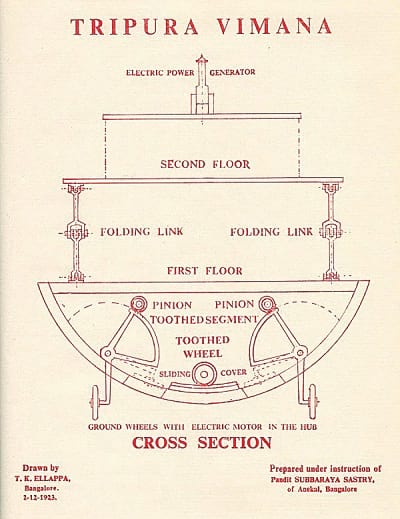
Vertical section of Tripura Vimana. (T.K.Ellappa / Wikimedia Commons)
Along with flying in the air, the Tripura vimana can move on land and water. It has wheels for land travel and these wheels are retracted when it moves in the water. The text does not provide its exact operational principles, but its power generator utilizes solar energy. It is an oval-shaped vimana, with a 100-foot length, 24-foot width, and 30-foot height. It is made of a light, fire resistant alloy.
So, can the Vimanas fly?
The researchers from the Indian Institute of Science in Bangalore, who carried out a study of the Vaimanika Shastra in 1974, expressed scepticism about the flying abilities of these planes. According to them, the geometries and the propulsion principles of the planes are too bizarre to make flying a possibility. At least, not by any currently known flying methods. Who knows, maybe the ancient Indians had advanced methods that we haven’t yet discovered. It is a pity that these weren’t clearly delineated in the text of the Vaimanika Shastra.
The Vaimanika Shastra in popular culture
In 1878, Dayananda Saraswati wrote a commentary on the Rigveda, which was published in 1929 as “Rigveda Bhashya Bhumika”. In this, he describes how flying machines operate and these descriptions are more in line with Newton’s Law of Motions.
In January 2015, the Vaimanika Shastra was mentioned in presentations made by a pilot Anand J. Bodas and Ameya Jadhav, a researcher with an M.Tech and an M.A. in Sanskrit at the 102nd Indian Science Congress at the Mumbai University. Shri Bodas informed the news media that, in Vedic times, huge-sized vimanas could fly in a variety of modes from country to country as well from planet to planet. This declaration riled the NASA scientist, Ram Prasad Gandhiraman, and he started an online petition to throw out this ‘pseudo-science’ presentation.
The Vaimanika Shastra is mentioned in ‘Prapaatha’, a 2015 Kannada film, and in ‘Hawaizaada’, a 2015 Hindi film.
Enrico Baccarini, an Italian journalist, has written several articles and books on ancient Indian vimanas.
Enjoyed this article? Also, check out “The Curious Disappearance of the Baghdad Battery: A Parthian Period Relic, An Oopart“.
Fact Analysis:
STSTW Media strives to deliver accurate information through careful research. However, things can go wrong. If you find the above article inaccurate or biased, please let us know at [email protected].
RELATED
The post Vaimanika Shastra – Treatise on Ancient Indian Flying Machines or Pseudoscience? appeared first on .
]]>The post The Superconducting Super Collider: How the USA Abandoned Its Most Expensive Science Project appeared first on .
]]>
Superconducting Super Collider (SSC) site. (Nick Russell / Light & Noise, Inc. / Used With Permission)
The Superconducting Super Collider was a gargantuan ring particle accelerator to facilitate high-energy proton collisions that the US government undertook to build in a massive underground complex in Waxahachie, Texas. If political and public opinions hadn’t forced the project to fold up midway, it would have been the largest accelerator in the world with the unsurpassed energy capacity of 20 trillion electron volts per proton. It is likely that, with the Superconducting Super Collider, the US scientists would have discovered the much-vaunted Higgs boson particle long before the European scientists did.
The Superconducting Super Collider
To understand what a ring particle accelerator is, we must take a look at particle physics which uses what the physicists call the Standard Model to explain the constitution of the universe. According to the Standard Model, leptons and quarks make up the observable matter in the universe and these particles act on each other due to gravitational force, electromagnetic force, strong force, and weak force. The physicists developed the idea of the Higgs boson to explain a major theoretical problem in this Standard Model about how the massless leptons came to acquire mass.
To observe these particles in action, it is necessary to have them collide with one another at high speeds. Such collisions can only take place in a high energy accelerator using superconducting magnets.

Cyclotron, the world’s first particle accelerator invented by Ernest O. Lawrence at the University of California in 1930. (Department of Energy. Office of Public Affairs / NAID)
Building the Superconducting Super Collider
The idea of building the Superconducting Super Collider came when the USA was still at the height of its economic power and taking on the biggest, best, and most ambitious projects was a matter of national pride. The Soviet Union had disintegrated, the Cold War was over, and the USA remained as the World’s self-described sole superpower. The Reagan administration greenlighted the accelerator project in 1987 – design on the project had already begun earlier in 1983 – and encouraged the scientists and administrators involved in it to ‘be greedy’. That is, to spare no pains and costs in spending the taxpayers’ money on this massive undertaking.
The US government and the scientists all hoped that building the biggest accelerator in the world would aid them in discovering the yet undiscovered mysteries of the universe. The theory of the Higgs particle had been put forward. The physicists assumed that building the Superconducting Super Collider would lead the way in its actual discovery. It would propel the USA and US scientist to the forefront of physics, and cement the USA’s place as the most scientifically advanced nations in the world.
The Accelerator Project Start
The project began with gusto under President Ronald Reagan. Once the government and the scientists had agreed that it was to be the biggest project ever, cost no bar, the organisers looked around the country for a suitable location and zeroed on to Waxahachie in Texas. It was a charming, small town of a few thousand inhabitants, and it had the perfect geology for digging tunnels. This was a very important criterion for an underground accelerator. Another plus point was that Waxahachie also had a stable climate with no danger of any natural disasters.

Drawing of the SSC campus area. (U.S. Department of Energy / Flickr)
Cost Escalations
Several foreign countries had initially agreed to help finance the project, but that was under the assumption that it would be a joint international venture. The tendency of the US Americans to speak about the project as a wholly US American enterprise that would benefit US interests in the main started to put off the would-be investors. Also, the Europeans already had the CERN laboratory in Switzerland – which had helped them discover the W and Z bosons in 1983 – and they were planning to build a new accelerator, the Large Hadron Collider, and it didn’t make sense for them to invest in the US American project instead of in their own.
In the end, none of the countries contributed anything. The USA tried to rope Japan in, but that plan collapsed after a trade dispute with Japan regarding selling its automobiles in the USA.
The US Department of Energy and the Texas state ended up shouldering most of the financial burden.
The initial financial estimates for the Superconducting Super Collider project amounted to $4.4 billion. According to a report that the Department of Energy published four years after the project’s shelving, this estimate failed to include several crucial costs, such as the financing required for purchasing the land for the project, for the project management, and for many other requirements. After the project was underway, the scientists decided that the ring magnet design needed an overhaul, with the addition of 10,000 magnets, and this ended up hiking costs further. In total, the project was going to need $12 billion for its completion.

Superconducting Super Collider magnets at National Museum of American History. (Ryan Somma / Flickr)
In 1992, the US House of Representatives voted against continuing the project, but, with the US Senate’s intervention, the project continued, albeit with a $100 million funding cut that had a serious impact on its construction. Costs continued to increase.
Project Abandoned
Bill Clinton, who followed George W. Bush as the President of the United States, was not particularly interested in continuing with the project. Also, the project found itself competing for funds with NASA’s space programs. Public opinion favoured space exploration over atomic exploration. The country was in a recession, moreover, and the public wasn’t enthusiastic about approving an unlimited governmental budget for science projects that didn’t offer any tangible results.
After the United States had spent $1.6 billion, with the state of Texas adding $279 million, on constructing the Superconducting Super Collider project and drilled several kilometres of tunnels and erected several buildings, constituting about 20% of the entire project, the axe fell. The US Congress decided it was no longer feasible to pour more money into the project, and the work came to a halt in October 1993.

Superconducting Super Collider tunnel under construction. (US Department of Energy)
The project had engaged around 2,000 people at its building stage and the management had planned on hiring more than 13,000 people on project completion. With the ignominious end of the project, the hired personnel all departed and the new jobs, of course, never materialized. The management abandoned the buildings and the tunnels.

A poster of the tunnel during construction. (Nick Russell / Light & Noise, Inc. / Used With Permission)
Aftermath
A millionaire from Arkansas, Johnnie Bryan Hunt, bought the abandoned site in 2006 for $.6.5 million and planned to build a data storage centre there. Six months later, however, he died in an accident, and his family was not interested in continuing with the project.

Inside the abandoned SSC facility. (Nick Russell / Light & Noise, Inc. / Used With Permission)
Then Magnablend, a chemical manufacturer, stepped in. They had a chemical factory in the area, and when a fire destroyed this factory, the company needed urgently to move to a new site. They bought the land from the Hunt family for $5 million and set up their new factory there. They had to face protests from the local farmers who were not happy to have a chemical factory smack bang in the centre of their farming community.
The main things that stand out with the abandonment of this project are the incredible mismanagement of taxpayers’ money, the lack of adequate project planning, and the ego-driven, politicized conflicts between the scientists, the US Department of Energy, and the politicians.
Instead of joining hands to build the biggest scientific marvel of our times, they ended up creating the most expensive hole in history. It was also a turning point for the USA’s scientific hegemony. With the new Large Hadron Collider at CERN, the Europeans beat them to discovering the Higgs particle on 4 July 2012.
Enjoyed this article? Also, check out “Duga Radar: Unravelling of the Mystery Behind the Soviet Woodpecker“.
Recommended Visit:
National Museum of American History | Washington, D.C., USA
Fact Analysis:
STSTW Media strives to deliver accurate information through careful research. However, things can go wrong. If you find the above article inaccurate or biased, please let us know at [email protected].
RELATED
The post The Superconducting Super Collider: How the USA Abandoned Its Most Expensive Science Project appeared first on .
]]>The post Decapitation and Consciousness: How Long Can a Decapitated Head Remain Conscious? appeared first on .
]]>
A man about to be executed by beheading. (Australian War Memorial)
The question of what constitutes consciousness and for how long a decapitated head remains consciousness is something that has long interested researchers and regular folks alike. Stories abound of decapitated heads showing eye movements and emotive facial expressions, but are they true or apocryphal? Exact verification of such instances is, of course, impossible.
Decapitation as a capital punishment
“Off with their heads!” cried the Red Queen in Alice in Wonderland, whenever someone displeased her. She was a fictional character, of course, but many real-life characters in the past shared her passion for separating people from their heads for actual crimes, perceived crimes, alleged crimes, and political crimes.
Beheading was a common form of capital punishment in the past centuries, and it is still practised in some countries, such as Saudi Arabia, Yemen, Iran, and Qatar. Executions often took place in public squares and huge crowds gathered to view these grisly spectacles, jeering, screaming, and even applauding the unfortunate fates of their fellow human beings. Sometimes, with hawkers calling out their wares and stalls set up to cater to the public, these events even took on a rather festive garb, and people even brought their children along. There are many stories of people knitting, eating, and gossiping as people were being guillotined during the French Revolution.
Around 40,000 people lost their lives to the guillotine in this period, and the bloodbath gives us some of the most gruesome anecdotes about the consciousness capacity of decapitated heads.
Notable incidents of decapitated retaining its consciousness
A famous example is of Charlotte Corday, the woman who assassinated Marat. After her execution, the executioner lifted her head up for public display and then proceeded to win some public acclaim for himself by insulting the dead woman with a couple of slaps. Onlookers claimed that, upon this, her cheeks flushed red and a look of anger crossed over her features.
In another instance, two members of the Committee for Public Safety, who had no liking for each other, got a taste of the guillotine blade one after the other. When the people assigned to clean-up checked the basket later, they found that the two enemies had not made peace with each other in death. Far from it, one of the heads had bitten the other and so severely that it wasn’t possible to separate them and they, perforce, went to the grave together.
The French scientist, Antoine Lavoisier, faced the guillotine in 1794 and apparently, he retained his scientific spirit to the last, informing his assistant to keep a close watch, he would try to wink at him, and then the world would know if a decapitated head really did retain its consciousness. In the end, though, he lost his head and forgot to wink. Of course, nobody knows if this story is true.
In 1905, a certain Dr. Beaurieux recounted his personal experience after the execution of a criminal named Henri Languille. The doctor called out to the executed man and Languille opened his eyes and looked straight at the doctor. This happened not once, but twice, and for around 30 seconds after decapitation, and the doctor claims that, in these few moments, Languille seemed perfectly conscious of what had happened to him.
Another hair-raising story involves a US marine, who was driving with a friend when they had an accident and the car overturned. The friend’s head decapitated right away in the crash. The marine saw his friend open his eyes and look towards his body and back at his friend with an expression of anguish and grief before he died.
In the case of animals, people have reported chicken heads remaining conscious for a few seconds after being decapitated.
The decapitation of Baba Deep Singh
A famous case of decapitation from India is that of Baba Deep Singh, who lived from 1682 to 1757. He was the leader of the Shaheedan Misl Tarna Dal, a Khalsa military unit that was part of 12 Misls that the Sikh Confederacy formed to counter the Mughals and protect the Sikh faith.
In 1757, the Sikhs clashed with the Afghan invader Ahmad Shah Durrani during his fourth invasion of the Indian subcontinent. Baba Deep Singh and the Misl Shaheedan attacked the Afghan army near Kurukshetra as they were returning to Kabul with prisoners and plundered loot from Northern India. The Sikhs successfully freed the prisoners and appropriated the loot. Enraged, Ahmad Shah Durrani ordered his forces to destroy the Harmandir Sahib in retaliation. They demolished the temple and polluted its holy water tank with slaughtered animals.

Portrait of Baba Deep Singh. (Wikimedia Commons)
Baba Deep Singh took it upon himself to avenge this desecration even if he fell at the Darbar Sahib, as he declared to the congregation at the Damdama Sabib. He started out with an army of 500 men and by the time they reached Amritsar the army had grown to over 5000 well-armed Sikhs.
In the fierce battle that ensued with the Afghans, Baba Deep Singh was decapitated. There are two accounts regarding this. In one, he was completely decapitated, but he didn’t let that stop him. Buoyed on by the shouted reminder from a fellow Sikh that he had pledged to reach the Harmandir Sahib shrine, he held his decapitated head in one hand and continued slaying the enemy with the sword in the other hand. He continued thus right up to the Harmandir Sahib and died when he reached there. In the second account, he was partially decapitated and, holding his head with one hand, continued battling until he reached the temple. As he had pledged, it was here that he let his head fall.
How credible are these decapitation accounts?
Many scientists scoff at and dismiss these stories as unreliable or as outright fabrications. They argue that it isn’t the last dying gasp of consciousness that produces the observed or claimed reactions, but the last reflexes of the dying brain.
But this too is an extraordinary claim to make given the lack of exact evidence and no real way to prove it. Facts are the cornerstones of science, or so we always hear, but we don’t know what the real facts are here. There is much about the brain and human consciousness that we have still to discover.
What happens after decapitation?
It is necessary to understand a bit about how the brain works to get a handle on this whole matter. What we know as brain activity is due to the electrical activity of the neurotransmitter chemicals in our brains that help neurons to communicate with each other and form neural networks. Everything we think about and feel is due to the pathways and activities of our neural networks.
The brain requires a constant supply of blood and oxygen to remain functional and keep the neural networks working. If these supplies are cut off, the brain will die. Decapitation severs the blood and oxygen supplies to the brain, and the inevitable happens. The person dies. The question is, how soon does death occur? Immediately? After a few seconds or after a few minutes? And, if it is after some seconds or minutes, does the brain retain its ability to think and feel in this time? Does the person experience grief and pain?
Electroencephalogram (EEG) test on mice
In 2011, four Dutch scientists carried out an experiment on lab mice to see how long they retained consciousness after being decapitated. They attached electroencephalography (EEG) wires to the brains of the mice and monitored the electrical activity in their brains. They discovered that the brains of the mice show electric activity in the range of 13–100 Hz for about 4 seconds after being decapitated. This is the frequency range for cognitive activity. The scientists observed a further wave activity 50 to 80 seconds after decapitation. The 13-100 Hz ranges come within what we recognize as consciousness, and this might signify that the mice experienced some form of consciousness after decapitation.
This is quite an extraordinary finding. Since labs use mice to test issues that are compatible with humans, we might surmise that it might be a similar case for humans.
It is certainly a difficult matter to verify. Beheadings are not as in vogue as they once were and not even the most scientific-minded purist is going to volunteer himself or herself for the sake of enlightening the world on this matter. In the end, we are not likely to find what the verifiable truth is in this matter.
Enjoyed this article? Also, check out “21 Grams Experiment by Duncan: A Glorious Attempt to Measure Human Soul“.
Fact Analysis:
STSTW Media strives to deliver accurate information through careful research. However, things can go wrong. If you find the above article inaccurate or biased, please let us know at [email protected].
RELATED
The post Decapitation and Consciousness: How Long Can a Decapitated Head Remain Conscious? appeared first on .
]]>The post Luigi Galvani: The Man Who Fuelled the Idea of Re-Animating Human Corpses appeared first on .
]]>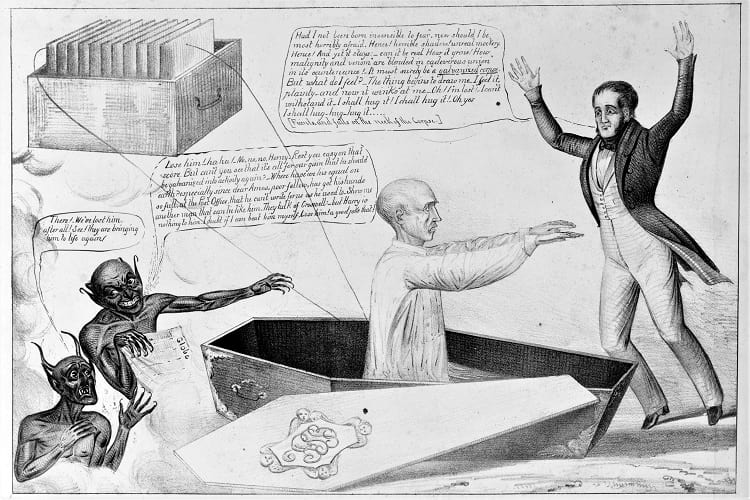
Luigi Galvani: A galvanised corpse art. (Henry Robinson / N.Y. ; Washington, D.C)
Death is inevitable. And no living organism – whether big or small – can escape it. After a human being dies, rigor mortis sets in and the dead body starts to stiffen, as all physiological functions start to shut down one by one. But once a person passes away and his bodily functions stop, does the corpse have the capability to move on its own or by applying an external force to it?
Luigi Galvani was one such physician and biologist, who through his experiments on animal corpses reached the conclusion that when electricity is passed through a dead body, it twitches, thus giving rise to the term bioelectromagnetics.
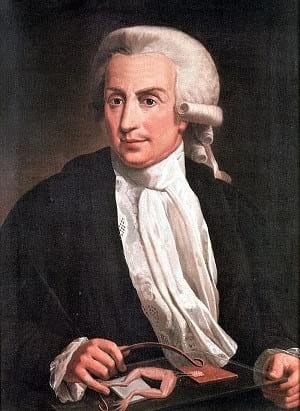
Painting of Luigi Galvani with frog legs. (Wikimedia Commons)
Born in Italy to a physician father in 1737, it was but natural for young Luigi Galvani to have an inclination towards medicine. He obtained his degree of medicine in 1759 from the University of Bologna, Italy, where he also started delivering lectures in the field of anatomy. He was also appointed as a professor of obstetrics at the Institute of Arts and Science.
In the year 1762, Galvani married Lucia, daughter of his mentor Professor Gusmano Galeazzi, where post the death of his father-in-law, he carried forward the former’s research works. Galvani had developed a keen interest in animal anatomy while delivering lectures at college, which led him to start his investigative work in the same field.
Luigi Galvani’s experiments on dead animals
If legends are anything to go by, Lucia is once said to have developed tuberculosis in 1780. With her condition deteriorating, she asked her cooks to prepare frog soup, which would cure her of the disease soon.
While the servants struggled to find a place to start preparing soup in a large quantity for her, Lucia ordered them to keep the frogs and other ingredients in her husband’s lab. One servant placed a skinned frog close to an electrical machine and Lucia, who was supervising her cooks, witnessed something out of the ordinary.
When the cook picked up a knife, a spark flew from the electrical machine and touched it. And when the knife touched the frog in turn, the dead animal’s legs twitched and that is how Luigi Galvani is said to have come across the phenomenon. Social scientists argue that it was Lucia Galvani, who deserves to be credited with the theory of bioelectromagnetics, for her desire to have frog soup, but loyalists think otherwise.
Although the frog soup theory is debated, the twitching of a dead frog’s legs, however, is part of the original experiment that Galvani carried out in his laboratory. Facing tough competition from his contemporaries like Alessandro Volta and Benjamin Franklin, Galvani became the first scientist to discover that electricity had the capability to alter physiological actions in a dead body.
He observed that muscles and tissues in animal corpses contained bioelectric forces and they contracted when electricity touched them with a metal conductor. His ten years of extensive research in the field eventually led him into a controversy with his competitors, even though they admired him for his work.
Galvani’s experiments on dead animals led common people to believe that the biologist had come to know the hidden meaning of life and that he had received the extraordinary power to bring the dead back to life. Although nothing of that sort happened, his subsequent invention of the galvanometer and the entire process known as Galvanism has now become a part of the modern science curriculum all over the world. Also, the modern techniques of application of electric shocks to cure an array of medical conditions like paralysis and rheumatism, stemmed from Luigi Galvani’s experiments back in the 1700s.
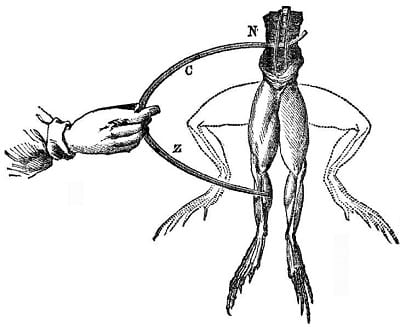
Luigi Galvani’s experiment on stimulation of muscle in a dead frog. (ITU Pictures / Flickr)
Frankenstein; or, the Modern Prometheus by Mary Wollstonecraft
Renowned English novelist Mary Shelley, who wrote the cult classic Frankenstein, Or The Modern Prometheus is said to have been inspired by Luigi Galvani’s experiments and written the spooky story of the famous re-animated corpse. While on a holiday in Geneva, the process of galvanism gave her the idea to write her most famous book in 1818. It told the story of a mad scientist, Dr. Victor Frankenstein, who creates a grotesque monster by joining together parts of a dead human body and passing an electric current through it to bring it back to life.
Shelley is also said to have acknowledged her source of inspiration and written about the term Galvanism in one of the paragraphs of her bestselling novel.
How his works influenced others
After Volta coined the term galvanism in his honour, Galvani went on to carry out research work in the field of bioelectromagnetics for a long time, while also working on his experiments simultaneously. But in the year 1790, Luigi Galvani’s health began to decline post his wife’s death due to TB. This came as a setback to him and his work began getting affected too. In 1796, Napoleon invaded Bologna, which forced the biologist to quit working finally. Galvani moved into his ancestral home with his brother, where he breathed his last, two years later in 1798, leaving behind a legacy that is more than two centuries old.
After Galvani died, his nephew decided to carry forward his legacy and so in the year 1803, Giovanni Aldini pioneered the art of reanimation of human corpses. In London, a twenty-six-year-old George Forster was executed for murdering his wife and child and the freshly decapitated body of the criminal was brought to Aldini, who was on a Europe tour, demonstrating his skills.
Aldini attached copper and zinc batteries to the dead body and passed current through it. Bystanders saw that the cadaver’s jaw and facial muscles began twitching and one eye opened due to the quivering. A little while later, when Aldini reattached the poles of the battery to other parts of the body, the entire corpse began to move as if dancing in a reanimated form, leaving audiences spellbound as well as spooked out. He carried out his experimental shows in different parts of the continent and also began working on carcasses publically.
Luigi Galvani dedicated his entire life to studying the effects of electricity on dead animals after discovering it by chance at his lab, but the need to feed people’s curiosity to know more in the field gave his nephew a grisly opportunity to work on human cadavers. Common people might not understand what galvanism or a galvanometer would mean, but Mary Shelley’s story of Frankenstein surely gives them a peek into his fruitful and rich heritage.
Enjoyed this article? Also, check out “Dr. Robert E. Cornish’s Controversial Experiments to Revive a Dog’s Decapitated Head“.
Recommended Read:
An Account of the Late Improvements in Galvanism: With a Series of Curious and Interesting Experiments Performed Before the Commissioners of the French National Institute, and Repeated Lately in the Anatomical Theatres of London | By Giovanni Aldini, Hooper Robert 1773-1835
Fact Analysis:
STSTW Media strives to deliver accurate information through careful research. However, things can go wrong. If you find the above article inaccurate or biased, please let us know at [email protected].
RELATED
The post Luigi Galvani: The Man Who Fuelled the Idea of Re-Animating Human Corpses appeared first on .
]]>The post Jose Delgado, the Pioneer of Electric Brain Stimulation Tamed a Raging Bull with Radio Control appeared first on .
]]>
Photo of bullfighting used for illustration. (pxhere)
Jose Manuel Rodríguez Delgado also known as “the pioneer of electric brain stimulation” was born on August 8, 1915 in Ronda, Spain. He was a physiology professor at the prestigious Ivy League Yale University in New Haven, Connecticut.
Delgado was prominently known for his tests administering electric stimuli to the brain to control the mind. His renowned experiment in 1964 with a bull in Cordoba, Spain earned him the phrase – “The man who fought a bull with mind control“.
Jose Delgado’s obsession with the brain
Jose Delgado wanted to follow his ophthalmologist father’s footsteps and proceeded to study medicine and physiology at the University of Madrid in 1933. Whilst studying medicine, he became greatly intrigued by the ‘Father of Neuroscience’ Santiago Ramon y Cajal (1906 Nobel Laureate).

Santiago Ramón y Cajal. (Clark University)
With the onset of the Spanish War in 1936, Delgado still a medical student, served the Republicans as a medical corpsman. Unfortunately, the war ended in March 1939 with the defeat of the Republicans, and Delgado was put in a concentration camp for five months which compelled him to think about the neurons that lead to violent behaviour.
After being released, he went back to complete his medical studies and earn a PhD in physiology from the Ramón y Cajal Institute in Madrid.
Jose Delgado was captivated in particular, by the experiments that the Swiss physiologist Walter Rudolf Hess was conducting. Hess had established that electrodes could be effectively used to stimulate a particular part of the brain in order to extract responses. His tests had proved that an element of the brain, the hypothalamus, could be stimulated to bring out various reactions.
Hess went on to win the Nobel Prize in Physiology or Medicine, in 1949 for his work. Meanwhile, in 1946, Delgado won a fellowship for a year at Yale. He later went on to accept a position in the physiology department at the same university, headed by Dr John Farquhar Fulton, in 1950.

John Farquhar Fulton. (Wellcome Collection)
Fulton was a Sterling Professor of Physiology at Yale since 1929, having been appointed at the young age of 30. It is a premier university rank at Yale, given to a tenured faculty member who is considered the best in their field. Fulton was a pioneer in psychiatry.
The era of lobotomy
Fulton and his colleague Dr Carlyle Ferdinand Jacobsen presented a paper on the brain experiments they had conducted on chimpanzees at an international forum. These experiments described at the Second International Neurological Congress in London, held in July 1935, gave the idea of psychosurgery to Portuguese neurologist, Dr Antonio Egas Moniz.
Fulton and Jacobsen removed a part of the frontal lobe of chimpanzees. Though there was no change in the level of intelligence, the chimpanzees had become aggressive. They then proceeded to completely remove the prefrontal lobe and again saw a change in the temperament. The chimps had become docile and submissive. Thus, implying the significance of the frontal lobe in determining temperament or behaviour.
Moniz thought of performing a similar surgery on patients with mental illnesses. Inspired by Fulton’s paper, Moniz directed the first prefrontal leucotomy on a human being, performed by his associate Almeida Lima at the Hospital Santa Marta in Lisbon on November 12, 1935. This was the beginning of leucotomies on patients with psychosis, which Moniz asserted, gave the desired results.
Fulton was initially upset that a test conducted on chimpanzees had lead to surgeries on humans. Moniz was constantly in touch with him to refine the procedure and later on, Fulton became a sceptical supporter. Moniz also received the Nobel Prize in Physiology or Medicine, in 1949 for his leucotomy procedure. Walter Jackson Freeman II and James Winston Watts modified the procedure in the United States. It was made less invasive and renamed, lobotomy.
By 1951, United States alone reported of the maximum number of lobotomies performed, but by mid-1950s, lobotomy was renounced with the development of successful psychiatric medicines.
The groundbreaking invention

1902: Early attempts to use the brain for receiving radio waves by US radio engineer Archie Frederick Collins. (Archie Frederick Collins “The effect of electric waves on the human brain“)
Jose Delgado was horrified at the idea of lobotomy and completely against the thought of obliterating a section of the brain. His ideas were more in accordance with the experiments of Walter Rudolph Hess. Delgado was well known as someone who would improve technology for getting the desired result with minimum or no damages. So much so, that he came to be known as a “technological wizard“.
He believed in electrical implants in the brain that would pass small currents to control the behaviour of the patient. His primitive experiments consisted of implanted electrodes with wires connecting to electronic devices. This, unfortunately was a risky procedure as it curtailed the movements of the subject, and left the brain susceptible to infections.
Delgado went on to design the stimoceiver, a small implanted electrode that was radio controlled to send electric impulses into the specific area of treatment. Delgado wanted to completely eliminate the butchering of the brain with this invention. After experimenting on animals, he extended his research to patients of schizophrenia and epilepsy, and implanted electrodes in nearly 25 such patients.
Delgado co-authored his first ever peer-reviewed paper in 1952 on the effects of electrode implantation in humans. He further designed the chemitrode, an implant that would administer a precise amount of drug straight into the desired portion of the brain. He is also credited for developing the early version of the cardiac pacemaker.
Taming bulls and other animals
Dr Jose Manuel Rodríguez Delgado’s most prominent experiment is with a Spanish fighter bull, Lucero in 1964 in Cordoba, Spain on the La Alamirilla ranch owned by Don Ramón Sánchez. Lucero had been sedated and implanted with electrodes that were remote-controlled by Delgado. In the bullfighting ring, with the red cape in his right hand and the wireless control in his left, Delgado turned the stimulation on as soon as Lucero was a couple of metres away from him.
The result was an aggressively charging bull coming to a screeching halt. The animal lowered its tail and seemed to have lost its violence. However, when Delgado stopped the stimulus after exiting the ring, the bull went on to ram the enclosure. On May 17 in 1965, the New York Times published his experiment on the front page with the headline “Matador With a Radio Stops Wired Bull“.
Even though this event created a lot of interest in Delgado’s work, he was of the belief that his experiments with simians and apes were of more significance. In a trial with a female chimpanzee, Paddy, Delgado fitted a stimoceiver in the chimp’s amygdala and hooked it up to a computer. Every time a signal was detected from that part of her brain, the computer generated a punishing stimulus to her central gray area.
As this went on, Paddy’s amygdala produced fewer signals over the hours, thus making her quieter and less aggressive. Jose Delgado conjectured that this method could probably be used in humans to stop seizures and other disorders generated by signals within the brain.
Jose Delgado was obsessed with that portion of the brain which was responsible for aggression and the area that held back the aggression. In an effort to study this, Delgado implanted a stimoceiver in a monkey that was prone to bullying. The electrode was to generate a stimulus in the caudate nucleus of the brain, which controls voluntary movements. This would send an electrical impulse to pacify the animal. The lever that would pacify the bully, was installed in the same cage in which the monkeys were. A female monkey realised the power of the lever that controlled the stimoceiver and every time she was threatened by the belligerent bully, she would press the lever.
Comparing the monkey’s traits to humans, Jose Delgado wrote: “The old dream of an individual overpowering the strength of a dictator by remote control has been fulfilled, at least in our monkey colonies“.
The end of an era and of a pioneer
Jose Manuel Rodríguez Delgado wrote a134 scientific papers that were published between 1950 to 1970 on the electrical stimulations he performed in cats, monkeys and humans. In his book “Physical Control of the Mind: Toward a Psychocivilised Society“, Delgado talks about the taming and civilisation of the inner being. Not only was the book shrouded in controversy but so was Delgado’s work.
He was blamed for trying to control the minds of his patients. During this time, he was requested by Villar Palasi, the Education Minister of Spain to help in the setting up of a medical school at the Autonomous University of Madrid. Delgado accepted the offer and, moved to Spain with his family, in 1974. Delgado and Caroline, daughter of a Yale administrator, married in 1965.
They had two children, and Caroline often assisted Jose Delgado in his trials and study. Delgado became the world’s most renowned and controversial scientist. It was his vision to rid humanity of psychological turmoil and hostile behaviour. His cutting-edge work on brain stimulation remains unrecognised and unappreciated.
In 2005, they moved from Spain to San Diego in California in order to be close to their children who were settled in the United States. He passed away on September 15 2011, at the age of 96. After decades of research, the human brain is still an enigma. Though much is known now than before, research on electrical implants has restarted in an effort to treat patients with a crippling neurological disorder.
Enjoyed this article? Also, check out “Project MKUltra: CIA’s Cold War Conspiracy to Secretly Control Human Mind Goes Wrong“.
Fact Analysis:
STSTW Media strives to deliver accurate information through careful research. However, things can go wrong. If you find the above article inaccurate or biased, please let us know at [email protected].
RELATED
The post Jose Delgado, the Pioneer of Electric Brain Stimulation Tamed a Raging Bull with Radio Control appeared first on .
]]>The post The Amazing HeroRATs and their Keenness to Detect Landmines and Tuberculosis appeared first on .
]]>
HeroRATs: Rats trained by APOPO on field detecting landmines. (© APOPO)
APOPO which stands for “Anti-Personnel Landmines Removal Product Development” is a world-renowned non-governmental organisation founded by Bart Weetjens, a Belgian rat-enthusiast. The Tanzanian based NGO is involved in several humanitarian pursuits; one of the most noteworthy being the training offered by them to giant-sized pouched rats (Cricetomys gambianus) to detect spots of landmines and outbreak of tuberculosis (TB). These are the two primary menaces that have plagued the African landscape since long.
There are more than 60 countries where gruesome disasters and accidents take place because of life-threatening landmines and other explosives in war-torn areas. These occurrences impede the nation’s progress and development besides precipitating untold casualties and injuries.
On an absolutely different spectrum, inaccurate and time-consuming methods to detect tuberculosis make it one of the world’s most infectious and lethal diseases. Statistics show an average annual TB contraction of 10 million people out of which around 1.8 million succumb to the disease whereas approximately 3 million cases remain undiagnosed.
The APOPO rats which are extremely sensitive to smell have earned the much-deserving byname ‘HeroRATs’. These rats give back a safe and secure land to the communities congenial for growth and development.
The inception of APOPO
Founder Bart Weetjens stood firm in looking for an all-encompassing resolution of a local problem with the help of locally generated resources. His prime objective was to fix on an agreeable and affordable solution which communities could put to use rather than taking recourse to expensive techniques with integrated foreign technology.
According to Weetjens, the principal advantage of using rodents lies in the fact that they can be trained and procured aplenty in a cost-effective manner.
Each sniffing Apopo rat comes at an average price of $7,600, inclusive of administrative and operating expenses. On the contrary, a sniffer dog might cost more than three times as much only to train.
Advantages of employing the southern giant pouched rat

HeroRats undergoing field training. (© APOPO)
Feather-weight to tread on the landmines: The pouched rats have an average lifespan of 8 years. So they turn up as a pretty good investment. Furthermore, the critters are excessively lightweight to walk over the landmines without triggering them. They apply their nasal hunch to find out the precise location of the explosive. As of date, Apopo has amassed the goodwill of zero casualties.
Rapid detection of landmines: On the counter, one giant pouched rat can forage an area of more 2000 square feet in a time span of 20 minutes. A similar human action would take up to four days to accomplish.
Attuned to climatic variations: The rats are native species of the Sub-Saharan tropical zone of Africa. They are accustomed to the prevailing weather and resilient to pandemic diseases. Minimal resources are required to train and raise a rat to its adulthood.
Lightning fast pace to check Tuberculosis (TB) bacteria: In the case of detecting TB, the major advantage is the speed at which the rats execute the task. Standard examining procedures at public clinics involve the use of a microscope to detect TB, which is slow and sometimes incorrect. As per records set by APOPO, a trained rat can assess 40 samples in 7 minutes.
Training the rats
Training the rats to detect landmines is not an easy process. Firstly, the rodents, just at their infancy, need to pick up the learning acumen to be in the vicinage of humans. Secondly, these gnawing animals do not possess the ability to fling back to verbal instructions. Hence, the trainers uniquely teach them with a clicking sound which implies their earnings in the form of food rewards (usually peanuts or bananas). Finally, the rats are trained to cling on to trappings and harnesses and walk over tight ropes suspended between two handlers across the fields.
Rats intended for mine-detection are initially shifted to a sandbox where they are made accustomed with the scent of explosives by sniffing out TNT-suffused tea balls. Ultimately, they are drilled on a test field that accommodates both active and inactive mines.
At the time of discovering a potential landmine, the trained skilful rats break off and scratch the TNT-scented location. The human de-miners then put a mark on the spot and later return to excavate the area. If they discover a landmine underneath the spot, they detonate it immediately.
The overall training takes nearly nine months for each rat. Since the animals live for only eight years, it becomes burdensome for an animal with a fairly short lifetime to receive this elaborate training and perform to the finest standards of excellence.
It is to be noted that rats only form a component of an integrated demining operation. Pieces of equipment like metal detectors and mechanical demining gears still remain indispensable. Till 2016, the HeroRATs surveyed over 270 square miles of farmlands in Mozambique. The rodents’ uncovered 13,826 mines, discovered 29,031 small-sized ammunitions and 39,601 unexploded ammunition.
Training rats to diagnose tuberculosis

HeroRats undergoing training to detect TB. (© APOPO)
In this scenario also, the rats undergo nine months of training. The rats are given lessons to recognise the odour of typical molecules that indicate the existence of the tuberculosis germs. Sputum samples that are already examined through conventional tests are rechecked by the rats. They sniff through a series of holes in an enclosed glass chamber that houses the sputum samples. When a rat becomes aware of TB, it signals by brushing its nose against the particular sample aperture or scratching on the floor of the cage.
Future prospects of HeroRATs
At the present time, the United States is analyzing the usage of the rats to curb unlawful trafficking of wildlife. Detection of commonly occurring cancer ailments and other degenerative neurological maladies such as Alzheimer’s and Parkinson’s can be accomplished with the help of these smart rodents. In disaster-struck zones, HeroRATs can serve to locate and save victims buried under the rubble.
Enjoyed this article? Also, check out “Insects from Hell: Mecoptera, the Fly with a Scorpion Tail“.
Fact Analysis:
STSTW Media strives to deliver accurate information through careful research. However, things can go wrong. If you find the above article inaccurate or biased, please let us know at [email protected].
RELATED
The post The Amazing HeroRATs and their Keenness to Detect Landmines and Tuberculosis appeared first on .
]]>The post Halley Research Station: The First Floating, Relocatable Research Facility in the World appeared first on .
]]>
Halley research station. (Forgemind ArchiMedia / Flickr)
Antarctica is an amazing and distinct continent. As per the records, this windiest, coldest, driest and harshest place is the last one to have been discovered on our planet. The average temperatures in this continent in the southern hemisphere can sometimes dip to as low as minus 90 degrees Celsius. But that does not make it so peculiar. One of the world’s first floating research facilities on this continent is what makes it even more unusual.
The British Antarctic Survey’s scientific research centre called Halley Research Station is one of the several peculiarities in Antarctica, which is nothing short of a wonder. The construction work of Halley Research Station began in the year 1956 and it was built on the 150 metre-thick Brunt Ice Shelf, which is a large floating sheet of ice attached to the mainland.
Over all these years, the one-of-a-kind research station, now called Halley VI, has become a mix of several facilities all rolled into one. It monitors the ozone activity, studies the Earth’s atmosphere; it houses a meteorological centre and also has its own space weather observatory. But what is so fascinating about this research centre is that it is built on a floating sheet of ice and can be relocated as separate modules or as a single unit during times of crisis.
The facility

Portrait of Emond Halley. (Richard Phillips / Wikimedia Commons)
The research station was named after English astronomer and mathematician Edmond Halley. In the year 1957, after construction work of the station was completed, the research centre underwent quite a few changes and came to be officially known as ‘Halley VI’ in February 2013.
Halley VI was the first research centre that discovered the ozone layer way back in 1985. The colourful structure, built on hydraulic skis is also the world’s first ground research station that can be completely relocated from time to time. The futuristic facility is fully equipped with state-of-the-art housing areas and modern labs, where scientists brainstorm on issues related to global climate change and rising sea levels.
Out of the total eight interlinked, relocatable modules, the central unit is for socializing, while the other pods house laboratories, offices and dwelling spaces. The research station also has its own magnetometer, weather balloons, mechanical workshops and radars.

Weather balloons being released near the Halley Research Center. (NASA)
A GPS receiver constantly monitors the movement of the ice shelf on which the research facility sits, for fear of it floating away from the main landmass. There are dangers of the ice sheet calving off as a drifting iceberg into the ocean but the tracker can quickly notify before disaster strikes.
Halley VI roughly accommodates 70 scientists and staff members in Antarctic summer, which lasts from January to March. On the contrary, there are approximately only 15 to 16 scientists to carry on with the research work during the harsh winter months on the continent.
The staff members include cooks, doctors that monitor health during the extreme conditions, engineers to look after the logistics of the facility and scientists that are all experts in their respective fields. Being one of the most isolated places on the earth, the inhabitants of Halley VI only have each other for company, with a few Antarctic animals outside the pod.
Although residing inside a module for scientific studies can be a tough day in and day out, the best part of staying during winter months for scientists is the Aurora Australis that is on display at nights. With prolonged darkness for a period of over 105 days together, the natural display of colours keeps the inhabitants going.

One of the modules of Halley VI Research Station with aurora australis in the background. (Richard Burt / Flickr)
Apart from studying ozone depletion and producing accurate weather forecasts, Halley VI doubles up as a natural lab, which provides an exceptional environment to look into human behaviour on test flights. In collaboration with the European Space Agency, Halley VI is also equipped with a cockpit simulator, similar to Russia’s Soyuz spacecraft, which helps in testing human behaviour on manned international space flights on lunar missions or future manned missions to Mars.
Life at Halley Research Station

Emperor penguin. (Christopher Michel / Flickr)
A typical week at Halley VI consists of scientists engaging in research work related to the changing climate, rising sea levels and atmospheric weather mapping by day. Apart from hectic schedules, they also take part in relaxation activities like playing games, building igloos, throwing parties, celebrating Christmas, watching the Milky Way on a clear night and spotting colonies of Emperor penguins that keep them entertained.
The RRS Ernest Shackleton – a transport ship – visits the research station every once in a year in December to supply cargo and ferry research passengers to and fro from the base. Stopping by for almost a week, the vessel equipped with its own small research facility, loads and unloads necessary goods and commodities at the station.
Researchers at the unit are also provided with heavy snowmobiles called Sno-Cats and light snow vehicles like Challenger 756B that speed up ferrying work from the coast towards the facility in the thick snow.

Halley research station. (Forgemind ArchiMedia / Flickr)
In cases of emergencies, inhabitants are taken to safer places, the weather labs keep functioning automatically inside, collecting data from the pre-installed solar batteries. But during extremely harsh winter weather, all experiments are suspended and Halley VI comes to a standstill.
Recently in December 2017, satellite images showed a 17-km-deep fissure in the north and east side of the ice sheet. Since it was spotted on October 31, it came to be known as “Halloween Crack“. Because of this developing fissure in the ice sheet, the 200-tonne hi-tech pods were immediately shifted and staff members were sent away. The heavy glacial activity also suspended work on the station. The relocation to the new site was successful but the deteriorating weather and snow storms only forced the shutdown of the systems. The facility is expected to begin work in November 2018, which will be the onset of summer in Antarctica.
Despite all the hurdles, Halley VI has overcome all obstacles and has relentlessly worked in the environmental and space research fields for over six decades, and has given us many new insights into the Earth’s southernmost polar region.
Enjoyed this article? Also, check out “McMurdo Station: The Largest Research Centre in the Antarctic“.
Fact Analysis:
STSTW Media strives to deliver accurate information through careful research. However, things can go wrong. If you find the above article inaccurate or biased, please let us know at [email protected].
RELATED
The post Halley Research Station: The First Floating, Relocatable Research Facility in the World appeared first on .
]]>The post Tesla Tower: The Tragic Story of Nikola Tesla’s Wardenclyffe Wireless Station appeared first on .
]]>
Tesla Tower in 1904. (Marc Seifer Archives)
Wardenclyffe Tower (1901– 1917), otherwise called the Tesla Tower, was an ancient but novel exploratory remote transmission station that was envisioned and established by Nikola Tesla in New York between 1901 and 1902.
Tesla’s prime intent was to put on the air telephony, messages and facsimile images to England across the Atlantic Ocean and to ships adrift. This was in the light of his speculations to conduct signals utilizing the Earth.
The genesis of Tesla Tower or Wardenclyffe tower

Nikola Tesla. (Napoleon Sarony / Wikimedia Commons)
Nikola Tesla made a dramatic and triumphant entry in the twentieth century, at the zenith of his career. Through his sojourn, still, at his acme, he aspired to bring to fruition, the Tesla Tower, the behemoth of all his historic inventions.
The tower promised to be a cutting-edge universal telecommunication system. His avant-garde theory was eventually shown the go-ahead in 1901. Yet in under a year’s time, the project ran into gloom and doldrums that ultimately wrecked Tesla both scientifically and economically. What really transpired during the year?
Financing of Tesla Tower
The splendid inventions of Tesla between 1856 and 1943 had ushered in the technology of alternating current. It made supplying power and illuminating big cities conceivable.
His experimental nerve centre at the high altitudes in Colorado Springs bears testimony to his countless entrancing achievements, which he had the privilege and resources to accomplish.
Tesla returned to New York in January 1900. There, he made several rounds trying to woo investors at the Waldorf-Astoria’s Palm Garden (where he then was put up), The Players Club and Delmonico’s whilst wining and dining with them.
He initially approached friend George Westinghouse who declined to put money into the project as he had a remarkable mind for business. He, however, lent Tesla $6,000. Westinghouse advised Tesla to pursue some wealthy venture capitalists.
Tesla consequently engaged in multiple talkfests with rich investors like Thomas Fortune Ryan, John Jacob Astor, and Henry Havemeyer. However, nothing worthwhile fructified.

American banker J.P. Morgan. (Pach Brothers / LOC)
In November 1900, Tesla picked up the attention of financing mogul J. P. Morgan. Tesla seduced him to sign a contract valued at $150,000 to build and develop the wireless station of the mammoth, futuristic and stupefying Tesla Tower in March 1901.
Morgan was actually fascinated by the grand slam of Guglielmo Marconi, Tesla’s rival that sent reports from America’s Cup yacht at Long Island to New York City by dint of wireless radio. Morgan had early doubts about the viability and patent priority of Tesla’s plan.
However, through several rounds of conversations, Tesla assured and convinced Morgan about the superiority of his proposed plan and how it superseded the patent of Marconi. He asserted that his wireless project would far outsmart Marconi’s.
Construction of Tesla Tower
After acquiring Morgan’s investment, Tesla began his work immediately. He purchased a 200-acre plot in Long Island. Large electrical transformers and generators were commissioned as was needed by the Westinghouse Electric Company.
Tesla promptly employed the prominent architect Stanford White who too was taken with Tesla’s idea. Both of them took to designing a gigantic wooden tower with a height of 187 feet and a metal hemispherical dome (known as cupola) of 68 feet diameter.

Nikola Tesla’s Wardenclyffe wireless station. (Arthur B. Reeve / Tesla and his Wireless Age)
The architecture of the telecommunication station, inspired by the Italian Renaissance, housed the main premise, research laboratories and several other facilities.
In July 1901, Tesla briefed Morgan on some more prospective modifications in the project to generate an enhanced, awe-inspiring plan, a virtual quantum leap ahead of his competitors to garner significant profits. This was primarily to pick up a high ground over Marconi.
He professed that he would be able to dispatch Morse code messages transatlantic alongside simultaneously transmitting long-distance wireless electricity.
With Tesla essentially inviting a breach of contract, Morgan, point blank denied lending surplus funds. He rather demanded an explanation for the capital already expended.
Regardless of Morgan doling out no extra funds, Tesla proceeded with the venture. He broached upon the idea to build numerous smaller towers or a tower with a height range of 300 feet to 600 feet.
This would have transmitted the low-frequency waves which Tesla believed were necessary for resonance in the Earth. Then, White estimated that the proposed revamp of 600 feet would cost $450,000. The plan instantly was written off.
In September 1901, Tesla needed to commence the tower construction remaining consistent with the original plan. After two months, the project suffered another major setback.
Marconi by then had figured out how to send the alphabet “S” in Morse code over the ocean between England and Newfoundland in Canada. Tesla protested against the Italian’s alleged utilization of 17 of Tesla’s licenses.
However, finally, the prosecution supported Marconi and by that time the commercial damage was already rendered. In those times of financial vulnerability, funders preferred investing in the Marconi system, which being less resourceful had made notable progress.
Dereliction of Tesla Tower
In 1906, Tesla suffered a series of nervous breakdowns because of the mounting financial problems. He was exhibiting signs of obsessive-compulsive disorder and later became a potential high-functioning autistic.
Tesla’s chief manager, who supervised Wardenclyffe, left the job to find other employment opportunities. The neighbours around the tower found it to be deserted without any intimation.
In 1904, Tesla put the Wardenclyffe property on mortgage, for covering his staying expenses to George C. Boldt, the owner of Waldorf-Astoria Hotel. In 1908, Tesla secured another mortgage to further meet his expenses.
Around 1911, the facility was partially forsaken and the structure of the tower started disintegrating. From 1912 to 1915, Tesla’s financing details were disentangled. Much to their dismay and displeasure, when the financers enquired about the ways to recover their investments, Tesla was not able to give acceptable answers.
Demolition of Tesla Tower
Tesla’s total cumulative debt to Waldorf-Astoria was close to $20,000 by mid-1915. Because of severe negligence and financial setbacks, Tesla became completely incapacitated to make repayments for the mortgages.
It was Boldt who then decided to foreclose the Wardenclyffe property. Boldt found the property totally useless and ultimately made up his mind to demolish the tower and sell it as scraps. It was the Smiley Steel Company who began dismantling the tower by dynamite explosions on July 4, 1917.
The work was completed in the month of September and the razed tower was sold off as scrap at an estimated value of $1750. The main facility was breached and vandalized. It turned out to be a manufactory of photographic material, down to AGFA closing it in 1992.
Malicious rumour of German spies
However, in course of the World War I, a vicious rumour spread like a wildfire in most newspapers and different publications. It was conjectured that Wardenclyffe was decimated after receiving orders from the then US government.
The officials had apprehensions that German undercover agents were putting the tower to work as an observation post, a radio transmitter or as a marker for German submarines.
Tesla was highly dejected when he learnt about this rumour that questioned his layers of patriotism. But he avoided speaking out to the press and revealing the genuine reason for the demolition. This was because he kept his association with Boldt and the related accounts about the mortgage off from the public.
What happened after the dismantling?
Between 1980 and 2000, the hazardous wastes from the photographic age were cleaned up. The site was disposed of and green-lighted for a new development.
IndieGogo, a grassroots campaign by two Russian physicists, managed to succeed in purchasing and saving the property with the sole aim to build a museum in the memory of Nikola Tesla. In 2018, was site was registered as a heritage spot in the National Register of Historic Places.
Resurrection of Wardenclyffe
As per last reports from Reuters available in the records, in 2014, two Russian physicist brothers Leonid and Sergey Plekhanov started to raise funds for the revival of Tesla’s progressive project.
Subsequent to investigating Tesla’s journals and plans, the Plekhanovs believed that with the help of ultra-modern solar panels, lighter building construction materials and $800,000, they can reconstruct the Tesla Tower.
The Plekhanovs have conducted basic research and analysis, executed the computational models and composed every part of the test. They trusted that with the proposed architecture in place, they have the ability to transmit energy and measure the results.
The Plekhanovs’ exploration appraises that around 38,000 square miles construction of solar panels amid a desert close to the equator could produce adequate power to supply the world’s electricity requirements.
Tesla’s pinnacle could deliver electricity to the consumers, but the only means to accomplish this concept is to rebuild it and discover. As of the latest publication, they have successfully raised assets worth over $40,000 through crowdfunding, for the venture through the IndieGoGo kick starter campaign.
End of the line
Tesla’s ultimate wish was to generate electricity from the gigantic resources of the Power Plant adjoining the Niagara Falls and distribute all over the world. The project was sheer magnificence. But, sadly it never saw the light of the day.
Pioneering concepts of telegraph and telephone communications were spearheaded by Tesla at Long Island. They are still considered to be the bedrock of the present day’s rapidly developing advancements in the domain of wireless communications across nations and continents alike.
Had the Tesla Tower been completely constructed without any interruption, Tesla might have managed to change the pathway of history once again.
The facets of instant availability of information, power, pilfered phonograph cylinders and lascivious photographs of floozies with bare ankles might have inundated the “TeslaNet” ushering in the Information Age nearly a century ahead of its schedule.
It definitely would have made the world, in the present times, a different place to live in. Now is the time to appreciate the future that Tesla had envisaged, albeit somewhat behind the calendar.
Enjoyed this article? Also, check out “Optical Telegraph: Communication Before the Internet“.
Fact Analysis:
STSTW Media strives to deliver accurate information through careful research. However, things can go wrong. If you find the above article inaccurate or biased, please let us know at [email protected].
RELATED
The post Tesla Tower: The Tragic Story of Nikola Tesla’s Wardenclyffe Wireless Station appeared first on .
]]>The post Suspended Animation: Where Bodily Functions Cease, But an Individual Continues to Live appeared first on .
]]>
A still from American television series “Lost in Space” where people are placed in suspended animation before spaceflight. (CBS Television / Wikimedia Commons)
Between life and death, there are shades of morbid existence recognizable as disease and disability of body and mind. These intermediary stages, in their most serious forms, may not allow sufficient time for a dedicated medical care. Is there a way out to buy more time for intensive care?
Yes, we can buy more time by putting an organism/man into a state suspended animation, a life-friendly freeze. The organism is shifted into zones of calibrated cooling where life just ticks, and death just remains at arm’s length, and critical care gets full play at saving the life.
Imagine a person ridden with bullets, breathing heavily, probably his last. He is rushed to hospital in-time and medical intervention begins. There are 2 challenges before doctors in this case. First, to keep the blood circulating in the body for the continuous supply of oxygen and nutrients to all organs. (The brain is the most vulnerable, it can’t remain without oxygen for more than 4 to 5 minutes.)
Second, speedy surgery within the golden period (a critical period in which life can be saved). The second challenge is manageable/controllable with a team of expert doctors and top end equipment kept in absolute readiness.
However, the first challenge, till date, is not under human control and needs to be made manageable. Reasons are as follows. Loss of huge quantity of blood deprives the patient’s body of oxygen. Doctors try to maintain the supply of oxygen, especially to the brain, by infusing cold saline solution. But all of the oxygen required for trillions of body cells can’t be supplied in this manner. If the need of living cells of (food and) oxygen can’t be met this way, logical alternative would be to somehow reduce the demand for oxygen (and nutrients) to a level which can be met with therapeutic infusions. Then, and then only, the patient’s life can be kept ticking during emergency operation (the golden period).
How can the cellular demand for oxygen and nutrition be reduced to a safe and manageable level?
This is possible by lowering the temperature of cells to a threshold, i.e. 15°C or 10°Celsius, in 15 minutes, by way of cold intravenous infusions. This will put the patient into a state of Suspended Animation (SA), wherefrom it can be warmed back to normal (37°C or 99°F) after the emergency operation. This procedure is currently being experimented on animals for its final application on human beings.

American toad. (Jarek Tuszyński / Wikimedia Commons)
The idea of SA is inspired from hibernating animals as well as instances of humans surviving cold conditions. Hibernation of toads in winters and their prop in monsoon is a good example of suspended animation during unfavourable weather (the equivalent of the golden period for a human patient). Toad is a cold-blooded animal whose body temperature varies directly as the temperature of its environment, i.e. body temperature rises with the rise and falls with fall of the ambient temperature.
Obviously, winters can kill this arthropod by dangerously lowering its body temperature. Hibernation obviates this possibility. Toad draws on falling ambient temperature to slow down its own life activities to a minimum, a verisimilitude of Suspended Animation which Scientists would like to create on human subjects.
With the rise of the ambient temperature, toad’s bio-system reverts to normal, and toad comes out of its hiding. Scientists would want the same for man: to be able to return to normal function from the state of suspended animation.

Bulked up hazel mouse hibernating. (Internet Archive Book Images / Flickr)
Chill induced dormancy is also seen in some hot-blooded animals (whose body temperature, unlike the toad, is independent of environmental temperature) as well. This is encouraging, as man himself is ‘hot-blooded’. Arctic ground squirrel and lovelock hamsters slip into dormancy to tide over the harsh weather.
One species of Madagascar Lemur, a primate, hibernate at regular intervals. Humans share 98% of their genes with Lemur. This indicates a strong possibility for humans too, to hibernate (be in suspended animation) at will.
Real-life incidents
Apart from inspirations from animals, real-life incidents of humans healing better in cold conditions support the idea of hypothermia (low temperature) in preserving and nurturing life.
A Russian survived winter famine with abstemious eating and forced sleep/inaction. A lady survived 80 minutes of an icy grave with careful warming. Indeed icy temperatures tend to preserve life for ‘some time’ beyond which the harm sets in. That ‘sometime’ can be tapped to the advantage of the living organism.
What happens to your body during Suspended Animation?
Physiological changes associated with SA/hibernation include the disappearance of blood platelets – the cells responsible for clotting of blood. The absence of platelets is good for dormant life because if clot forms in quiescent blood, death will follow.
Platelets reappear in blood as soon as the organism thaws back to normal, as then the fast-flowing bloodstream needs to check and balance clotting cells. White blood cells (WBCs) also disappear from the bloodstream as the organism slips into hibernation. WBCs are responsible for neutralizing disease-causing agents and situations. These too reappear in blood after the quiescence period (where the threat of disease was negligible), to guard and protect the newly awakened life.
The absence of WBCs in blood during hibernation leaves some organisms vulnerable to fungal infections. For example ‘white-nose syndrome’ in American Bats. To counter this problem bat interrupts hibernation with periodical rewarming. But that strains the flying mammal and proves fatal to it in the long run.
How Suspended Animation can benefit the human race?
Experiments are being conducted to study cell behaviour in cryogenic (extreme cold) conditions and how the knowledge could be used for the welfare of non-hibernating organisms.
Researchers have found that an enzyme Cystathionine Beta Synthase (CBS) helps in cryopreservation of life. This enzyme catalyses the production of various amino acids (building blocks of proteins) including cysteine and methionine. If secretion of CBS is inhibited, the subject fails to cryopreserve/hibernate and thaw back to normal thereafter.
Another compound which aids freezing of cells is Rokepie. It enables cells to survive refrigeration. Thus, cells which demand 37°C temperature for viability, can remain in cold chain for fairly long, all thanks to Rokepie.
Applications of a hypothermic state are numerous. A life lulled to cool stupor can be minded as desired and then switched safely to a ‘better’ or ‘as-before’ status. An astronaut may be put into sleep/dormancy during space travel and woken up at the destination. Vital functions of space traveller will tick in suspended animation till ‘station arrives’. Not a farfetched idea considering rapid strides being made in cryopreservation.
The bullet-ridden patient described in the beginning would be cryopreserved, operated upon, sutured and then thawed back to normal life with the infusion of blood at 37°C temperature. Reaching this landmark would indeed be a giant leap for medical science. It would be of immense use in medicine, in ensuring longevity and improving the quality of life.
Enjoyed this article? Also, check out “A Glimpse into the Exciting World of Space Tourism“.
Recommended Watch:
1. Lost in Space (1965) | Television Series
2. Passengers (2016) | Film
Fact Analysis:
STSTW Media strives to deliver accurate information through careful research. However, things can go wrong. If you find the above article inaccurate or biased, please let us know at [email protected].
RELATED
The post Suspended Animation: Where Bodily Functions Cease, But an Individual Continues to Live appeared first on .
]]>The post The Ghost Ship, the Flying Dutchman: A Parable or an Illusion, Fata Morgana? appeared first on .
]]>
Artistic work of Charles Temple depicting the Flying Dutchman. (Wikimedia Commons)
The Flying Dutchman refers to a ghost ship that sails the oceans and has been sighted by many sailors throughout history. Legend has it that the ship was cursed to never be able to reach land and sail endlessly in the oceans.
The vast oceans that surround us are deep, dark and mysterious; much like the superstitions and myths attached to marine travels. There are many unexplained phenomena while traversing the waters that have led to false notions and weird beliefs being fostered. The Flying Dutchman is one such story, so strongly believed in, that it is said to be an omen of disaster for those who sight it.
Another theory states that the captain and the crew of the ship were involved in devious and reprehensible activities onboard, for which they did not ever come out of the storm and were cursed to sail indefinitely.
Sailors have reported of these sightings for years claiming to see the creepy apparition of the ship which sometimes forces other ships astray or leading them to a collision. Others have spoken of tales of being contacted by Captain Hendrick Van der Decken upon nearing his ship, to send letters or messages to people on land who are long dead.
The man, the myth
According to folklore, the ghost ship belonged to Captain Hendrick van der Decken, which sank in 1641. The Dutch captain had embarked upon a dangerous voyage from Holland to East Asia for procurement of exotic spices and other profitable goods. After acquiring the merchandise to his heart’s desire, he set course to Amsterdam. As the ship approached Africa, the captain thought of docking near the Cape of Good Hope and establishes an outpost for his employers, the Dutch East India Company, to break journey during their oceanic travels.
The ship encountered a dreadful windstorm as it rounded the Cape which was infamous for oceanic storms and perilous rock formations. The strong winds lashed at the ship ominously with the threat of overturning it. The fear of drowning at sea compelled the sailors to implore with their captain to turn around.
Based on hearsay, the captain was an adamant man full of arrogance. That night, he was either drunk or in his idiocy paid no heed to the pleas of his crew and ordered them to stay on course. As the water got into the ship and with a disaster looming, the terrified crew rebelled. The undeterred Captain Van der Decken killed the man in charge of the uprising and threw his body into the turbulent waters.
It is said that as soon as the mutineer’s body hit the water, the ship asked the captain if he wished to end up at the bottom of the ocean as well. Some say that it was the voice of the Devil that spoke to the captain that night. Van der Decken however, answered that he would be damned if he ended up there and was willing to ride the tempest till the end of the world.
The result of which was the captain being cursed to sail the oceans till the end of time with a crew of dead men becoming the harbinger of doom to all those who sight the ship. The captain unflinchingly cried, “Amen to that!” Since then, the captain has been sighted sailing his phantom ship with a dead crew and given the moniker, the Flying Dutchman.
Coining of the term, Fata Morgana
Legendary King Arthur’s half-sister, was a sorceress, renowned for causing trouble by creating illusions on water, especially in the Strait of Messina between Reggio di Calabria in Italy and Messina in Sicily. She would confuse sailors and sea travellers by creating multifaceted mirages over water bodies and was popularly known as Morgan Le Fey in Italian, meaning Morgan, the Fairy. As a result, the name Fata Morgana was given to optical illusions over water and is sometimes also used to describe a mirage.
A Fata Morgana can throw up the inverted image of an object, or project an upright image hanging in the air from a distance. The Fata Morgana can be of a ship, water, islands or sometimes even the coastline. Sometimes, the image seems to be floating in the sky.

An example of Fata Morgana: A ship appears to be floating. (Timpaananen / Wikimedia Commons)
The science behind it
Fata Morgana is a scientific phenomenon which is the result of ‘Refraction of Light’. The laws of refraction state that when light passes through a matter of different densities, it refracts or bends as per the characteristics of that layer. Refraction of light causes optical illusions known as an ‘Inferior Mirage’ or a ‘Superior Mirage’. An inferior mirage is one where the illusion is created under the actual object.

Misleading illustration of mirage from the 19th century. (Frank R. Stockton / Round-about Rambles in Lands of Fact and Fancy)
It is what is known as a mirage in the desert, where there seems to be a body of water which is actually the reflection of the sky creating a false impression of a blue coloured water body. A highway mirage is another example of an inferior mirage, when light from the sky is refracted by the hot air above a road, giving the false notion of a puddle of water.
A superior mirage is what is referred to as a Fata Morgana, experienced in a condition of thermal inversion when there is a layer of warm air on top of cold air. It is common in cold air zones and is the deduced possibility of the Titanic disaster.
During calm weathers at sea, the different layers of air above the waters recreate the formation of an object far away, floating above the line of the horizon. It can cause the image of a ship to be floating inside the waves or hanging upside down above the real ship.
Another famous Fata Morgana was near Greenland, where a ghost island was first spotted in 1907. After several failed attempts to find this island, it led to the conclusion of a Fata Morgana of the Tobias island, just north of the Nioghalvfjerd Fjord in Greenland.
Enjoyed this article? Also, check out “HMS Terror: A British Warship That Was Lost for Over 170 Years“.
Fact Analysis:
STSTW Media strives to deliver accurate information through careful research. However, things can go wrong. If you find the above article inaccurate or biased, please let us know at [email protected].
RELATED
The post The Ghost Ship, the Flying Dutchman: A Parable or an Illusion, Fata Morgana? appeared first on .
]]>The post Why Does ‘Antimatter’ the Costliest Material to Produce Matters So Much? appeared first on .
]]>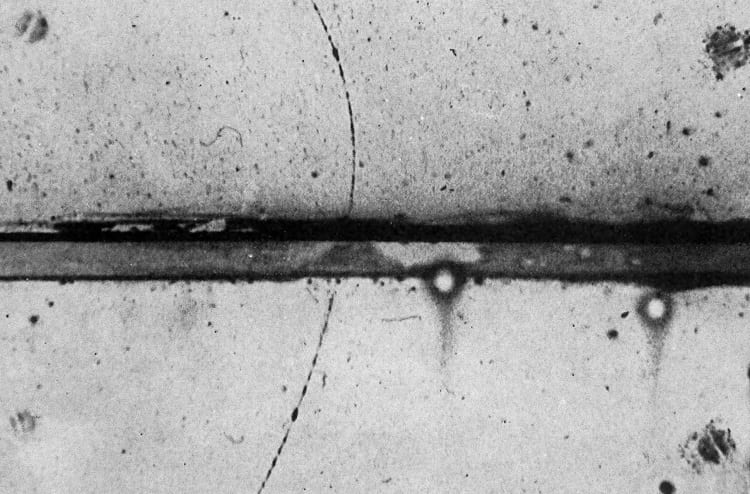
Antielectron, the antimatter counterpart of the electron. (Anderson, Carl D. / The Positive Electron)
Unlike me, if you ever paid attention in your science class, you would probably remember your teacher stating that ‘everything around us is made up of matter’. It’s true; literally everything from me to your cars to pins to the dog barking across the street, everything no matter how seemingly simple or complex it is, is made up of matter. However, matter isn’t the only thing that makes our universe. There is also matter’s ‘evil’ twin known as antimatter. The existence of antimatter was first claimed in research papers published by Paul Dirac from 1928 onwards. On 2nd August 1930, Carl Anderson successfully discovered antielectron or ‘positron.’
What is antimatter?
Antimatter is quite similar to matter. It has the same mass and structure of the matter. However, differences arise when we look at its configuration. For example, a hydrogen atom has a proton with a negatively charged electron revolving around it whereas; an atom of antihydrogen has an antiproton with a positron revolving around it. When matter and antimatter meet, it’s not a joyous reunion, rather the two counterparts neutralize each other and release energy in the process called ‘annihilation’.
If a kilogram of antimatter annihilates with a kilogram of matter, the energy released will be equivalent to that of the massive Soviet thermonuclear bomb ‘Tsar Bomba’, which was 1500 times more powerful than the combined power of bombs dropped at Hiroshima and Nagasaki (fat man and little boy). According to the physicists, the big bang that created our universe should have created both matter and antimatter in equal amount.
What happened to all the antimatter and why all we see around is matter?
The Center for European Nuclear Research (CERN) has tried to explain this asymmetry by saying that one in a billion particle of matter somehow managed to survive. With all these vague theories and the way logic comes in the way, it is hard to believe if ‘antimatter’ really exists. But, be assured, scientists have been able to create, store and study antimatter.
Scientists at Center for European Nuclear Research (CERN) have been successful in producing Antimatter atom using the famous ‘Large Hadron Collider.’ More intriguing is the way these particles are stored. Any antimatter particles would annihilate as soon as it hits matter and as result, the scientists at CERN use a magnet based trap named ‘Penning-Malmberg trap’ to trap and study antimatter atoms. Magnets are used to create a magnetic field that acts as a bathtub for the antimatter particle. This ‘magnetic field bathtub’ ensures that the antimatter particles do not hit the walls of the trap and annihilate.

Large Hadron Collider at CERN where antimatter was produced in a controlled environment. (Maximilien Brice / Wikimedia Commons)
Use of Antimatter
Antimatter is an extremely useful material. The PET scan is just short for Positron Emission Tomography scan. Millions of people go through PET scans every year. With further knowledge, we could be one day able to efficiently cure cancer. It also offers the possibility of being used in the nuclear reactors or power plants. For all those science-fiction enthusiasts out there, antimatter could possibly fuel our space crafts as they do in ‘Star Trek.’
In late 2009, antimatter triggered the biggest explosion we have ever witnessed. According to DailyGalaxy, a star of size more than 200 times our own was annihilated due to ‘runaway thermonuclear reactions triggered by gamma ray-driven antimatter production.’ The result? A blast, that was visible for months, releasing radioactive content fifty times our ‘Sun.’
The cost to produce antimatter
It has been about 90 years since the discovery of antimatter; however, the research is still in its baby steps. Antimatter seems deadly, able to destroy anything composed of matter, even human beings. However, don’t be scared of being annihilated. It is by far, the most costly material to produce. In fact, CERN has only been able to produce 10 nanograms of antimatter in total. 10 nanograms of antimatter are not even capable of even boiling a cup of tea. In 1999, NASA estimated the cost of producing one gram of antihydrogen atoms to cost about 62.5 billion dollars. In 2006, NASA again estimated the cost of producing 10 milligrams of positron, the minimum amount required to power a mission to Mars, to be 250 million dollars. Money is not the only restriction; CERN has claimed that with current technology in use, making a gram of antimatter would take us 100 billion years!
So any possible use of antimatter in any significant field would require a major technological breakthrough. While we still don’t know a lot about antimatter itself, scientists have been reported to find about a particle that is both, antimatter and matter. Physics theory has been implying the existence of ‘Majorana particle’, however, we have not been able to find them till date.
The laws of the physics are said to have a different effect on antimatter. Some scientists believe that the study of it could help us know how it ‘all’ began. Some people bestow their faith in the theory that there is a parallel universe made up of antimatter. More research is needed. But ‘possibly’, there might be an ‘anti-you’ reading an article about ‘matter.’ Who knows?
Enjoyed this article? Also, check out “Nauru: An 8 Square Mile Island That was Once the World’s Richest Country“.
Recommended Read:
Physics of the Impossible | By Michio Kaku
Fact Analysis:
STSTW Media strives to deliver accurate information through careful research. However, things can go wrong. If you find the above article inaccurate or biased, please let us know at [email protected].
RELATED
The post Why Does ‘Antimatter’ the Costliest Material to Produce Matters So Much? appeared first on .
]]>The post Biosphere 2: A Self-Sustaining Artificial Ecological System appeared first on .
]]>
Biosphere 2 campus. (Martijn Nijenhuis / Flickr)
The Earth is one amazing planet that is home to a variety of animals, birds, plants and organisms, which live harmoniously with each other. Various natural habitats are spread across all the continents that have their own peculiarity; for example, Antarctica is covered in snow, while Africa is known for its hot deserts. South America stands out for its wet Amazonian rainforests, while Europe is famous for its ancient human history. Wouldn’t you be surprised if we told you that a place called Biosphere 2 housed part of almost every section just mentioned, all under one roof?
Biosphere 2, Arizona
Biosphere 2, also dubbed as “Planet in a bottle” – a huge research facility located in Tucson, Arizona in the United States – is spread across a sprawling 40-acre campus, with at least 7 acres reserved for state-of-the-art research labs, administrative offices, classrooms, housing centres and conference halls. Built between the years 1987 and 1991 and named after the natural biosphere of the Earth, Biosphere 2 was originally constructed as an artificial, enclosed ecological system, which is considered to be the largest, completely self-sufficient, man-made structure to have ever been built.
With its very own coral reef-lined ocean, complete with a variety of fish, a tropical rainforest that had a wide range of trees, savanna grassland, mangroves, a fog desert and an agricultural system, the fully-sealed structure was built as a forerunner to an enclosed space colonization program, which unfortunately did not succeed eventually.

Ocean and coral reef inside Biosphere 2. (Martijn Nijenhuis / Flickr)
During the first experiment that lasted two years from 1991 to 1993, eight volunteers, including founding members Taber MacCallum and Jane Poynter, medical doctor Roy Walford, ecologist Mark Nelson and researchers Sally Silverstone, Abigail Alling, Linda Leigh and Mark Van Thillo, entered Biosphere 2 to test if humans could run their very own world, which had all the facilities at their beck and call. But sadly, the self-sufficient controversial mini-world ran into hot water as soon as the program began.

Another view of the ocean inside the Biosphere 2. (Windell Oskay / Flickr)
The mega glass and steel spaceframe structure, which had an inbuilt oxygen supply in the form of natural ecosystems that were designed inside, it worked like an airtight container with no supply of oxygen from the outside world. The best breeds of livestock were brought in from various parts of the world, which would help the artificial biosphere function similarly to the real one. Trees, to continuously provide oxygen to living things were planted, which would keep the massive bio-dome running smoothly. Special planning and construction techniques took care of the heating and cooling systems of the facility, while accurate engineering went into making sure the enormous glass house functioned perfectly. Despite the best of everything that went into the making of this self-contained world, there came a point when Biosphere 2 had become almost inhabitable, with volunteers desperately wanting to make it outside.
But what had actually gotten wrong?
While some call it a multi-million dollar glorious debacle, Biosphere 2’s failure was a result of a lot of significant technical flaws. Some months inside the facility and volunteers began noticing that oxygen levels had started to dip sharply. Although trees in the savanna and rainforests were taking in all the carbon dioxide from humans and animals, tiny microbes present in the soil in the marshlands were metabolizing and using up oxygen at such a fast rate that hardly anything was left for those on top of the chain. As a result, carbon dioxide was released in high quantities, which the trees couldn’t exchange so quickly. Later with unethical practices, oxygen was pumped in from outside sources, which no longer made Biosphere 2 a miniature self-contained world in the first place.
Also, one of the major reasons for the facility’s failure was the psychological problems that started to creep up between the crew members as days and months passed in isolation. The members were not trained professionals in specific fields and had to make decisions based on consensus. Another major factor was that since they were completely alienated from the outside world, they couldn’t get the expert technical advice they needed to run the biosphere all by themselves. The crew members were not agronomists, who despite bringing in best crop seeds for plantation and food, generate enough to sustain for a long period of time. Some “Biospherians” (as the crew called themselves) were also accused of sneaking into the outside world, citing emergency family issues and bringing back outside items for use, that put the entire Biosphere 2 scheme under heavy scrutiny.

The rain-forest section inside Biosphere 2. (Jesuiseduardo / Wikimedia Commons)
After the first test group returned with little success, a second 10-month-long mission with seven members onboard begun and a lot of technical flaws were rectified, hoping for accomplishment the second time round in 1994. But merely two months into it and the company – Space Biospheres Ventures – which owned and managed Biosphere 2, was dissolved and the mission was abruptly aborted within six months. In December of 1995, Colombia University took up the management of Biosphere 2 and ran it successfully for research purposes for 8 years until 2003, when it ran into legal issues. In 2005, the new owners, Decisions Investments Corporation, put the site up for sale for housing and retail reasons, until Arizona University acquired its ownership, management and research rights in the year 2007.

The savanna grassland section. (Martijn Nijenhuis / Flickr)
Currently, Biosphere 2 pulls in as many as twenty thousand visitors each year and aims at advanced research and understanding of global scientific issues. It also aims at researching more about the Earth and its future by ways of technical and methodological progress. But what remains towards the end is a major technical fiasco, which was originally intended to be a self-sustaining miniature version of the earth, eventually turning into one of the thousands of research facilities that run across the world. Thankfully, Biosphere 2 still remains the biggest artificial vivarium man has ever created.
Enjoyed this article? Also, check out “Amazon Spheres: An Unexpected Rainforest in the Amazon HQ at Seattle“.
Recommended Read:
Dreaming the Biosphere: The Theater of All Possibilities | By Rebecca Reider
Recommended Visit:
Biosphere 2 (Science Museum) | Arizona, USA
Fact Analysis:
STSTW Media strives to deliver accurate information through careful research. However, things can go wrong. If you find the above article inaccurate or biased, please let us know at [email protected].
RELATED
The post Biosphere 2: A Self-Sustaining Artificial Ecological System appeared first on .
]]>The post Dr. Robert E. Cornish’s Controversial Experiments to Revive a Dog’s Decapitated Head appeared first on .
]]>
Dr. Robert Cornish with one of the Lazarus pups. (Source: www.madscientistblog.ca)
Tales of Mad Scientists have been in existence for centuries now. And while many are criticized for being wacky, inhumane and downright psychopathic many can also be celebrated for making breakthroughs within various scientific fields. This is none more so than within the field of medicine where procedures today have origins from millennia ago; in medieval times and before them in prehistory. One such tale with a more modern spin comes from the 1930s in Berkley, California where an American called Robert Cornish attempted to bring the dead back to life.
Background of Dr Robert Cornish
Cornish was a medical phenomenon, graduating at 18 from the University of California and gaining a Doctorate at 22. He was a handsome chap but his eccentricity was soon apparent as one of his invention concept was a pair of spectacles to allow the reading of newspapers underwater. This may illustrate his intelligence; however as to gain a patent in those times was considered very noteworthy and could propel a person to fame. Cornish worked at the Department of Experimental Biology at a University when he began to get notoriety for something of a darker nature than underwater specs.
Revivification experiments
Dog-lovers read no further. Cornish began an experiment to cure the undead but not permitted to use human beings he had to operate on dogs. The doctor organized a public demonstration which Time magazine witnessed. He named his patients – five fox terriers – Lazarus after the mythical figure brought back to life by Jesus.
Robert Cornish tried many different techniques before gaining moderate success with the following. He would suffocate the animals first with either Nitrogen or ether. He would wait no more than five minutes after the heart had stopped to try and resuscitate. To do this he found a way to keep the blood circulating by using a piece of wood called a teeterboard, a type of see-saw to rock the patient up and down to maintain the circulation of blood.
Before re-animation, he would inject the creature with a concoction of saline, oxygen, adrenaline, blood as well as anti-coagulants and coagulants. Oxygen would be blown into the mouth via a rubber tube. Bear in mind this was in the 1950s when CPR and techniques of the sort were in their infancy meaning his methods were extremely right-field.
Outcome, criticism and dismissal
The first three dogs were revived but showed little signs of life after. The best result was Lazarus II who was in a coma for eight hours before passing again. The fourth dog – Lazarus IV – came back to life albeit blind and brain-damaged, Cornish reported that she recovered to near full strength in a matter of months. Lazarus V was the same but returned to normality in shorter time. These are the words of Doctor Cornish only however and were not confirmed by Time or anyone else it appears. Despite these factors, Cornish hailed his experiments a success.
The mad-cap doctor was heavily criticized and eventually fired from the UCLA Laboratory when protestations about the canine killings reached their ears. He was forced to do his experiments in the confines of his own abode and with pigs rather than dogs.
Attempts to secure fund and human subjects
Requiring funding Robert Cornish tried to clear his name by convincing people that his work was vital. This was through a movie titled ‘Life Returns’. Cornish played himself as does one of the Lazarus dogs. It uses a familiar aspect to pull at the heartstrings of the audience, with the doctor attempting to resurrect his son’s dead dog. It was the only way his son would love him again after all. The film was far from a success and ergo did nothing to improve the reputation of the doctor.
His next plan was to find a human patient. He searched the jails and found a willing convict called Thomas McMonigle, an inmate of San Quentin prison, convicted of killing a fourteen-year-old girl. The government declined the request on compassionate grounds. There is another rumour however which seems to be justified by newspaper reports from the time. This relates to the courts fearing a ‘double jeopardy’ clause. Death by the gas chamber which would have released the convict from his conviction and therefore he would have been a free man.
The experiments of Cornish continued and certainly will continue but at least now with more humane conditions we can hope. For it is a persistent quest of mankind to be eternal and although a scary thought it is one which will be pursued until completion. This is looking ever more likely and sooner rather than later with such incredible advances in medical science.
While Doctor Robert Cornish committed some very cruel acts can it be said that experiments like this are necessary in order to advance? To benefit the world in the long term? Is it worth the life of an animal, or a human to potentially increase the lifespan of another?
Enjoyed this article? Also, check out “Jose Delgado, the Pioneer of Electric Brain Stimulation Tamed a Raging Bull with Radio Control“.
Not Recommended Watch:
Life Returns (1935)
Fact Analysis:
STSTW Media strives to deliver accurate information through careful research. However, things can go wrong. If you find the above article inaccurate or biased, please let us know at [email protected].
RELATED
The post Dr. Robert E. Cornish’s Controversial Experiments to Revive a Dog’s Decapitated Head appeared first on .
]]>The post The Dvorak Technique: The System to Estimate the Intensity of Tropical Cyclones appeared first on .
]]>
Dvorak Technique: A chart demonstrating Dvorak-assigned intensities on common development pattern observed during a tropical cyclone. (Vernon F. Dvorak / NOAA)
As a critical, forecasting tool, the Dvorak technique is useful for monitoring and estimating the intensity of tropical cyclones, typhoons, and hurricanes. To get a fairly accurate measurement, weather forecasters refer to visible and infrared satellite images.
The Dvorak technique and its evolution
Vernon Dvorak developed the Dvorak technique between 1969 and 1984, using polar orbital satellite images of tropical cyclones from the Atlantic and the northwest Pacific Ocean. Initially, the technique consisted of systematically matching patterns of cloud features with a development and decay model. Over the years, the technique has improved further.
In the Dvorak technique, the common procedure is to find the center of a developing cyclone and assign it a primary developmental pattern associated with tropical cyclones like a curved band, a shear, a central dense overcoat, a central cold cover, a banding eye, and an eye. The next step is measuring the cloud features from satellite imagery and established guidelines.
By using infrared satellite imagery, weather forecasters are able to evaluate the strength of tropical cyclones with eyes in a more objective manner. They measure the temperatures at the top of the clouds in the eyewall and also the temperatures within the cyclone eye. They can then contrast and compare the two temperature measurements.
Along with defining the intensity of tropical cyclones, the measurements are used to find out what the central pressure is in the low-pressure area of the tropical cyclone. Weather forecasters have had to modify the central pressures that were previously assigned to tropical cyclones. This is because their estimated measurements turned out to be inaccurate. They were 5-10 hPa (0.15-0.29 inHg) too low in the Atlantic and up to 20 hPa (0.59 inHg) too high in the northwest Pacific. To resolve this inaccuracy, Atkinson and Holliday devised and developed an independent wind-pressure relationship for the northwest Pacific in 1975 and 1977.

The above image shows the development of tropical cyclone in five days. (Vernon F. Dvorak / Wikimedia Commons)
The cyclone intensity estimates that come from the statistical system are known T-numbers, and they range from T1 to T8 on the Dvorak scale of measurement, with one representing cyclones of minimum intensity and eight representing cyclones of maximum intensity. After assigning a T-number, weather forecasters may modify it to maintain continuity with past estimates. The final value they arrive at is known as current intensity or CI. The T-number and CI value is same for all cyclones except those that are weakening. For these, the CI value is higher than the T-number.
Nowadays, weather forecasters use constraints on short term intensity change less frequently than they did in the 1970s and 1980s.
The main issue with the initial Dvorak technique was that the human analysts that used it were prone to subjective biases and that led to inaccuracies in measurements. To ensure more objective estimates, weather forecasters now use more powerful computers, specialized computer programs, and higher-resolution satellite imagery. The computer-automated techniques use an averaging period of six hours, which takes into account the natural fluctuations of the satellite patterns of tropical cyclones. It is, thus, possible to get a more reliable estimate of the tropical cyclone intensity.
Weather forecasters first used the objective Dvorak technique in 1998 and found it worked best for measuring the intensity of tropical cyclones with eyes. Of course, since it was still necessary to manually detect the centre of the cyclone using subjective analysis, the technique wasn’t entirely objective.
A more advanced and objective Dvorak technique came about in 2004. In this, the weather forecasters began using banding features to find out the centre of a tropical cyclone. They also use them for cyclones that are below hurricane intensity.
Using the Dvorak technique
Cyclones that are similar in intensity tend to have certain similar characteristic features. Also, as they gain in strength, they have a tendency to change their appearance in a foreseeable way. The Dvorak technique utilizes these facts when monitoring the intensity of a developing cyclone.
To determine if a tropical cyclone is weakening, maintaining its intensity, or gaining in strength, the weather forecasters track its structure and organization for over 24 hours. They make note of various central cloud and banding features and compare these with models created from compiled data from infrared satellite images of visual patterns and intensity of storms.
In the case of cyclones with visible eye patterns, the weather forecasters may make use of any available infrared satellite imagery. They will note the respective temperatures of the cyclone eye and the cloud tops around it. The cyclone eye usually has a warmer temperature than that of the cloud tops. The difference between the warm temperature of the cyclone eye and the cold temperature of the cloud tops determines the intensity of the cyclone. For instance, if the temperature of the cloud tops is colder, the tropical cyclone will be of higher intensity.
According to the National Hurricane Centre, the CI value for six hours gives a reasonably accurate measurement of the intensity of a weakening tropical cyclone. As per the Dvorak technique, a tropical cyclone can vary in strength only up to 2.5 T-numbers in 24 hours.
Benefits of the Dvorak technique
In certain areas and under certain weather conditions, it is not possible to use aircraft reconnaissance to observe a developing tropical cyclone. Instead, weather forecasters can use the Dvorak technique to measure and get a reasonably accurate estimate of the intensity of maximum sustained winds. The measurement taken using the Dvorak technique is in the close neighbourhood of the measurement taken from an aircraft, within an eight kilometres per hour estimate.
Disadvantages of the Dvorak technique
The intensity measurements of tropical cyclones with moderate and weak strengths are less reliable.
While the Dvorak technique allows only 2.5 T-numbers per day, all tropical cyclones don’t necessarily adhere to this rule. Given that cyclones tend to fluctuate in strength, some may easily exceed the allowed 2.5 T-numbers.
The Dvorak technique is only applicable to tropical cyclones and is not effective in determining the intensity of subtropical cyclones. It also underestimates the intensities of cyclones that are losing their thunderstorm activity and undergoing extratropical transition.
The leading weather agencies that use the Dvorak technique to record the intensity of tropical cyclones include the Air Force Weather Agency, the Tropical Analysis and Forecast Branch of the National Hurricane Centre and the Joint Typhoon Warning Centre at the Hawaiian-based Naval Meteorology and Oceanography Command. The NOAA/NESDIS Satellite Analysis Branch also utilizes the Dvorak technique.
By monitoring developing tropical cyclones, typhoons, and hurricanes and providing authorities with information to take advanced action, the Dvorak technique has helped to save scores of lives in vulnerable regions.
Enjoyed this article? Also, check out “Radar Technology’s Early Detection System Revolutionised the World and Made it a Better Place to Live in“.
Fact Analysis:
STSTW Media strives to deliver accurate information through careful research. However, things can go wrong. If you find the above article inaccurate or biased, please let us know at [email protected].
RELATED
The post The Dvorak Technique: The System to Estimate the Intensity of Tropical Cyclones appeared first on .
]]>The post The Unknown Fate of Einstein’s Stolen Brain appeared first on .
]]>
Segments of Einstein’s Brain in Mütter Museum. (The Mütter Museum Of The College Of Physicians Of Philadelphia)
Albert Einstein, the renowned scientist who formulated several theories that are crucial in the field of science perished on April 18, 1955, in Princeton Hospital. One would imagine the curiosity of scientists all across the world to have a closer look at the brain of a genius. However, one person named Thomas Harvey took this matter into his own hands. Thomas was the pathologist on duty the day Einstein expired. He took full advantage of his position and stole Einstein’s brain.
Whether or not Einstein wanted his brain to be studied after his death still remains a mystery. Regardless, Thomas Harvey preserved bits and pieces of his brain for several years and passed some on to his fellow pathologists. According to Brian Burrell, author of the book “Postcards from the Brain Museum” Thomas obtained a “retroactive and reluctant blessing” from his son Hans Albert. After he moved from Princeton Hospital to Philadelphia, Thomas preserved the 240 pieces of the brain which he carved out in celloidin, another form of cellulose and put these pieces into two jars and placed them in the basement of his house.
Thomas’s wife was not too pleased with someone’s brain being stored in their basement and pressurized him to discard it, which forced him to carry the pieces along with him to the Midwest. While he worked in Wichita, Kansas he placed the brain in a cider container and kept it beneath the beer cooler. His career tumbled and he moved to Missouri and lost his medical license following his failure in competency examinations in 1988. He finally settled in Lawrence, Kansas, where he worked in an assembly-line job in a factory of plastic-extrusion, all the while sending bits and pieces of Einstein’s brain to researchers all over the world.

Elbert Einstein in 1921. (Ferdinand Schmutzer / Wikimedia Commons)
Research and findings
True to Thomas’s intentions, researchers across the world worked on Einstein’s brain and published several papers. In 1985, Thomas, with his California collaborators, published a paper claiming that his brain had unusual amounts of two types of cell structures, namely neurons, and glia. Some other scientists refute those claims. That study was followed by five more similar studies, with one being published as recently as April 2014, which are considered to be flawed in a number of ways by a fraction of scientists.
Author Brian Burrell in his book studies the brains of famous personalities including Einstein, Lenin, and Walt Whitman. He remarked that nothing of scientific value came out from the study of Einstein’s brain, rather it became something that Einstein himself was terrified: a pop-culture icon. Thomas stole Einstein’s brain without his prior permission compromising Einstein’s dignity and did not follow what were said to be specific instructions given by Einstein about his remains; cremate them and scatter the ashes in secret.
It may be argued that Einstein wanted to discourage his idolaters with that move. Perhaps Thomas was inspired by Oskar Vogt’s study of Lenin’s brain, yet it must be noted that he had no expertise in understanding a brain. All his life after the incident had shades of a media circus.
The fate of Einstein’s brain
In 1997 Thomas embarked on a cross-country road trip with a freelance magazine writer called Michael Paterniti in a quest to meet Einstein’s granddaughter. They met her and intended to leave the brain with her. When she disclosed that she didn’t want it, they tried to leave the brain accidentally. Finally, the brain and the two men parted ways and the brain ended up in the lab where it all started some 40 years ago. Michael, however, published a book called “A drive with Mr. Albert”.
One of the largest collections of his brain is available at the Mutter Museum, Philadelphia to be seen by the public. But, Einstein’s brain isn’t the only organ that has been preserved. Dr. Henry Abrams, Einstein’s optometrist, is believed to have taken the possession of Einstein’s eyes from Dr. Thomas. It is considered that his eyes are sealed up in an NYC Safety Deposit case. Abrams asserts that the eyes will never be sold, whenever the talk of an auction gains mileage.
Enjoyed this article? Also, check out “Trepanation: Unusual Medical Procedure of Drilling Hole in the Skull“.
Recommended Read:
1. Einstein: His Life and Universe | By Walter Isaacson
2. Moonwalking with Einstein: The Art and Science of Remembering Everything | By Joshua Foer
Recommended Watch:
Inside Einstein’s Mind: The Enigma of Space and Time (2015) | BBC
Recommended Visit:
Mütter Museum | Philadelphia, USA
Fact Analysis:
STSTW Media strives to deliver accurate information through careful research. However, things can go wrong. If you find the above article inaccurate or biased, please let us know at [email protected].
RELATED
The post The Unknown Fate of Einstein’s Stolen Brain appeared first on .
]]>



